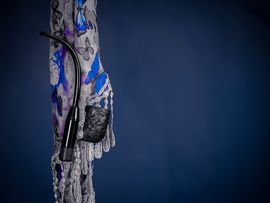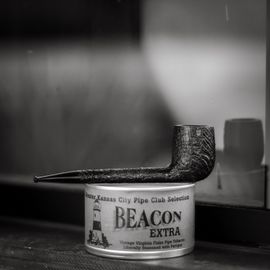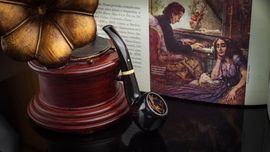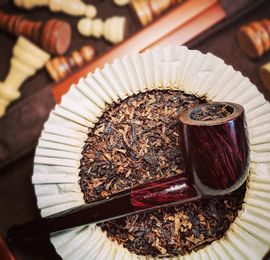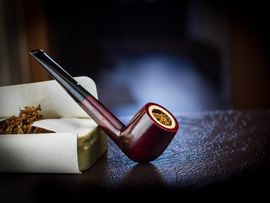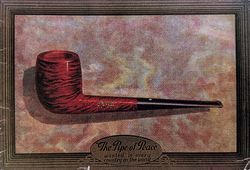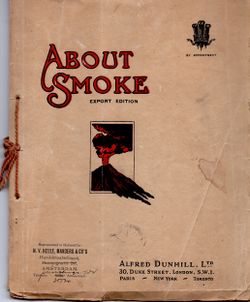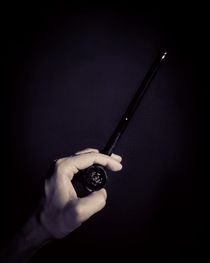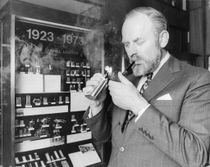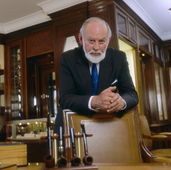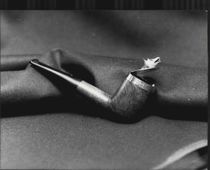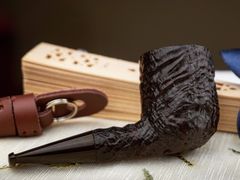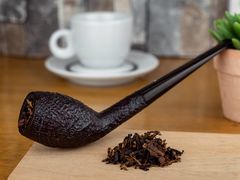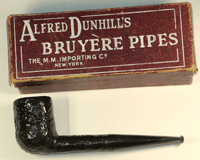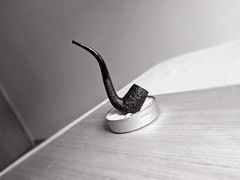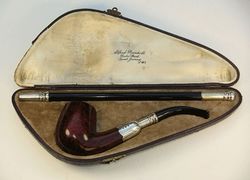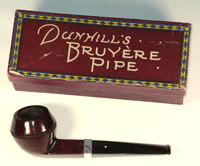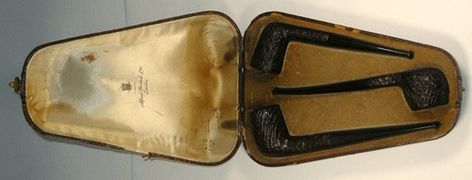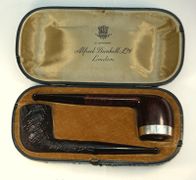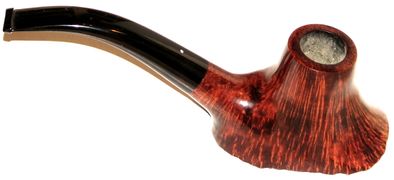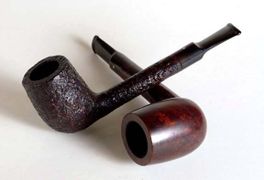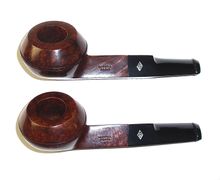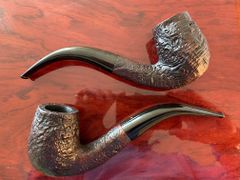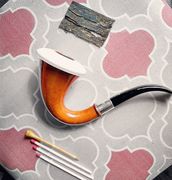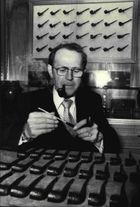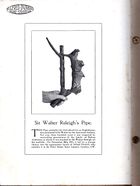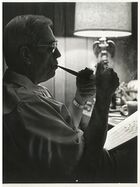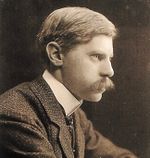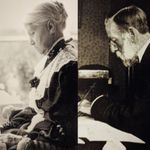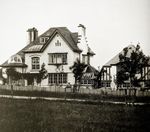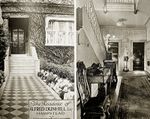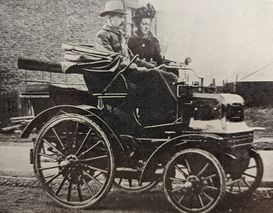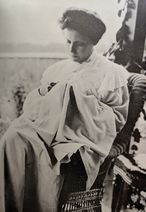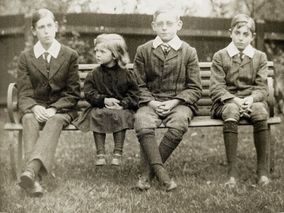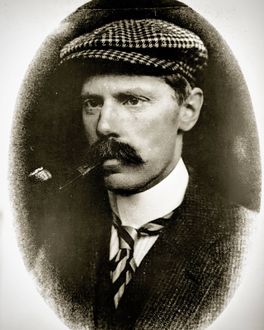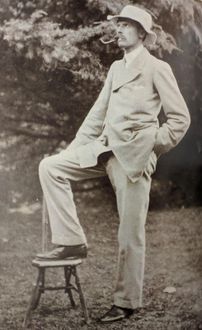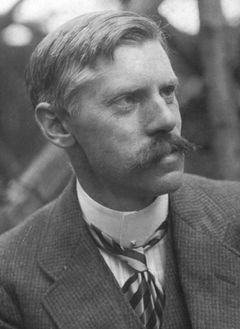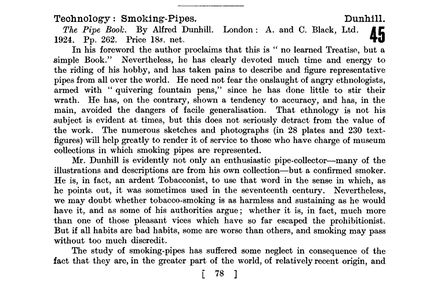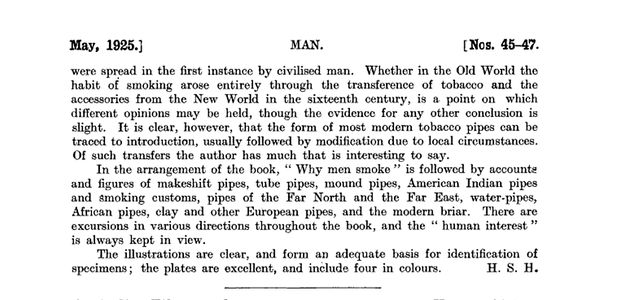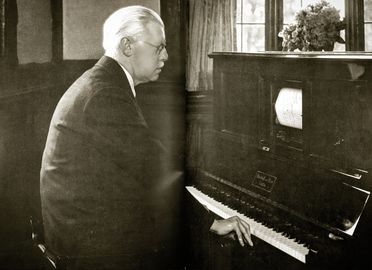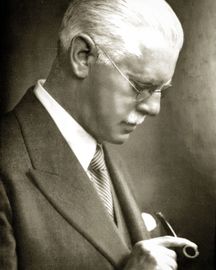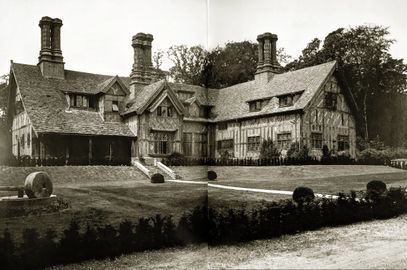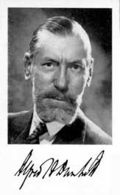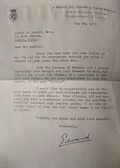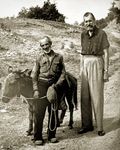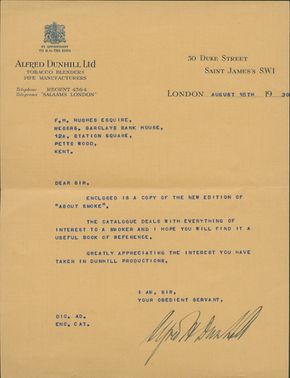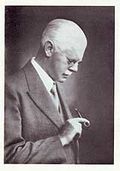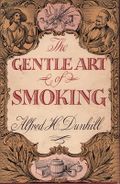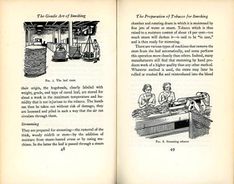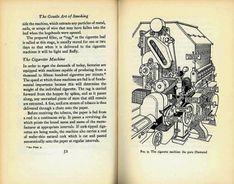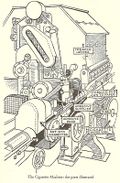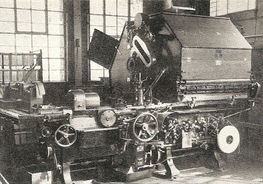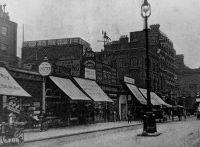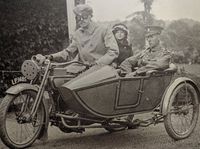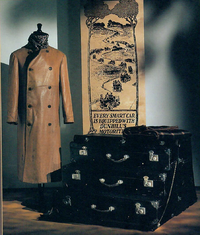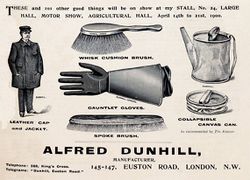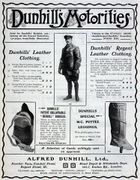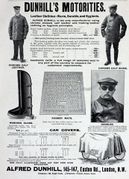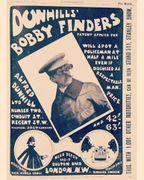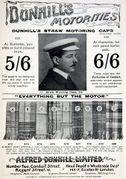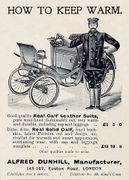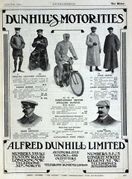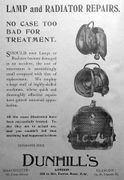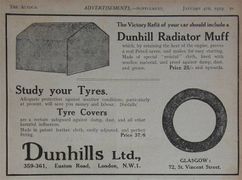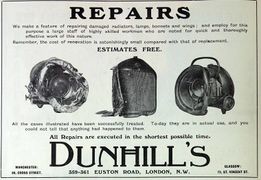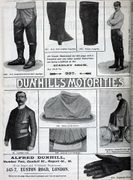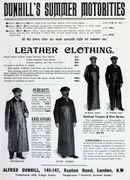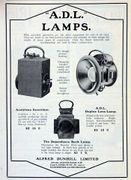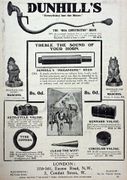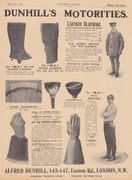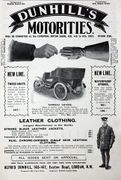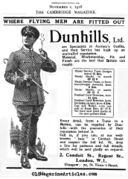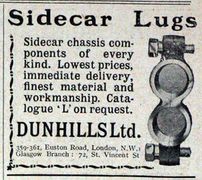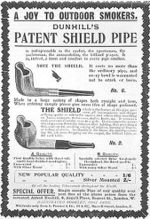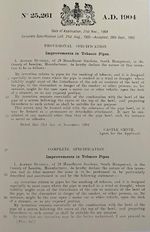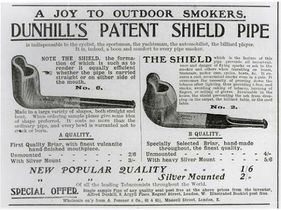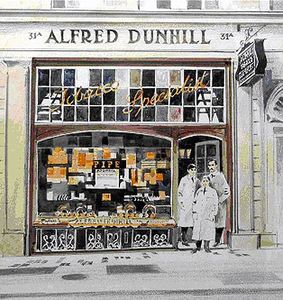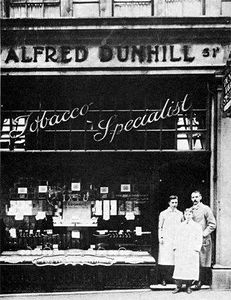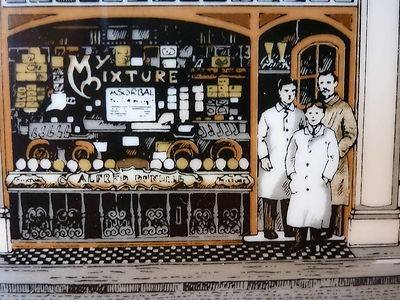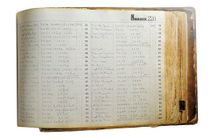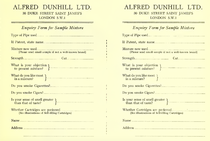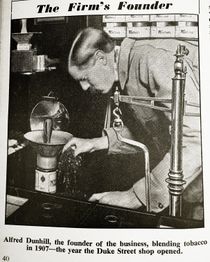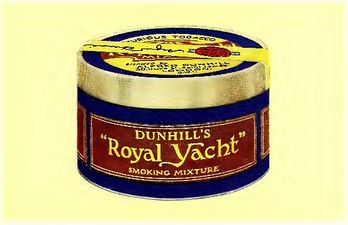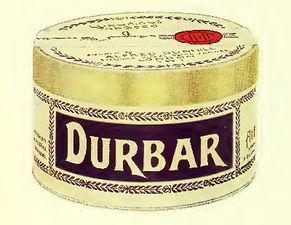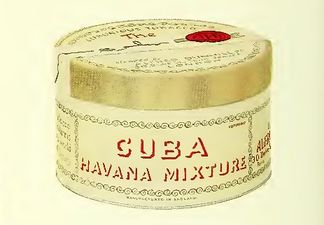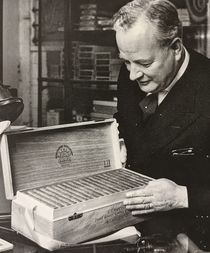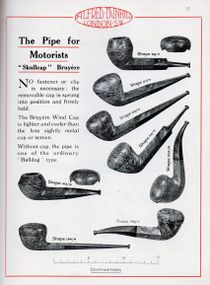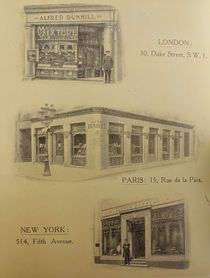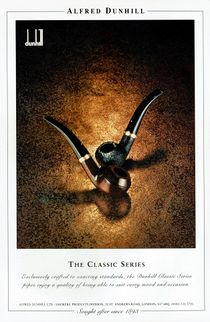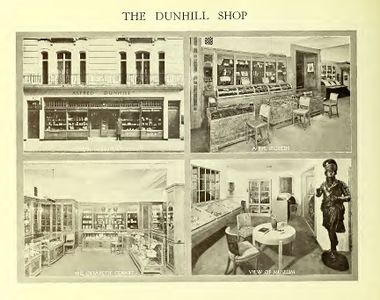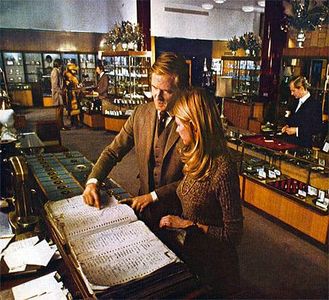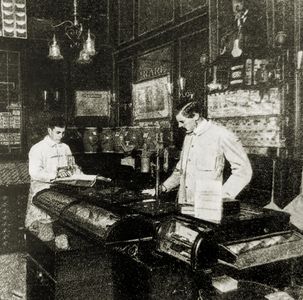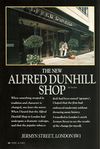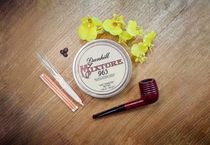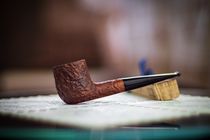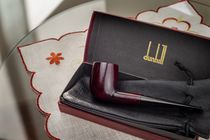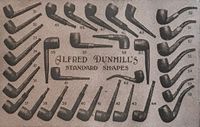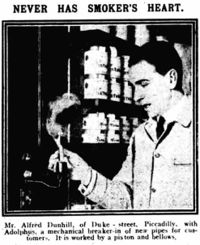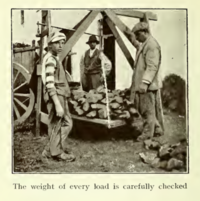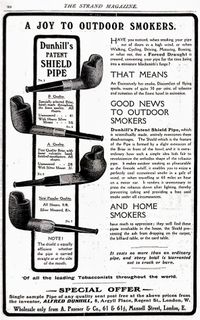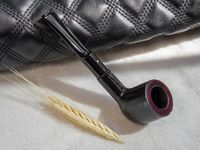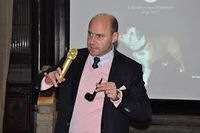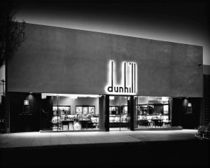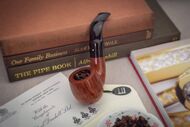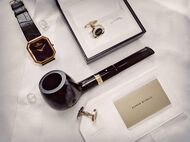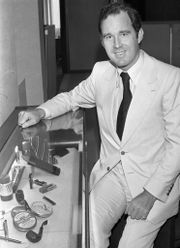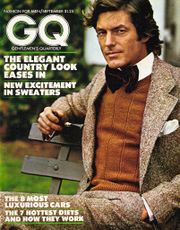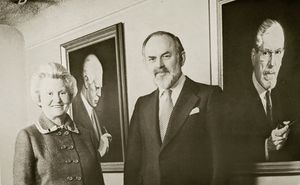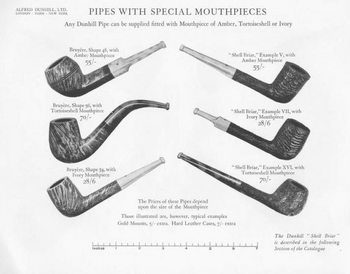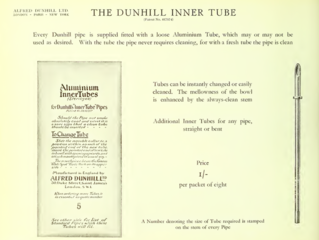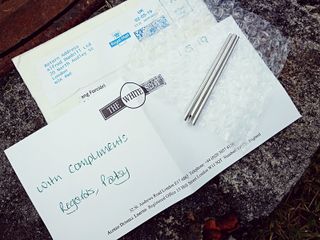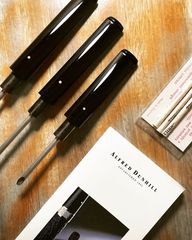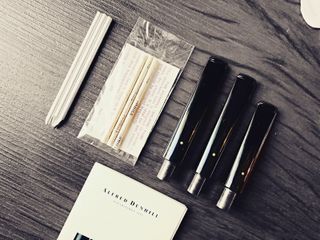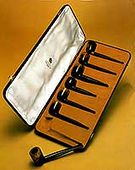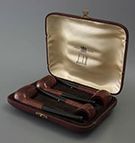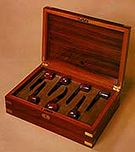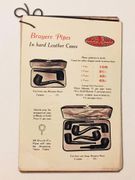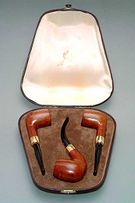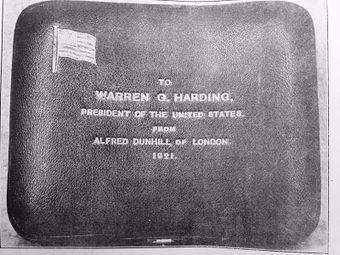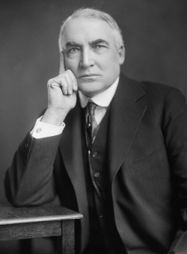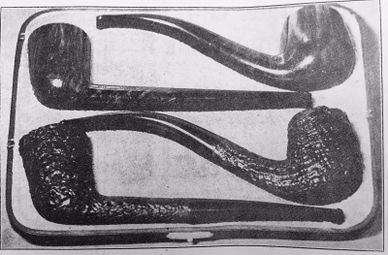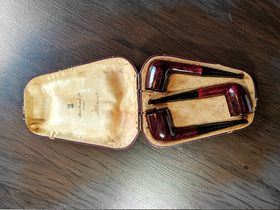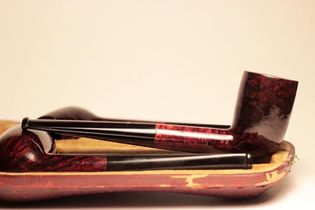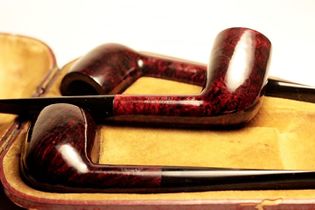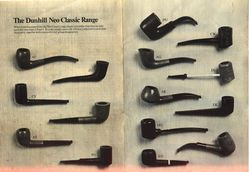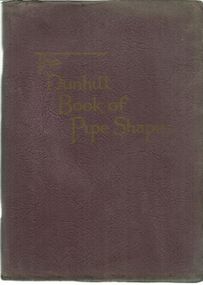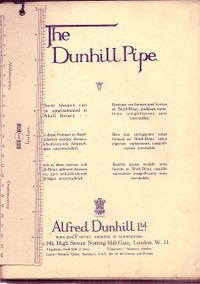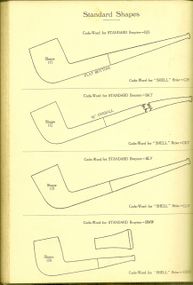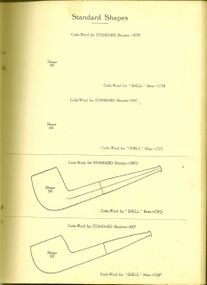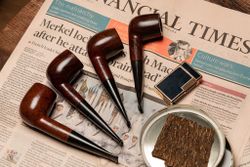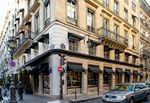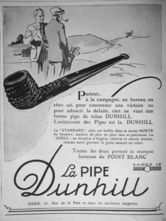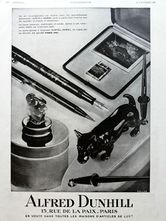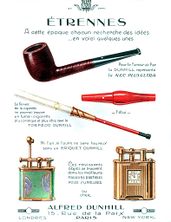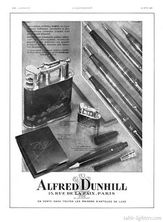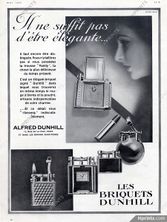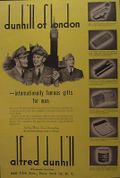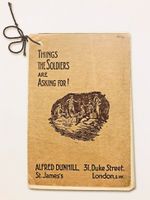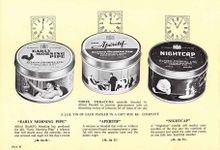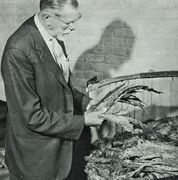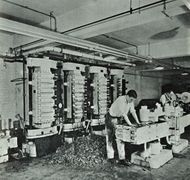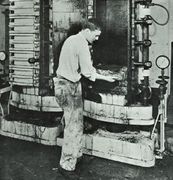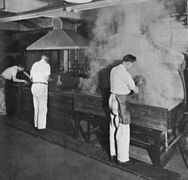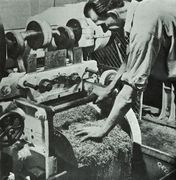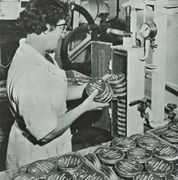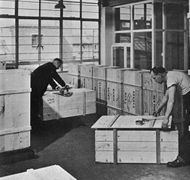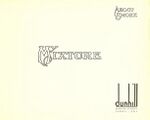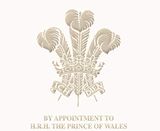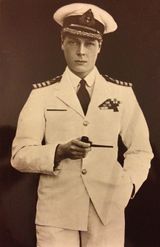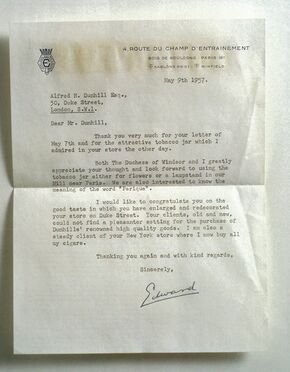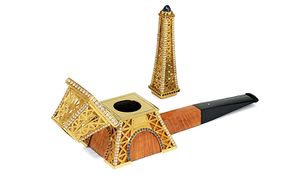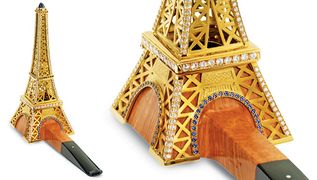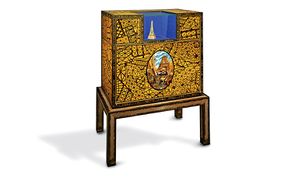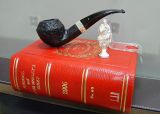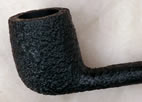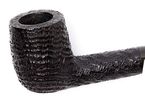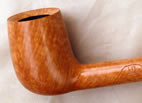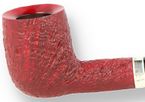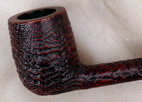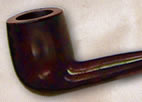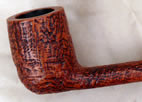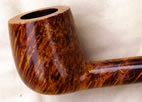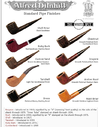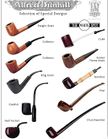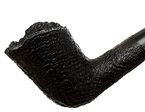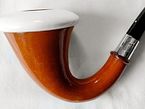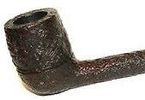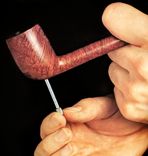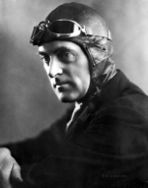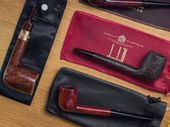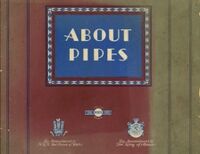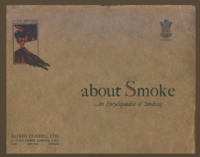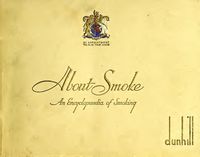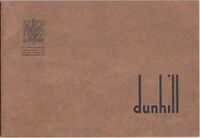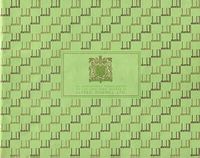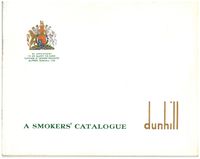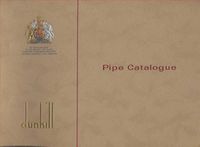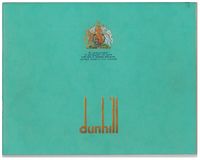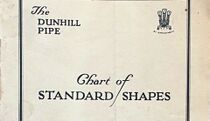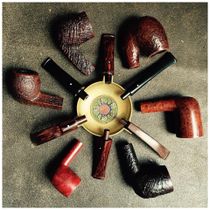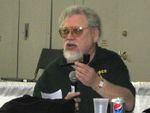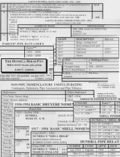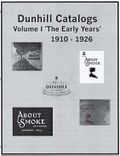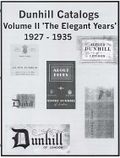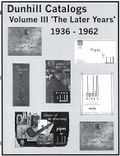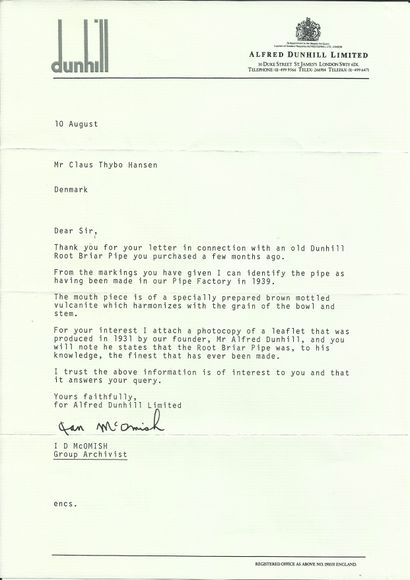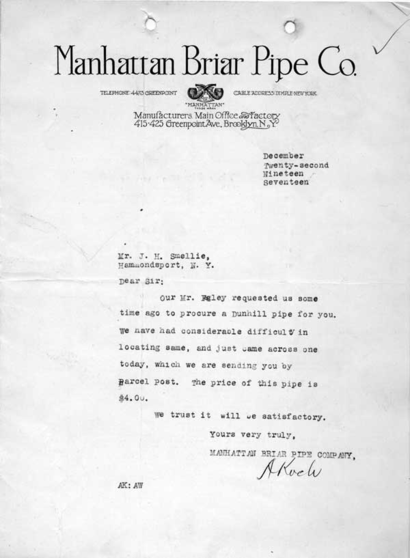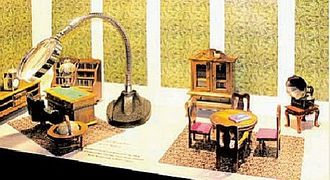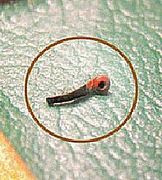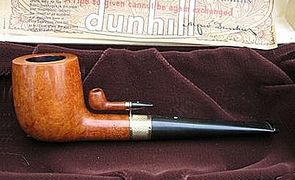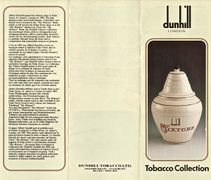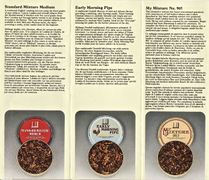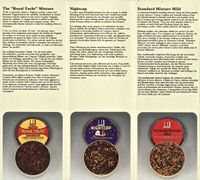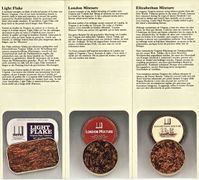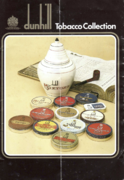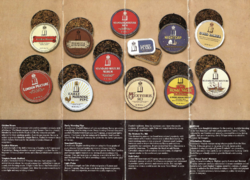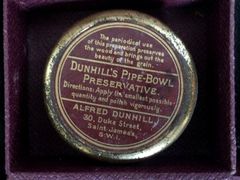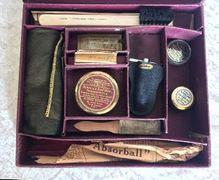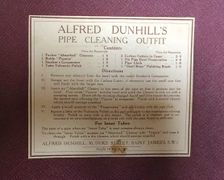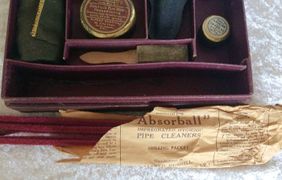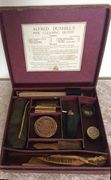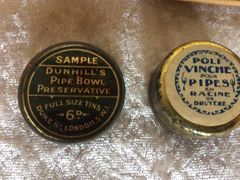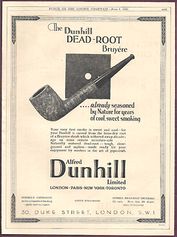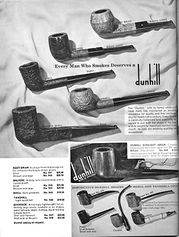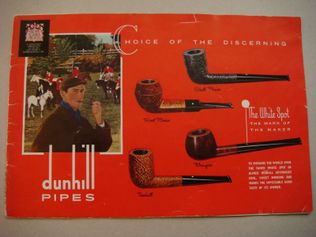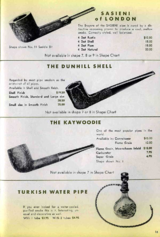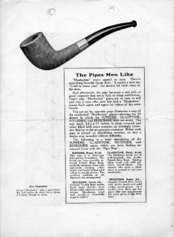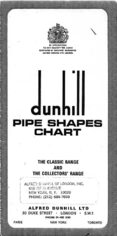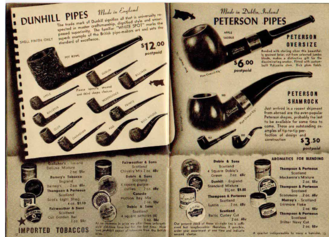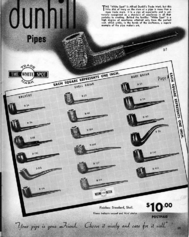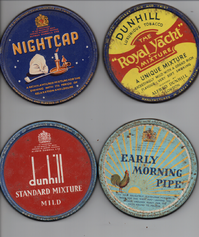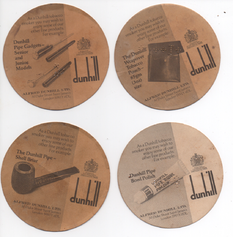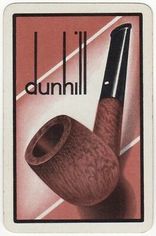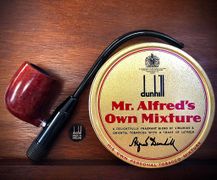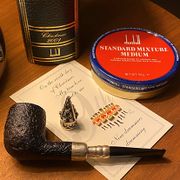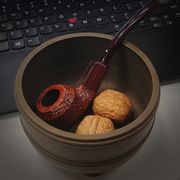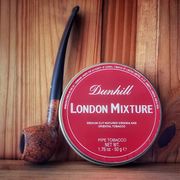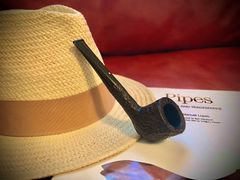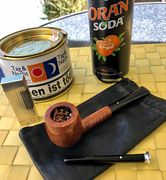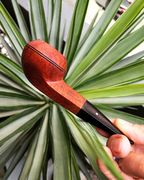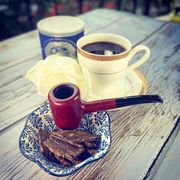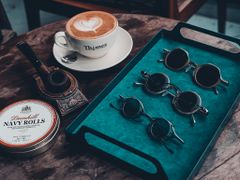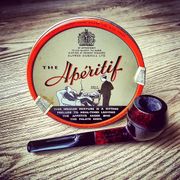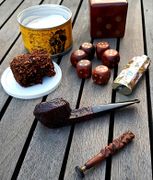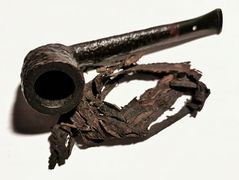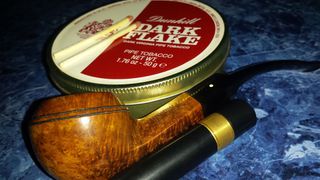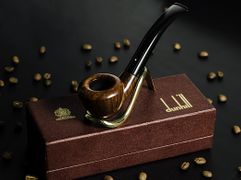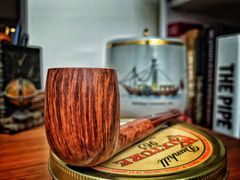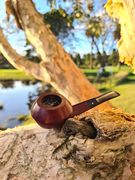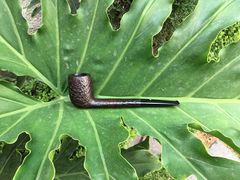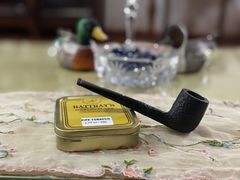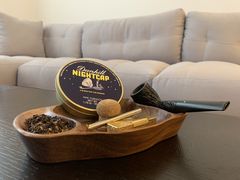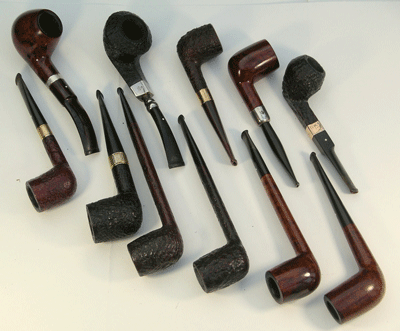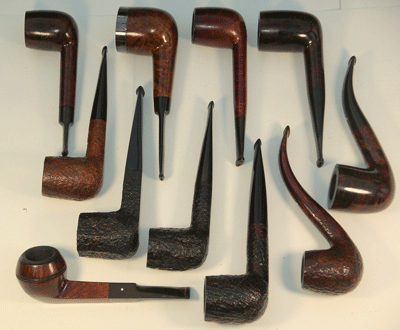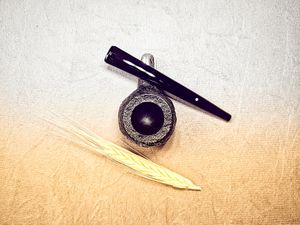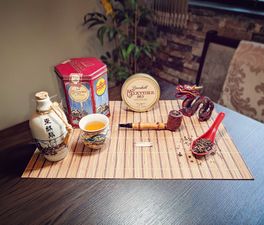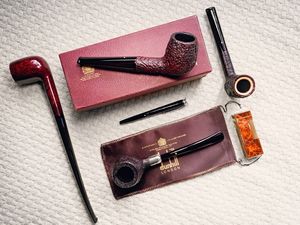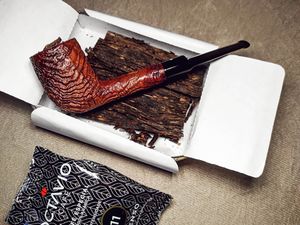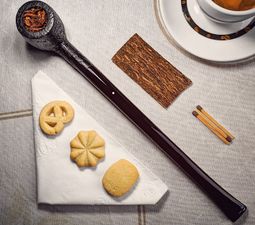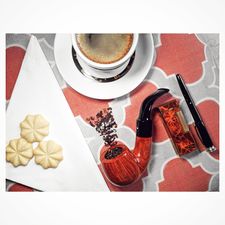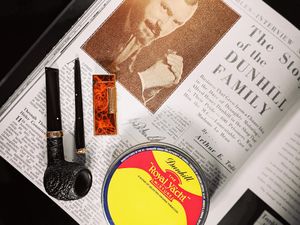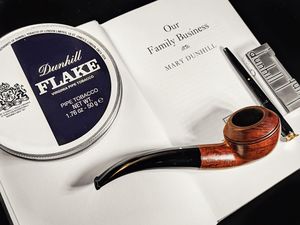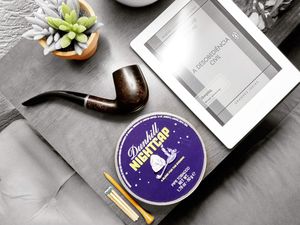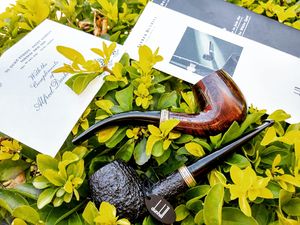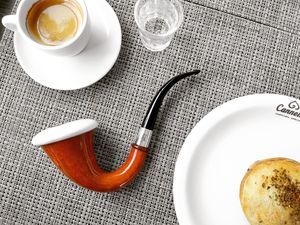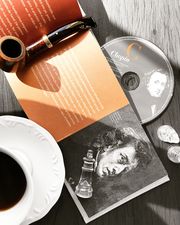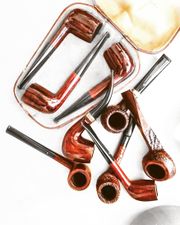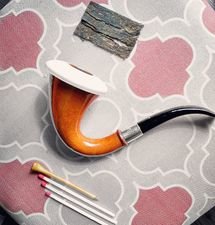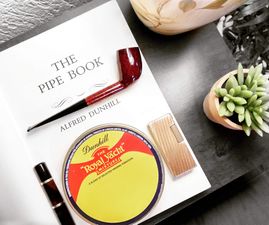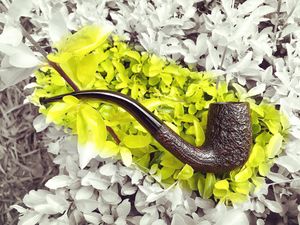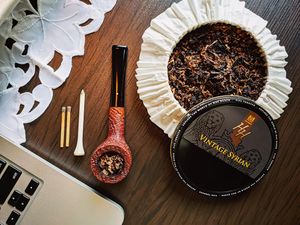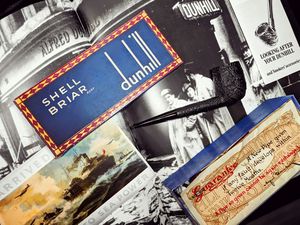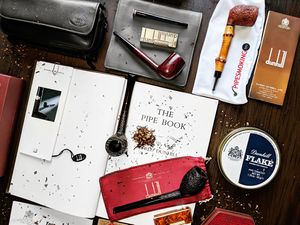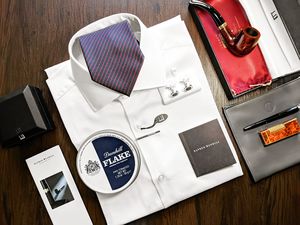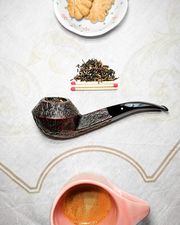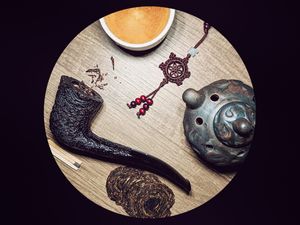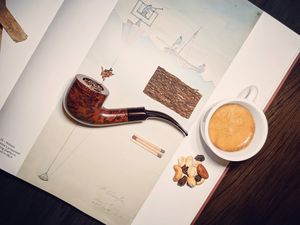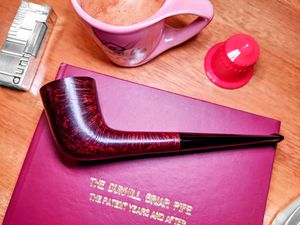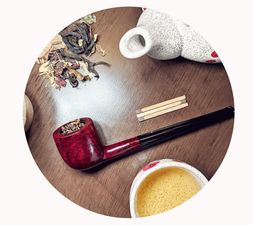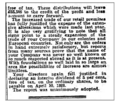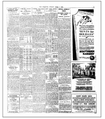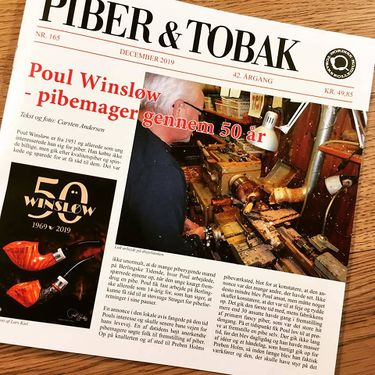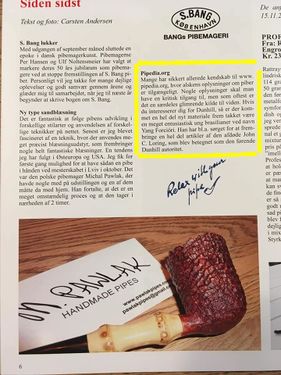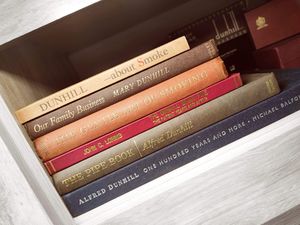Dunhill
Alfred Dunhill Pipes This is a work in progress. Please feel free to contribute if you are a Dunhill expert or knowledgeable enthusiast.
Introduction
For the everyday smoke what more is there to say than this, that it is, in its essence the Pipe of Peace? This idea we find embodied in the folklore of simple peoples one example of which is the story taken down by Mr. Torday, the eminent anthropologist, from the lips of Bilumbu, an old Bushongo savage in the remote Congo village of Misumba, and quoted in “The Pipe Book” of Alfred Dunhill.
According to this tale an adventurous young Bushongo named Lusana Lumunbala had fared forth into the outer World and was lost to his tribe for many years. He returned suddenly and after much feasting, he was asked what treasures he had found.
The traveler searched in his bag and produced from it some dried leaves of tobacco and a little packet of seeds.
“Men of Bushongo,” he said solemnly, “thank me from the bottom of your hearts, for I have brought you this.”
The elders passed the leaves from hand to hand and shook their heads; one of them said sternly:
“Do you think, Lusana Lumunbala, that this is the time for jesting? What good is this weed to us?”
“I fear” said another mockingly, “that this man has not gained anything by his much-vaunted travels, and that the hardships which they have entailed have made him lose something...” And he tapped his head significantly.
Lusana Lumunbala smiled. “I have not lost my reason, O elders of Misumba, for this weed of which I have brought you a sample is very precious indeed.”
“Is it good to eat? ”
“It is not.”
“Is it a remedy for some sickness?”
“It soothes them all. Its smoke, when inhaled, is to the suffering soul as a mother’s caress to an ailing child.”
Saying so, he took a pipe out of his bag, filled it with a little tobacco, kindled it with some embers, and began to smoke, and as he did so his countenance beamed with happiness.
The elders talked all at once: “Surely our brother has become demented; he now earth fire and drinketh smoke.”
But one of them, more courageous than the others, asked him to let him try this Wonderful weed and taking the pipe inhaled a big whiff of smoke. He was taken with a violent fit of choking and fell to the ground gasping for breath. When he recovered he abused the traveler, and threatened him with his fist.
“You are,” Lusana Lumunbala rebuked him, “like an infant who chokes at the first mouthful of solid food his mother gives him, and yet, as he grows accustomed to it, becomes a brave companion at the trencher. You were too greedy. Little by little one filleth the basket, as the proverb says. You ought to have tried a little; if you do this you will soon enjoy the magic effect of the smoke as much as I do. For this weed, called Makaya (tobacco), is man’s greatest joy. I have learned its use in the land of Pende, whose inhabitants, the Tupende, have learned it from a strange people coming from beyond the saltwater. O Makaya, Makaya, what Wonders you can Work!” And Lusana Lumunbala shut his eyes in ecstasy. “As the fire will soften iron, so Makaya will soften the heart. If one day your brother has wronged you, and the blood rushes to your head in anger, and you reach out for your bow and arrows to slay him - take your pipe and smoke. Your ire will fly before its fragrance. You will say, ‘Surely I must not slay the son of my mother, him who is of my own blood. I will beat him with a big stick to teach him a lesson.’ But as you rise to fetch your cudgel, take your pipe and drink its smoke. And half-ways you will stop, and smile and say, ‘No, I cannot beat my brother, the companion of my youth. It is more becoming that I should scold him - lash him with bitter words instead of smiting him with a stick.’ And as you go to do so, smoke, smoke. And with every whiff, your heart will become more charitable and forgiving, and as you come up to the trembling culprit you will throw your arms around his neck and say: ‘Brother, brother, let bygones be bygones; come to my hut, and let us drink and eat together and be merry, and love each other.’”
“And all of you know,” concluded Bilumbu, “that Lusana Lumunbala spoke the truth; whenever your heart rises in wrath or sinks in sorrow, drink the smoke of Makaya, and peace and happiness will reign in it again.” About Smoke. [1]
While there are many opinions on who makes, or who made the best pipes, few would argue against Dunhill being the most recognized pipe brand, or that the founder, Alfred Dunhill, was not a marketing genius. In the preface to the second reprint of Dunhill's About Smoke, An Encyclopedia of Smoking", publisher Gary Schrier states the following:
What Alfred Dunhill--son of a leather-harness and canvas-tarpaulin maker--created in 1907 when he opened his first tobacconist shop in Duke Street, London, was something extraordinary: he set a new standard for smoker's products of the finest quality, and he forged a new hallmark for exemplary customer service.
The forward of the original About Smoke includes the following:
Smoking is undoubtedly a pleasure of the senses, primarily of taste and smell, but secondarily of sight and touch. For the highest enjoyment, therefore, it is essential to use objects which delight the senses.
All of the many Dunhill inventions prove that practicability is readily allied with artistic design.
Each Dunhill patent has been evolved to meet some expressed or anticipated need, but in the production of the article itself the beauty of form and coloring have certainly not been neglected.
In the fashioning of every article, the highest possible standard of design and workmanship has been maintained.
As with most any famous persons, articles, or firms, a good deal of lore and myth combine with no little speculation and make it difficult to separate facts from myth. It can also be difficult to separate true quality from the marketing genius behind a famous brand such as Dunhill. In this article, we attempt to navigate this, or at least give an indication of the challenges for readers to use their best judgment in discerning the merits of the information.
What follows is our revised and expanded article on the most recognized pipe brand. Many thanks to Yang Forcióri who has done the vast majority of the work on this extensive revision. --sethile (talk) 20:50, 7 August 2019 (CDT)
Some Rarities
History
Pipe Smoking Competition
Mr. Colin Crow, manager of the Dunhill Shop, preparing the 33 identical pipes for the contest, testing one as he does so. Mr. Crow is also a judge in the contest. The Dunhill Pipe Smoking Competition gets underway at City Tattersalls this coming Wednesday night, 30th Oct. 33 people including three ladies will take part in the competition in teams of three. The pipes, all same size will be given to each competitor. They are competing for several prizes, the 1st being a Root Briar pipe valued at $1,500 with a gold windshield. October 29, 1980. Sydney - Australia.
Sir Walter Raleigh's Pipe & Alfred Dunhill.
This Pipe, probably the first owned by an Englishman, was presented to Sir Walter by the American Indians. For over three hundred years it was treasured by succeeding generations of the family of Bishop Andrewes, to whom it was handed by Sir Walter Raleigh on the scaffold. On November 28th, 1911, it fell by a strange chance into the appropriate hands of Alfred Dunhill, who exhibits it at 30, Duke Street, Saint James's, London, S.W.
Mr. Edsel James was in the first generation of serious (pre-Loring) Dunhill collectors. Edsel James was not simply a pipe collector or a salesman, he was an endearing anachronism and reminder of a different time in our cultural history, Known by many affectionate aliases such as Mr. Dunhill, a curmudgeon, Captain Dot Head, and just plain ole Edsel, he was a unique character in an industry in dire need of such. A fellow pipe smoker who has spent the better part of his life both enjoying and promoting our wonderful hobby.[4] See more about it here and here.
The Men Behind the Curtains
Alfred Dunhill
Alfred was born on September 30, 1872, in the Haringey neighborhood, part of the suburban district of Hornsey, north of London. Alfred was the third of five children born to Henry Dunhill (1842-1901) and Jane Styles (1843-1922), his first cousin.
Grandma always contended that he couldn't go to school until he was about eight because he couldn't talk properly. As she also said that he was too far troublesome a child to be left in anyone's care, I conclude that his restless temperament asserted itself at an early age. At any rate, by the time he was fifteen, Father was a tall, thin boy with a quick intelligence, though poor sight (and a late start) prevented him from achieving any distinction at school and from being much of a reader for the rest of his life. Henry spent all his spare money on the education of his younger sons. The truth is that Father, at fifteen, was itching to get down to a practical job of work. The school classroom, he often contended, was simply not for him.Mary Dunhill. [5]
Sadly there is little information on Alfred's early life predating his entrance to the family business. There are sparse information and almost no reliable references. In particular, we have a quote in a column named "Mr. A. Dunhill " in The New York Times[6] which reports this:
Alfred Dunhill was educated at a private school in Hampstead and assisted by tutors until age 15. At 16, he becomes an apprentice in his father's horse-drawn business.
Two years after the start of his professional career, in 1895, Alfred marries Alice Mary Stapleton (1874-1945). His first son, Alfred Henry was born a year later, in 1896. Vernon was born in 1897, John in 1899, and Mary in 1906.
With great energy and creativity, Alfred was also involved in building construction in mid-1902[7], concurrently with the motor business, and in 1905, after he sold his interest in Dunhill's Motorities, he opens a company to develop patents, the "Alfred Dunhill's Patent Development Company, so that he could save fees on other ideas he might have (the offices were at 8 Argyll Place, east of Regent Street - a few doors away from the National Skating Palace)[8]. At the end of 1906, he was forced to leave this project to direct his energies to the growing demands of the tobacconist.
Alfred was fascinated by architecture and design and submitted his houses (in the city and the countryside) to frequent changes during his retirement. He also looked into the possibility of investing in the sweets and toy businesses but did not have a chance to pursue them.
(...) my father had moved from London in order to build houses in what was then a small Buckinghamshire village. Although he knew little about the building trade, this was one of several commercial ventures he packed into the first thirty years of his life. The point behind this one was that the new railway line from Marylebone to Aylesbury had already passed through the village, its hourly trains making it possible for more prosperous commuters to move into deeper country. As they were likely to need better houses than Great Missenden could provide, my father bought a few acres of land close to the station, made a deal with a local builder to put up half a dozen fairly conventional houses to his design, took the first of them for himself and, over the next couple of years, sold the lot. As part of a larger Great Missenden, those houses are still standing. Yet I am fairly sure that, when the profit on the cost of houses at that time had been split, my father made little money from the venture. It was not one of his more imaginative enterprises, though it illustrates his readiness to speculate on an idea he believed in.Our Family Business.[9]
After much work and dedication, the first version of his book, "The Pipe Book" was published in 1924 (the same year as the 5th edition of "About Smoke"). The Pipe Book contained 262 pages in its first version, it suffered a decrease to 207 pages in the revision of 1969, although with the addition of the preface by Alfred H. Dunhill. It's a real treatise on the history of the pipes. Illustrated with 228 drawings, 30 photographs, and 3 maps containing detailed descriptions.
On November 23 (in the same year of the release), a column in The New York Times[11] congratulated Alfred Dunhill for making the pipe "a gentlemanly art". Alfred was also elected a member of the Royal Society of Arts in 1925 as a consequence of this work. The book has been available for several years in several versions. It was printed by several publishers over the years (1924 – 2011), varying between coloured or black-and-white versions, simple or sophisticated.
Critics, disarm! And ye, Antiquarians, Archaeologists, Ethnographers, Ethnologists, et hoc genus omne, hold back in their leashes your quivering Fountain-pens! For this is no learned Treatise, but a simple Book, and written thus. Glancing idly one day along the stout row of his Hobby-horses, Which were munching quietly in their stalls, the Author spied a Newcomer, stabled there seemingly by Chance the night before. And casting his leg across it, he rode his new Hobby afar into the countryside and into Lands unknown. There did he learn and see many Things, Which afterwards he wrote and drew in this Book. To the many, learned and simple, Who, as he rode, told the Author this and that about his Hobby that he knew not before, he hereby tenders his most grateful thanks.
Give a man a book he can read,
And his home is bright with a calm delight,
Though the room be poor indeed.
Alfred retired in 1928, at the age of 56, due to health concerns[13] (there are no historical details on his possible afflictions). During his retirement, he spent most of his time in his cottage, titled "The Old Barn". He loved the sea, sailing, and fishing on the coast of Sussex on his motor yacht, Poppy, where he enjoyed hours of pleasure and relaxation. He liked music, too, and was reportedly an excellent pianist. Alfred Henry thus turns the protagonist, leaving the Dunhill company to go on without him while enjoying a seemingly private retirement. Alfred Dunhill died in a nursing home in Worthing on January 2, 1959[14], and was cremated at Golders Green Crematorium.[15]
Alfred Henry Dunhill
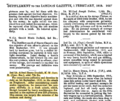
In a small house in Cricklewood Alfred Henry was born in 1896.
The Alfred's Dunhill firstborn. A tall and stately man, that became Chairman of the company on his father's retirement in 1928 - a post he held for 33 years.
- was a thin lad of seventeen when he first went to work at Duke Street, quiet and shy like Father but
with a sense of humor and a dry wit that endeared him to his colleagues.
Mary Dunhill.[16]
In 1912 Alfred H. Dunhill joined the business and began his journey in the company as an apprentice (then at the age of 16) but, in 1914 the First World War began and Alfred Henry Dunhill leaves the business and joins the war effort. in 1918 Alfred Henry Dunhill won the Military Cross (MC at Frégicourt 1 Sep 1918 - 31158/1 Feb 1919[17]) during the Battle of the Somme. He entered as a private and was discharged at the end of the war with the rank of captain. He was decorated with Military Cross, a third-level military award awarded to officers and squares of the British armed forces. He resumes its position in the company in 1919.
"Alfred Henry, who was just over eighteen when war was declared, came home one day in the summer of 1914 in the uniform of a Private in the Queen's Royal Regiment. I remember that the tunic was much too short for his lanky body and that, before he kissed me goodbye, he showed me how he wound on his puttees. We didn’t see him again until he returned on leave after several weeks in the front-line trenches without once having the chance of taking his boots off. I screamed when he showed us the lice wriggling in the seams of that tunic with its short sleeves. Mother, I remember, made him strip in the garden, taking the uniform into the kitchen where she baked it in the oven.
The telegram from the War Office Mother had been dreading for four years arrived on Armistice Day. Alfred Henry had been wounded and was being brought back to Bethnal Green where a workhouse had been converted into an emergency hospital. Mother and I dashed off in silent terror, but we found him in reasonable spirits, surrounded by soldiers in their hospital blue, pale and tired and obviously glad to be home. He had nothing worse than a burst of shrapnel in one of his legs, though they failed to get all of it out and the wound was to trouble him for the rest of his life. Then, as soon as he was fit enough to limp about on a stick, Father, with his customary thoroughness, organized a festive dance to welcome my brother home.
On his next leave, Alfred Henry returned with a Sam Browne belt and the shoulder badges of a Captain who, apparently, for such was the death toll, had already had to act as Colonel. According to the hilarious story he made of it, he had had to parade on a spritely horse during a marchpast of his battalion after spending no more than a couple of hours in the saddle. Never a word about the mud, the rats, the deprivations, the terrifying bombardments and the unimaginable butchery of the Western Front. Like thousands of other boys who had gone to the front, Alfred Henry was one of those who returned with the face of a man who never spoke of what he had seen and felt." Mary Dunhill. [18]
His bravery was mentioned in a column of The London Gazette[19]:
"For conspicuous gallantry and devotion to ' duty on 1st September 1918, in the attack on Fregicourt. After encountering considerable opposition, he manoeuvred his company skilfully in a flank attack, which, though harassed by heavy machine-gun fire resulted in the capture of over 200 prisoners. This success was largely the outcome of his coolness and daring."
Once, in the Second World War when a bomb wrecked the company's offices in 1941, the chairman sat among the debris selling the remnants of the pipe stock to passers‐by. The Times[20]. See more about it here WWII Phase.
Alfred Henry took over as president after his father's retirement, but as we can see in Mary's accounts, he had little autonomy - his uncle Bertie centralized everything in his hand with strict control. the business was run by Herbert until his death in 1950.
Soon after Father’s retirement in 1928 when Alfred Henry took over the chairmanship and became managing director in little more than name, a record of just about everything that happened in Duke Street and Notting Hill Gate had to be sent out to Uncle Bertie so that he could run the business by remote control. And control it he certainly did. Turnover figures were sent to him by daily telegram. Two male members of the staff took turns to travel to Merano, their bags stuffed with reports, accounts, proposed salary increases and requests that required his signature before they could be implemented, the most absurd example being the row over the tea-lady’s wages that had been increased by half-a-crown without Uncle Bertie’s authority. He was furious.Mary Dunhill. [21]
In the early '41, in one edition of Tobacco, Arthur E. Todd wrote a bit about Mr Alfred H. Dunhill and his Family, on his column named "Tobacco Notables"[22]:
Business That Grew from a Chance Idea in the Days of Draughty Motoring - Alfred Henry Dunhill in the Shop That is Their pride - 400 Prisoners Won Him the M.C. - Lamentable Case of Madame Le Brun.Alfred Henry Dunhill puts me in mind of a young priest in charge of a temple full of things he treasures and would like you, also, to enjoy. I know he will forgive me for saying this; for this tall slim man with the bushy nearly-black beard has a sense of quiet humor somewhere behind his wide: apart dark eyes. He could, I think, he grand company, if you got him away from “shop,” not in the way of noisy bonhomie, but in the way of stimulating conversation that would be full of thought. The chairman of Dunhills‘ smiles only occasionally, a wide smile that shows between curling moustache and curling beard - not, often when he is talking of the firm, the family, his father, and his grandfather.
Through Those Hitler Countries
His surroundings are extremely different from theirs. You feel when you go into the large low-ceilinged shop in Duke-street (it has two separate floor-levels, with a step-down, being on the slope of that brief but aristocratic West End thoroughfare) that if you were to give five minutes, on the average, to examining, appreciatively, all the articles there are in it, it would take you about a fortnight working eight hours a day. It has hosts of glass cases such as jewellers affect; the walls are all glass-cases; and displayed - say rather, disposed - in the cases, and on them, and all about, are what, tobacconists call fancy goods chosen, evidently, with meticulous care. That is a small wonder. For wherever Hitler is now, in Europe, there (and, as the Yankees say, many places else) Mr. Dunhill has been, collecting, choosing, for the customer - say, rather, clients - such little possessions as men like to have by them all their lives.
I should call the carpet of the shop, a plain carpet, light bronze. The whole effect of the place is light brown. It has delicately-ornate wood-work. How much plate-glass there is in it altogether I hesitate (in these explosive days) to think. The commissionaire at the Jermyn-street door-way is in a dark reddish-brown uniform, gold-braided, with a woven gilt “A.D." on his lapels. No one would dare to just pop into Dunhills’. You are ushered in. Let all be done (the shop seems to say) decorously and in a proper manner: there is no hurry; you have come not to buy so much as to select; and of course you have the money to pay. Whereupon you wish you had - to pay for everything you can see.
It is important to place Mr. Dunhill in his shop; for I fancy the shop is his whole life - it, and the providing of it with pleasant things to sell. Not for him - again I am guessing - the dull business routine or the storm of quickfire buying and dealing. Keeping shop is to him a fine art. And who shall say that it is not?
The company's growing exponentially as international tobacco and pipe‐making under his administration. In recognition of its export achievements, his sister, Mary Dunhill won the Queen's Award to Industry in 1966 and 1969.
(The Dunhill’s letter looks quite typical of what authors routinely send to a shortlist of acquaintances when a book they’ve written has just been published).
Alfred Henry was a scholar and sequenced his father's work. Mr. Dunhill maintained that tobacco was as rich and rewarding as wine or food, and he published several books on the subject. They included “The Gentle Art of Smoking” (1954) and “The Pipe Book,” a revised survey of the pipes of the world, first published by his father in 1926.[20]
For over forty years The Pipe Book seems to have appealed to both pipe smokers and the general reader interested in smoking as an aspect of social history. As a study of the pipe from earliest times, I believe it still has no rival.
I am therefore glad to introduce a revised edition with new illustrations based mainly on pipes in the Dunhill collection. Apart from minor changes, the text is as my father wrote it in 1924[23]
The book “The Gentle Art of Smoking” looks at the history of Tobacco (growing, preparation, etc) and moves on to Pipes and Cigars.
It is not necessary to be a member of the Tobacco Trade to realize that the world-wide practice of smoking is rapidly becoming, except for a small minority, a lost art and a limited pleasure. Indeed, many smokers in the furious tempo of modern life have freely admitted that it is only an essential narcotic for frayed nerves. For them choice Havana cigars, hand-made cigarettes and lustrous meerschaum pipes, which graced the smoking-rooms of fifty years ago, must seem almost as remote as the elaborate smoking paraphernalia which brought such excitement to Elizabethan England. Today the ubiquitous cigarette has robbed most of us of these former glories and gripped us by the throat. Smoking has become habit, and habit, proverbially, blunts the edge of pleasure.Alfred H. Dunhill.[24]
To one whose business it is to interest the public in the whole realm of smoking, all this is a very great pity. Yet it is not wholly explained by the economic problems of the day. He who smokes at all can afford to vary the way in which he smokes and to learn a little more about the pleasure which, to say the least of it, is expensive enough. But having tried to cater for the whims and caprices of smokers for many years, I am sure that a little sound knowledge of tobacco and some spirit of adventure are the very qualities that the majority of smokers lack. Deeply conservative, so many are prepared to pay large annual sums without considering how they may get the most enjoyment in return. Smoking is held to be something that you learn about instinctively, or a habit that requires little investigation. People with such an attitude shut their eyes to what they spend and what they smoke. As a result, cigars are bought, mishandled and sometimes wasted. Pipes which are the product of many years of skill and craftsmanship are bought by people who have little more than fancy to guide their choice, and smoked in ways that make it impossible for them to give satisfaction. Some brands of tobacco give delight to a few, but are never sampled by the majority. Cigarettes are sometimes selected as though the only distinguishing feature was the color and shape of the box.
He retires in 1961 (chairmanship was taken over by his sister Mary Dunhill) and dies ten years later.
My brother, Alfred Henry, who had become President of the Group on my appointment as chairman, died in 1971. Having worked in the firm for almost sixty years, he had been chairman for thirty-three of them and, in my view, had done more to promote the original business, as Father and Uncle Bertie had known it, than any other man in its history. When he joined the staff at the shop in 1912 the profits were £1000 per annum. By the time of his death, they were over £1 million. The fact that they had risen to over £4 million by the time my nephew, Richard, succeeded me as chairman in 1976 is an indication of our growth rate in the early ’seventies, especially in the foreign markets I have mentioned. The business today is not only larger than it was during Alfred Henry’s time; it is differently managed and somewhat different in character. I therefore regard the end of my brother’s career as a kind of watershed which, historically, separates the earlier business from what it has become.Dunhill, Mary. Our Family Business (The Bodley Head - Great Britain, 1979).
Alfred Henry Dunhill (Aged 75 years.), president of the Dunhill Tobacco group, and a leading figure In the British tobacco industry died today at Hove, Sussex. He was 75 years old.
He is survived by his widow, Phyllis, and a sister who is chairman of the company. The Times. [20]
Mary, Richard, and more
- Herbert Edward Dunhill (known as "Uncle Bertie") joined his brother in the business in 1912.
Father’s next brother and his junior by twelve years, who was later to play an all-important part in the tobacco business.
- See more about it here: Herbert Edward Dunhill
- Mary Dunhill was the last child and only daughter of Alfred Dunhill, the founder of Alfred Dunhill a company that moved from selling motoring accessories to tobacco products before becoming the luxury brand it is today.
- See more about it here: Mary Dunhill
About the Family Business
The challenge of a Dunhill history is to separate myth and legend from history. This, however, may be impossible. The story of Alfred Dunhill is so tied up with myth that the myths are now part of the history. Alfred Dunhill, being aware of this phenomenon, probably perpetuated many of such myths. Nonetheless, let us try and begin at the beginning in the early 1900s. Smokingpipes[25].
In 1861 Frederick Dunhill (1807-1876) had a coal merchant at 2 Barnsbury Place, in north London, but by 1839 he was also manufacturing sacking (packaging company - manufacture of covers and woven bags) in which to sell it. Henry (1842-1901) The youngest among his five children, worked as an apprentice. In 1870, with Frederick's death, Henry takes over the business. Later he also became a piano merchant. The business was located on Euston Road (a road in central London that goes from Marylebone Road to King's Cross) where he also began to manufacture, gaining emphasis, accessories for carriage and riding, such as saddlery and harness.[26]
The first mention of the company was as long ago as 1793 when a Dunhill ancestor was "concerned with outfitting for horse traffic". The next 100 years passed relatively uneventfully until, in 1893, 21-year-old Alfred Dunhill took over his father's business, which sold horse leathers, saddlery and accessories for carriages in the Euston Road, London.Telegraph.[27]
Although he had served an apprenticeship in harness-making and travelled with a pony and cart selling carriage blinds, Alfred was quick to abandon horse traction for motor cars as soon as the 1896 Locomotives on Highways Act raised the national speed limit from 4mph (with a red flag man walking in front) to a slightly less restrictive 12mph.
In 1896 the automobile revolution began to occupy its space in the streets of London. Henry soon realized that this movement posed a future threat to his business. At 55 years old, he was no longer well in health and considered his retirement. When a fire destroyed a section of his store in 1897, Henry decided it was time for his son to take over the business. Mary reported, on a certain occasion, that her grandfather told that in one night, he came home and said: "So you want to take it over, Alfred?". Astute and already glimpsing the market, Alfred said yes and they shook hands. A few weeks later, Henry retired.[28]
And here is where Alfred Dunhill begins his historic journey. In 1887, Alfred, Henry's third son, became an apprentice in his father's harness business. In mid-1893, then at the age of 21, Alfred emerged as an entrepreneur after taking over the saddlery business of his father, which ends up dying a few years later.
Father was driving to and from his business in the De Dion motor-car which was his latest infatuation. He claimed that it was the third car to enter the country and, though he never became the sort of enthusiast who was prepared to spend more time under the bonnet than in the driving seat, he soon turned his passion for cars to practical effect by opening, close to the Easton Road premises, another enterprise.Mary Dunhill.[29]
In 1897, the harness business is expanding and now has accessories for motor vehicles on Euston Road 145-147, London. In 1900 the business is expanding and extended with the founding of the Discount Motor Car Company, directed to the sale by a correspondence of automotive accessories established on the 108 of Euston Road. In 1901, the Motor Mart Employment Agency, specializing in the maintenance of automotive vehicles, starts operating at the same address.
To cater for this growing clientele, Dunhill set up an employment agency for motor mechanics, a motor discount company and published a magazine called Motor Mart.Telegraph.[27]
Through the Motor Mart Alfred also sold many cars in those days, but the manufacturers supplied him cars without any of the essential accessories, he soon moved out of car trading and began yet another business called Dunhill's Motorities. That same year, Henry, Alfred's father, dies. In July 1902, seeing beyond car and correspondence sales decides to open the first store fully specialized in automotive accessories. It was the "Dunhill's Motorities" on Conduit Street, N. 2-London. In 1903, Alfred Dunhill LTD (its predecessor company) is incorporated.
The business was the biggest of its kind in the country and Father, handicapped by lack of funds, was obliged to ask an associate to join him and form a limited company. This enabled them to extend the Euston Road premises and open two shops In Conduit Street, in the West End, which specialized in fur-lined coats, footmuffs, gauntlets, dust-veils, and all the other paraphernalia that these early motorists required.Mary Dunhill.[29]
Alfred, responding to the growing demand for automotive at that time, developed a line of accessories called "Dunhill's Motorities". His first collection included horns, lamps, car headlights, jackets, leather overcoats, goggles, picnic sets, watches etc. His motto was: "Everything But the Motor ".
In a few years, the business has advanced, becoming a reflection in the market of luxury automotive accessories, resulting in the opening of two stores of Dunhill's Motorities in Mayfair, a central area of London, in the district of Westminster. At this point, Dunhill had become known not only for commercializing car parts, but also to provide clothes and other motoring accessories. The catalogue of the "Dunhill's Motorities " presented more than 1,300 items at the time.
- The following catalog pages from Motorities:
In 1903, Alfred also ventured with timepieces[30] Dunhill were selling timepieces as early ago as 1903, explains Simon Critchell, the worldwide president of Dunhill. Typical of Alfred Dunhill’s ingenuity was the remarkable item known as Dunhill’s Speedograph. This highly specialised timekeeping instrument offered its user a sophisticated flyback chronograph, the seconds hand of which made two revolutions per minute, thus enabling the user to count off fractions as small as a tenth of a second, while another feature enabled the user to read in miles per hour the speed of an object being timed. Such accuracy and functionality would be remarkable on a mechanical timepiece today... not least in 1903. See the full article here: "Mechanisms For the Modern" - QP Magazine 2007.
In 1904, another Dunhill's Motorities store is open on Conduit Street, N. 5. Also that same year, a department of wholesale and export was opened occupying two buildings on the Euston Road-359-361.
In 1904, Dunhill's headquarters moved in a more fashionable direction along the Euston Road to an impressive corner site that incorporated showrooms, workshops and offices. Presumably, it was where the chauffeurs and footmen came to try on their liveries.Telegraph.[27]
Still in 1904, after careful registration of patent, Alfred launches a pipe with a protective shield that aimed to combat the effects of the wind in open car - was the famous and iconic "Windshield Pipe".
The development of the pipe which was to bring Alfred Dunhill world-wide renown arose out of sheer coincidence. A regular customer came into the shop and complained that it was impossible to smoke a pipe while driving his open Ford. The young Dunhill took up the challenge, and designed a pipe with a built-in ‘windshield’. This pipe provided the spark for what was to become his lifetime passion: pipes and pipe tobacco.The Worldwide Pipe Smoker's Magazine (1993).[31]
The first wind-shield pipes were patented in 1904 and sold from 1904/05 onwards, while Alfred Dunhill operated his “Dunhill's Motorities business. The Duke Street tobacconist store did not exist yet, it only opened in 1907. Therefore, those early pipes, to my best knowledge, were stamped on the stem with DUNHILL’s over PATENT (patent number App 25261, applied in 1904, issued in 1905).The White Spot Division.[32]
The promotion flyer said:
Is indispensable to the sportsman, the yachtsman, the automobilist, the billiard player. It is, indeed, a boon and comfort to every pipe smoker.
"(...)hoping to combat some of the difficulties a smoker would face while driving. It was this sort of innovation in response to the customer’s needs that would make Dunhill Pipes the leader in its field." Smokingpipes[25].
"the initial windshield pipes were not a success. Within a few years, many were recut to a flat top bowl and sold off at a discount." The Dunhill Briar Pipe[33]
It wasn't a tremendous success but had a catalyst effect on young Alfred. In 1905, Alfred left the automotive business and opened another company for the development of patents, at Argyll Place, N.8 - London. At the same time, other stores at Dunhill's Motorities have been opened in Edinburgh, Manchester, and the Cecil Hotel in London.
"He turned his interest in gadgets and marketable ideas into a small but lucrative business. 'Little ideas properly worked bring fortunes' was the slogan in a press advertisement offering the public his opinion on the merits of minor inventions in return for a small cash payment.
The gadgets and the notions that poured into Argyll Street kept my Father in an element he loved. Cameras, gramophones, cine-projectors, piano-players, the latest in tin-openers - throughout his life he had to bring home every novelty he could lay hands on just as he had to have hobbies ranging from model trains to fishing and table tennis to acting. And onto his desk, one day came that all-important pipe with a wind-shield which first turned his thoughts in the directions of the tobacco trade." Mary Dunhill.[34]
Since his apprenticeship to the family harness-making business, he had already built up and sold his interest in an enterprise called Dunhill's Motorities which had seized upon a market still in its infancy by selling special clothing and accessories to the earliest motorists.[35]
Richard Dunhill reports in the foreword of "Alfred Dunhill - One Hundred Years and More" that his grandfather left the automotive segment aside after some disagreements with his associates. Alfred Dunhill decided to go further and opened his first tobacco shop in London at Duke Street-N.31A in 1907. It was only the beginning of what would become one of the biggest brands of tobacco and pipes in the world.
Loring also reported something about it in his book: Notwithstanding that lack of initial success, Alfred Dunhill sold his own car to raise the capital to open a tobacco shop at 31a Duke Street.
The details of what happened to the fortunes of the earlier Alfred Dunhill Ltd are mostly unclear, as records from the period are practically non-existent (mainly due to the April 1941 blitz). Although Alfred Dunhill resigned from the Company in 1905, it seems that he remained on amicable terms with the new management as he was still a prominent shareholder in December 1908, over a year after he had started trading as a tobacconist. There is also the fact that when Alfred and Herbert incorporated Dunhill Brothers Ltd on 27 May 1908, the share subscribers included Walter Richard Parker, the accountant and founding director of Alfred Dunhill Ltd. Dunhill Brothers Ltd never in fact traded, and it was dissolved at the directors’ request on 10 March 1911. It is known that Alfred Dunhill had, by 12 June 1912, disposed of all his shares in the eponymous company.
One Hundred Years and More. [36]
In an article named "Weird and wonderful" for The Telegraph, by David Burgess-Wise on 16 Aug 2003, we have a humorous and interesting Dunhill's historical summary.
Today's drivers want CD players and sat-nav systems. But the motorists of yesteryear equally craved their 'toys'. David Burgess-Wise recalls the impact of Dunhill's stores for motorists. True to its Edwardian slogan "Everything but the Motor", coined in the days when it supplied pioneering "automobilists" with a host of accessories for their horseless carriages, the luxury goods company Dunhill this year sponsored the Goodwood Festival of Speed's Soapbox Challenge, where motors are forbidden.See the full article here.
New Phase - Duke Street Era
Highly innovative, Alfred starts his new journey on 7 July 1907(most likely 9 or 10 September)[37], exploring his other interests by opening a cigar and tobacco shop in London on Duke Street-31A. The Duke Street shop sold hand-blended tobaccos, cigars and Dunhill-made cigarettes. It would take three years for Dunhill to start his pipe manufacturing, in the meantime, he marketed third-party pipes (French or obtained from English wholesalers like Charatan).
Alfred did not know much about the tobacco business but was learning as he dealt with his clients. Of keen sensitivity, he soon realized that most of the pipes available on the market were of low quality and that he could market better quality products at twice the price. In the early days, Alfred faced some financial problems, like most traders at the beginning of their ventures. His tobacco shop wasn't the only one in the area. There was strong competition, but his competitors lacked quality offerings. Alfred exploited this market deficiency, establishing a new standard of quality and service.[38]
At first, the focus was on tobaccos. As he defined in his first catalog, published in 1910, called "About Smoke ", he was an expert in making blends, which he exhibited prominently in his entry window: "Tobacco specialist". Alfred Dunhill was a born merchant, and when he opened his first tobacco shop, he knew exactly where he wanted it to go.[38] In the following images - probably taken by Alfred, we have his three assistants (Bill Carter on the left, Mr Jelley and Mr McEwan[39]) with whom he shared the tasks. He used to go to the store every day in the afternoon. The second colour image (the third in order), is part of Dunhill's Centennial commemoration Set of 2007.
Each customer could come and create his own recipe, noted in a little book entitled “My Mixture.” This is a prime example of Dunhill’s ability to tailor itself to the customer’s needs. Developed in 1907, the Mixtures guide by Alfred Dunhill, the "My Mixture Book ", came to count 36,700 variations[40]. Always attentive to the details, he talked to all the customers and noted the preferences with precise indications.
Whatever the tastes of customers, the tobacco desk can cope, for it offers a unique hand blending service. Each customer can create their own mixture. Each order is written into an enormous book that sits behind the desk. The ‘My Mixture’ book was begun by Alfred Dunhill shortly after he opened the shop and contains the personal blends of some of London’s most notable figures, including various Kings and Queens (including Queen Victoria), Rudyard Kipling and JB Priestley. Despite suffering bomb damage during the Second World War, it is still very much in use today. A quick glance through the most recent pages reveals an internationally diverse range of customers with very definite tastes.The Worldwide Pipe Smoker's Magazine (1993).[41]
The ‘My Mixture’ book symbolises Alfred Dunhill’s smoking products operation, for in the course of serving customers it has become a piece of history itself. Each page of the book seems imbued with Alfred Dunhill’s personality. Indeed, from the pipe manufacturing processes used in Walthamstow to the ambience of the Duke Street shop, Alfred Dunhill the man is visible everywhere.
Alfred also sold pipes, but there are some inconsistencies regarding the origin of pipes in the first years of activity. Sources are claiming that the pipes came directly from France and others that Alfred bought from well-established local producers (we discussed this topic more deeply here: Pipe Workshop). Alfred Dunhill, however, was unsatisfied with the current quality of available pipes — they were simply not doing justice to his creative blending.
According to Balfour in: "Alfred Dunhill One Hundred Years And More", initially the Tobaccos were obtained from George Dobie & Sons, a manufacturer of blends located in Paisley, west of the Midland Valley in Scotland and also of some cooperatives producing Tobacco. Creating blends is more than just mixing sheets in different proportions. There are techniques to develop a mixture, for example, cooking, roasting, pressing, mattering, etc. and can hardly be made at the shop counter. After five years, in 1912, his youngest brother, Herbert Edward Dunhill (1884-1950), joins the business[42]). He was an insightful merchant and is soon ahead of the company's financial issues (a function he exercises until his death on 8 November 1950[43][44]), allowing Alfred to give his creativity to the development of new products.
Alfred was restless and always wanted to hone his products, taking him (in 1912) to leave the blends tailored in the background. This was when Alfred presented his own mixtures "in-house", they were: the "Royal Yacht" (Virginia), "Cuba" (Cigar Leaf) and "Durbar" (Latakia, Oriental/Turkish, Virginia). Products acclaimed up to the present day[38][40].
Alfred opened a small factory of his own in 1910 (up to this year the business had been a purely retail one, but in 1910 the Dunhill commenced to manufacture pipes, which were stamped "Dunhill, Duke Street, S. W."). He set down two principles that would guide the production of Dunhill Pipes. First, pipes would be made of only the finest quality briar, with exacting care by expert craftsmen. Secondly, the pipes would be priced accordingly; the customer would recognize the value of a superior product. This ran counter to the current trend of inexpensive pipes of lessor quality that one simply discarded after a short while. The Dunhill pipe was made to last a lifetime and always with an eye to the utility. It must smoke well and continue to do so with age. To this end, Alfred invented the aluminum‘ inner tube’ to keep the innards of the pipe clean (see more about it here). When the pipe became dirty the tube could simply and easily be replaced. Note, of course, that this innovation predated the widespread use of pipe cleaners.
In 1912, the famous white spot was introduced for very practical concerns (see more about it here). With straight pipes, customers had trouble knowing which way to insert the handmade vulcanite mouthpieces. So Alfred Dunhill ordered white spots to be placed on the upper side of the stem. This very practical solution would become a definitive trademark of Dunhill pipes. The “white spot” soon became known as a symbol of quality.[25]
Before the war, Alfred faced many difficulties, in this period a member of his team stands out, as Mary related:
"During the years we lived in Harrow before the First World War, I was too young to take in much about the new business. Nor did Father later say very much about his hard times; I think he preferred to forget them. So I have gathered many of my impressions about his activities at that time from a jovial man called Bill Carter who, having been taken on with the other two members of the staff as a boy of fourteen, looked back on those days with the pride of a pioneer. As a senior member of the Duke Street sales staff in later years, Bill Carter had formed lasting relationships with almost everyone he had ever served, from Indian princes and royalty to the customers who bought cigars one at a time. He even became persona grata at 10, Downing Street during the last war because it was his business to ensure that Winston Churchill was well supplied with his favorite cigars, often a conspicuous part of his V for a Victory salute. Even so, I’m certain that this kindly, cheerful man, even in his sixties, still thought the most exciting moment in his life was the day he persuaded Father to take him on at a wage of nine shillings a week.
And how Bill Carter had to work for those twenty-three pounds a year. All-day he was occupied in tidying, polishing, everlastingly putting pipes back in their mahogany cabinets, answering the telephone, sweeping up every shred of tobacco that fell onto the green carpet, dressing the window after closing time, presenting himself punctually every morning with polished shoes and a clean collar. If he was shouted for, he dropped whatever he was doing and ran. Yes, ran, for Bill Carter spent half his life on the run. Something of an athlete in his youth, he would leave his home in Wandsworth in the early hours of the morning and jog-trot the three and a half miles to Duke Street, returning by the same means at night. If there were parcels of cigarettes and cigars for delivery, as there usually were, he would put the penny he was given for the horse-bus into his pocket and start running towards Regent’s Park or Kensington or wherever he had to go. Nor did Father ever ask him for his penny back. He must have thought his delivery service cheap at the price.
What Father didn’t reckon with was the long-term credit most of his well-to-do customers took for granted. For if, as Bill Carter explained, every item of merchandise in the shop had to carry a tag to save customers the embarrassment of having to ask the price, what would have been their reaction if confronted with an account simply because it had been unpaid for several months? Father knew only too well. If tailors and other West End merchants could somehow arrange their business so that impertinent requests of this sort didn’t have to be made, why not a struggling tobacconist? Of this situation, all too many customers took advantage with the result that Father extended their credit far beyond the limits of his own.
His creditors quickly realized what was happening. It was not a situation they were likely to tolerate for long. Within the first two years of trading, they called a meeting after meeting until Bill Carter was the only assistant Father could afford to keep on. On one occasion, when bankruptcy seemed inevitable, one friendly cigar importer saved the day for him by praising Father’s enterprise and originality, urging his fellow creditors to give the business the benefit of a few more weeks." Mary Dunhill.[45]
With the advent of the First Great War in July 1914, many of its customers ended up in the trenches of northern France, where Dunhill sent boxes of tobacco[46], pipes and hygiene items[47]. Alfred sent the sealed boxes, declared and labelled "castor oil", which smelled strong and penetrating, to avoid miscarriage and ensure that it reached the front[47]. Inside the box, in addition to the courtesies, Alfred suggested in a letter that some items would be shared with other officers. Invariably, these items were part of the parallel trade that existed in the theatre of war. In addition to French – obviously, there were Americans, Canadians, and Belgians (among others) in the region. The confluence of these factors favoured the diffusion of the brand around the globe.
The company grew exponentially over the course of the First World War(Dunhill’s production increased by a factor of more than 15 times). It is estimated that in 1914 Dunhill had sold 10,000 pipes, jumping to 30,000 in 1916, 134,000 in 1918 and 276,000 in 1921[48]. In the 1920s the international demand was gigantic, resulting in the creation of an exclusive export department. Dunhill also initiated numerous partnerships with Cuban cigar manufacturers (Dunhill Cigars), selling exclusive brands[49]. With the success of his store in London, he expanded to New York in 1921 and Paris three years later.
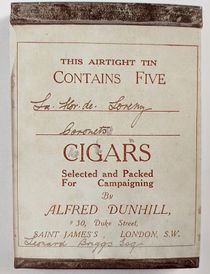
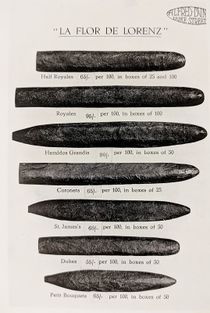
Alfred Dunhill’s most revolutionary innovation was the Shell pipe in 1917 (see more about The History of Dunhill's Shell). How this technique of sandblasting came about is somewhat of a mystery. The story often told is that Alfred Dunhill went down into his basement in the wintertime to make a couple of pipes and accidentally left one, a half-finished piece, by the heating boiler. He returned sometime next summer, having suddenly thought of the pipe, only to find some of the grain had ‘shrunk’, leaving a relief pattern. Obviously, this is apocryphal, probably resulting from the ‘shrunken’ look that sandblasts (especially the gnarly ones of that era) frequently have. Some say the name “Shell” came from the shrivelled look the pipe took on after the sandblasting process. Alfred realized Algerian briar, then considered inferior, could be used in this new process. The softer wood could be ‘blasted away’, leaving behind only the harder briar and the beautiful natural pattern of the wood. Originally, the Shell pipes were not stamped because the sandblasting technique, not yet been refined, made recognizing the standard shape much more difficult. Though the Shell finish certainly did not arise from accidentally forgotten pipes in the cellar, it was definitely an important innovation on Dunhill’s part.
Smokingpipes[25].
Another new technique ended up ensuring the quality of Dunhill pipes. Before the sandblasting process, Dunhill would have the Algerian briarwood bowls immersed in olive oil for several weeks. Afterwards, they were left to dry, with the excess oil being occasionally wiped off. This method was originally developed for aesthetic reasons, but it turned out that the oil caused impurities to be forced out of the wood, resulting in a faster curing process. A further consequence of this process was the briar became incredibly durable, making the occurrence of burnouts much less frequent.
In 1921, only fourteen years after Alfred Dunhill opened his doors, the firm developed ties with the royalty, supplying George VI with tobacco through the thirties and received its first Royal Warrant, as Tobacconist to Edward, Prince of Wales[50][51][52]. In the same year, 276,000 pipes were sold in the Duke St[48]. Shop. Dunhill formally instituted a one-year pipe guarantee (the "White Dot Guarantee") and in conjunction with that guarantee a date code system to date the year a pipe was offered for sale and Alfred Dunhill of London Inc. formed in New York (the store was opened one year later, in 1922 - same year of Alfred Dunhill of London Inc. was formed in Toronto and The Parker Pipe Company Limited also formed to become a subsidiary of Alfred Dunhill Limited.[53]
It is intriguing to me how very late Dunhill came to the pricing strategies we now take for granted with luxury products—with steeply ascending price for reasonably minor incremental differences in quality. I mean imagine going to Duke Street in the 1920s and ‘30s and having your choice of a shape 53, a 56, or an LLC at exactly the same price.Guy Lesser.
In 1923, a remarkable year, the company opened its capital in the stock exchange authorizing an initial capital injection of 300,000 pounds sterling (Alfred Dunhill Limited formed, with an initial authorized share capital. Alfred and his brother Herbert served as directors). Dunhill has done its first registration of "Alfred Dunhill" signature as a trademark. Later during WWII, the company kept Winston Churchill constantly supplied with the cigars (Dunhill Cigars) that would become such an essential part of the famous British icon. The '20s and '40s were successful years.
Dunhill had a doorman, a former Royal Horse Guards officer, and also gratified taxi drivers who got customers with ten cigarettes from a discontinuous line produced for soldiers during the Great War. The underground cigar room was richly furnished in mahogany with a thick green carpet and Venetian lamps. It was guarded by the watchful eyes of Major Malcolm Somerset-Johnstone, a former cavalry officer who wore a furry hat and a monocle and offered the exquisite cigars of a large mahogany cabinet that, rumored, came out of the Duke of Devonshire's mansion in Picadilly.[54]
The company expanded, offering specially designed pipes during the 1920s that would be marked OD for "own design" (see examples A DUNHILL ODA SHAPE CHART). This concern for marking and always having patent numbers on pipes is what allows for much of the dating process today. The stamping during the twenties was inconsistent and some of the early shell pieces lack marking altogether. later, in the 1930s there was a desire to standardize. A shape chart was developed (see more about Dunhill Shape Chart & Dunhill Shapes List) that used numbers and letters to signify a specific shape. Each new pipe would be stamped to identify its size and shape.
Smokingpipes[25]
Alfred retires in 1928 with health problems[13], leaving his brother Herbert Edward Dunhill ahead for a few months until his first son, Alfred Henry[24] could take his position (on 5 February 1929)[55]. Richard Dunhill (the Firstborn of Vernon), years later, gives the understanding that Herbert was the head of the company until his death in the ages of 1950[56]. He lived in Monte Carlo and participated in the management of the business through correspondence – letters, telegrams, and punctual visits[56]. Alfred Henry, like his uncle Herbert and his brother, Vernon, began his journey in the company as an apprentice in 1912, then at the age of 16. In 1914, with the beginning of the war, he was absent from the business to serve the army - he resumes its position in the company in 1919. Mary, Alfred's youngest daughter, joins 1924, 18 years old. Alfred Henry and Mary begin to have more effective participation in 1929, facing the difficulties of Uncle Herbert with modern commercial practices. Between 1923 and the beginning of 1970, 95% of the company's revenues were related to tobacco consumption, the accessories accounted for only 5%[56]. After expansion and strategic reformulation in the years 70, these numbers changed order.
The Alfred Dunhill of London Inc. (formed in New York in 1921) filed a petition to the U.S. government to reduce import fees on February 5, 1929, to be able to reduce their prices and thereby be able to compete with the American market. They also expected to increase their profit margin, which was very small at the time. It mentions a type of Kaywoodie pipe being more expensive and also argues that a cigarette case and a card case are essentially the same thing, therefore they should not be taxed at different rates [57]. It is an interesting historical document that exposes the reality of the market in a pre-crisis scenario of The Great Depression, that started in the United States on September 4, 1929. See the full petition here.
World War II also presented some problems (WWII Phase), the Dunhill shop at Duke Street was destroyed during the Blitz in 1941 and had to be relocated[58]. The supply of briar became more tenuous[59]. Italian briar was restricted by the Italian government to be used only by Italian carvers. The Algerian briar became more difficult to acquire. The war also left Europe in shambles. Depressed financially, there was no place in Europe for high-end luxury goods. Consequently, the American market grew and American taste determined the direction of Dunhill pipe making. Large pipes and traditional shapes were in demand and so Dunhill created a new line (THE POST WWII “ODA/800” SERIES) of pipes called the “800” OD series[60], recycling the old OD stamp[25].
Dunhill has always been creative in its designs and finishes. It is, however, Dunhill’s principle of absolute quality achieved through unrelenting quality control that has set Dunhill apart from the rest.
As the chairman, Richard Dunhill would say later, in 1981[61]:
“It’s easy to make a cheaper product, but the reason we’re here today is that we resisted the temptation. Quality comes first.”
Dunhill pipes regardless of shape, size, and finish must always smoke well. This principle laid down in the early days of the company continues today. At the Dunhill factory, just outside of London, pipes are made by 15 full-time expert craftsmen who boast a cumulative work experience of 260 years. Knowing a high-quality product must begin with the best possible material, the briar used by Dunhill is from carefully selected burls from bushes a hundred years old. Even with selecting only the highest quality briar with the finest grain, once the briar bowls begin to be carved certain flaws are exposed and many bowls have to be discarded. At every stage of the process, there are mandatory quality checks that ensure a Dunhill pipe will smoke well from the first to last bowl of tobacco, regardless of age. Each step in the six-week process is done by hand. Over 90 different steps are required in a process that has changed very little since the days of Alfred Dunhill almost a century ago.
Dunhill Pipes are now prized collector pieces and the most famous pipes in the world. Alfred envisioned the Dunhill Pipe to be something special, a pipe to be coveted for its quality, sophistication, and refinement. Alfred Dunhill’s vision continues today. To smoke a Dunhill is to experience this tradition, a tradition of excellence that is perhaps the greatest in the world of pipes."[25]
Duke Street Shop - the '90s & early '00s
The Desk boasts a cosmopolitan clientele, and obviously, today is no exception. I ask Burrows whether various nationalities have very definite tastes in pipes and tobacco. ‘Absolutely. For example, the Italians are the only people who buy pure Latakia. If they have a mixture, it has a high content of Latakia in it. If they buy a pipe it is normally a smaller bowl. It suggests they like strong tastes and they like to smoke a pipe a little at a time.’ In contrast, Burrows says, most Japanese customers opt for highly aromatic tobaccos. But perhaps the most interesting recent trend is the appearance of younger smokers: ‘We’re seeing a lot younger people in their twenties going onto pipes. They come in with their father or friends and I try to get them onto a pipe. Also, a lot of people who smoke cigars want to try something else because they don’t want to spend so much money on cigars, so I’ve suggested a pipe.’ Do these young smokers go for a certain type of pipe? ‘Yes, they like a straight pipe rather than a bent pipe. Bent pipes tend to look a little ‘old’. They like a small bowl with a straight stem. In terms of tobacco, 1 would have thought they would have liked more aromatic tobacco, but surprisingly not. They prefer the ones that are a very English mixture with Latakia.The Worldwide Pipe Smoker's Magazine (1993).[41]
In an article named "The New Alfred Dunhill Shop" for The Worldwide Pipe Smokers Magazine in 1997, Tim Rich give us a glimpse of this new phase and talk a bit about the museum (now closed).
When something steeped in tradition and character is changed, one fears the worst. When I heard that the Alfred Dunhill Shop in London had undergone a dramatic redesign and that the popular tobacco desk had been moved ‘upstairs’, I hoped that the firm had embraced modernity without throwing away history. I travelled to London’s swish Jermyn Street to see the results of the change for myself.Tim Rich. See the full article here.
Since the founding of the company, My Mixture blends were available and the recipes were stored in a book. Beginning in the early 2000s, Dunhill ceased keeping records or recipes for custom blends in its shops. In 2005, Dunhill suspended the sale of tobacco-related products.
At the beginning of the 2000s, Mr Burrows (a longtime collaborator who supervised the mixtures) related that the book still existed, but it was not in Dunhill's possession. He also said that British American Tobacco (the company that owned the rights to all Dunhill tobaccos for quite some time as “Rothman’s” before they merged) owned the book as well as controlled the production of present Dunhill tobaccos (though Dunhill still makes its pipes). BAT will not release it or its contents to anyone. He has tried several times to convince BAT to release the My Mixture recipes to him while still allowing them to retain ownership of the book, but BAT declined. Mr Burrows was unhappy about the situation.
Addendum: In 1989 Richemont acquires Philip Morris' 30 percent interest in Rothmans International[62]. Rothmans International Group was formed in October 1993 through the reorganization of the tobacco and luxury goods businesses of Richmont, Rothmans, and Dunhill into two new listed groups, Rothmans International and Vendome. Rothmans International comprises all of Rothman's tobacco businesses and certain tobacco trademarks previously owned by Dunhill and Richmont. International cigarette brands owned and controlled by the group include Rothmans, Peter Stuyvesant, Dunhill, Craven A, and Golden American. Under its constitution, Rothmans International has a dual holding company structure, in which the shareholders hold units comprising twinned shares in Rothmans International Plc, a British company, and Rothmans International NV a Dutch company. Rothmans International Plc owns the UK-based businesses and Rothmans International NV owns non-UK based businesses. The composition of the boards of both companies is identical. Following the reorganization, Rothmans Tobacco (Holdings) SA, an indirectly wholly-owned Richmont subsidiary, owns 61% of the Rothmans International units, with the balance being held by former public shareholders of Rothmans and Dunhill[63]. Vendome is now called Richemont (created in 1988 by the spin-off of the international assets owned by Rembrandt Group Limited of South Africa) and owns percent effective interest of BAT stock.
In 1995 Richemont buyout of Rothmans International minority shareholders. In 1996 Merger of Richemont's tobacco interests with those in South Africa held by Rembrandt Group Limited, Richemont owns 67 percent of the enlarged tobacco group. In 1999 Merger of Rothmans International with British American Tobacco (Richemont holds 23.3 percent effective interest in the enlarged British American Tobacco)[62]. The Dunhill brand as owned by Richemont was organized into two separately controlled entities: Dunhill Manufacturing (The White Spot Smoker's Accessory Division: pipes, lighters, leather goods, etc), and Dunhill luxury goods, which includes the stores, watches, pens (Dunhill bought Mont-Blanc around 1977), clothes etc[62] (Richard Dunhill headed the pipe making division). Today, it is not a separate entity. The White Spot (smokers' accessory) division is a product division within Alfred Dunhill Limited (like menswear, leather goods or hard products)[32] The stores and other branded items are run separately by people who figure their potential customer base is 95% non-smokers.[56]
Addendum+: In 1976 Dunhill acquired (for U$2,185,000 + 106,000 £ after loan repayments) Lane Limited which included Charatan (acquired by Lane in '62), Ben Wade (acquired in '65 and the Grosvernor Pipe (founded in '62 by Herman Lane). In 1987 Dunhill Sold the control of Lane Ltd to Rothmans (later merged with BAT).[64]
Dunhill allowed Preben Holm to use the Ben Wade name until his death, in 1989. Almost a decade passed before John Louis Duncan bought the name from Dunhill and relaunched the brand while still using the Dunhill Factory at Walthamstow. The Ben Wade brand was subsequently sold to Mr Peter Wilson, in 1998 (John Duncan, a grandson of the founder John Louis Duncan, sold the firm to his brother-in-law Peter Wilson)[65][66].
The Richemont group continue with manufacturing and selling the Charatan pipe brand nowadays (Dunhill and Charatan are still under the umbrella of them). Parker and Charatan pipes are mainly made in the Chatham workshop in Kent or abroad. Just the stamping and packing of those pipes is done in their main factory, in London[32].
In 1988 Dunhill licensed the rights to the Charatan name, trademark and shape chart - there was hardly more left over to sell - to James B. Russell Inc. (Upper Saddle River, NJ). Russell had made his Charatan pipes in Saint-Claude, France. Butz-Choquin is said to be the manufacturer. Now, Saint-Claude made pipes are surely not bad per axiom, but these Charatans were woefully poor counterfeits of the "real" ones and quite a flop in sale. When J.B. Russell went out of business in 2002 Dunhill reintroduced Charatan and called on Colin Fromm of Invicta Briars and Castleford fame to produce Charatan freehands now. Since Colin Fromm and his foreman Colin Leeson, both belonging to the small number of English pipe artisans skilled in making high-end freehand shapes had already been making exquisite free-hands for Dunhill for a couple of years in Chatham, Kent.[67]
Pipe Workshop
Loring stated in his book that between 1907 and March 1910 (before establishing the manufacturing facility) Alfred's pipes were not made by him. He bought fully manufactured pipes, (most probably) made out of varnished Algerian briar, in four shapes. These were thick shanked, thin shanked, military mount billiards, and a bulldog. After this period, the pipes came from France.
These third party made pipes initially carried in the Duke Street shop in 1907 were given shape numbers running from 1 through 30, with shapes 1 and 3 being copied by Dunhill in 1985 for its seventy-fifth anniversary of pipe making set. The pipes came with and without silver banding and in three quality grades (high to low: "B", "A" and "popular"). I do not presently know how these 1907 pipes were stamped, but if I were to hazard a guess it would be DUNHILL over DUKE ST. S.W. on one side, with the shape number either on that side or the reverse.The Dunhill Briar Pipe[68].
In 1909 Dunhill began an in-house pipe repair business and a year later, in March 1910 expanded to a two-man pipe making operation, primarily using bowls shaped in France.
Bob Winter joined Dunhill to handle pipe-repair work in 1909: he came from F. Charatan & Sons Ltd (of which company an account will follow). He was keen on the idea in the back of Dunhill's mind that a factory should be started, and introduced Joe Sasieni (also from Charatan), an amber and meerschaum worker, who joined the team for 50s a week, on 7 March 1910.One Hundred Years and More. [69]
He had continued to make headway as a tobacco blender, though, until 1910, he was still without a pipe to do justice to the quality of his blends. The calabash and finely carved meerschaum pipes in his showcases were too fragile for everyday use, and customers had long been complaining about the taste of the cheaply varnished Algerian briars which, as I pointed out, were about all any tobacconist had to offer.Mary Dunhill [70]
Alfred doesn't mention to anyone, Mary reports, but he was investigating the pipe maker's craft from end to end Mary Dunhill [70]. Alfred Dunhill enticed Joel Sasieni away from Charatan (including Joe Sasieni who was to form his own distinguished pipe company in 1918. The first five Dunhill pipemakers all came from Charatan) and opened a small pipe workshop of his own at 28 Duke St on 7 March 1910. - two rooms upstairs providing the humble beginning. The focus was to use the finest quality briar, and expert craftsmanship to make pipes that would provide a superior smoke, and last a lifetime. The cost would reflect these principals, which was against the current trend of inexpensive pipes of lesser quality (the Bruyere finish is first introduced).
From Saint-Claude, a small town in the Jura mountains which is the French home of the briar pipe industry, Father could obtain the wood he wanted. But from the day he began to study the effect of sunlight on immature bowls in his shop window, he had become obsessed with the subject of wood, its nature and the business of seasoning it. This is why it had taken him three years to evolve the heat treatment processes that are peculiar to the Dunhill pipe and which have a fundamental effect on its smoking properties and on the lasting, natural finish that is given to its grain.Mary Dunhill. [71]
Loring also defended, at this time, that Dunhill Bruyere pipes were generally finished from French turned bowls until 1917, when the Calabrian briar started to be used, but not completely[68]. Only in 1920 did Dunhill take the final step in its pipe making operation and began sourcing and cutting all of its own bowls, proudly announcing thereafter that "no French briar was employed".
Mr Hener and Mr Tim Rich believe that in the beginning the pipes were obtained from English wholesalers.
I understand that the pipes sold in the period since the opening of the Duke street store in 1907 until opening of his own manufacture on 7 March 1910 were obtained from English wholesalers, possibly from wholesaler Alfred J. Nathan (for the less expensive varnished qualities made from Algerian Briar) and from Adolph Posner (for more expensive Straight Grains). As to the manufacturing origin of those early pipes and if they were manufactured in the UK, France or otherwise, I have no knowledge.The White Spot Division.[32]
Pipes made by two respected pipe makers, Alfred J. Nathan and Adolph Posner, were bought in. The shop quickly established a reputation for its tobaccos and cigars, but Alfred Dunhill was left with the feeling that its pipes were not up to scratch. So, in 1910, his company started making its own pipes, bringing in Joe Sasieni from Charatan &. Son to head up the production team.The Worldwide Pipe Smoker's Magazine. [72]
And after March, with the factory ready to produce, most Dunhill pipes were completely made in-house.
With the opening of its own manufacture, most pipes were completely made in-house. Some of the bowls selected and graded in the first of the manufacturing processes in 1920 possibly came from Saint-Claude in France. However, as perhaps those were of lessening quality or becoming too expensive, Alfred Dunhill established a bowl-turning unit at 20 St. Pancras Road near King’s Cross station.The White Spot Division.[32]
The first pipes were made by two men on the upper floor of Nº. 28 Duke Street. By 1912, when the pipe was well and truly on the market, Father had about half a dozen hand-picked craftsmen in a workshop in Mason's Yard, a short distance from the shop. They worked from eight in the morning until seven at night and, when required to finish pipes the shop would sell next day, later than that. No question of a five-day week or of water to wash with. Like every employee, they received a small commission based on sales and they worked hard because, with the ginger-haired man they called the Guv'nor bounding up the iron staircase several times a day, they were in no doubt about the urgency and importance of their work.Mary Dunhill [73]
At first, the Dunhill pipes were made at Mason’s Yard, just a short walk from Duke Street, but as the size of the operation grew, it moved on to bigger premises, first at Notting Hill and later at Plaistow. Following the acquisition of Charatan &. Sons, the operation was moved to the old Parker Hardcastle factory in Walthamstow in 1982, where it remains to this day. ‘Every Dunhill pipe is made in that factory,’ explains Philpott. ‘A high proportion of Charatans are made there too, but it is basically an Alfred Dunhill factory. The process and the people are geared up to make the very best quality products. It’s a unique factory in terms of the number of individual processes involved and the length of time it takes. Consequently, it’s not cheap in terms of manufacturing costs to make an Alfred Dunhill pipe.The Worldwide Pipe Smoker's Magazine,[74]
In the beginning, Dunhill's pipes were limited production straight grains, hand-cut from over century-old briar burls and fitted with hand-cut 'push' vulcanite bits.
These pipes were individually priced from ten shillings sixpence to over four pounds.· I am not sure how these pipes were stamped but most likely DUNHILL over DUKE ST. S.W. appeared on the shank with either a "B" or a "DR" near the bowl. A "B" stamping is possible since at that point in time "B" denoted Dunhill’s highest quality pipe. On the other hand I believe "DR" more likely as that stamping was being used to denote straight-grained pipes by at least as early as 1915. While these pipes in time became a high-end subset to the Dunhill 'Bruyere' (and later the Root) line initially they should be distinguished as these straight grain pipes were hand-cut in London from burls as opposed to the Bruyere line which was generally finished from French turned bowls until 1920. (The qualifier 'generally' is used here because any pre-1920 OD, HW or letter shape Bruyeres were most probably also carved from burls in London).The Dunhill Briar Pipe. [75]
Hener's information corroborates Loring's, and expands with information about the Motorities pipe production:
If we talk about the earliest Dunhill pipes during the Motorities period (1904 – 1907), there were 3 qualities: A Quality (“First quality Briar, with finest vulcanite hand-finished mouthpiece”), B Quality (“specially selected Briars, hand-made”) and a Popular quality, which was lower grade and price.The White Spot Division.[32]
Later, once his own production started, the nomenclature was similar: A Quality, the more expensive B Quality and the much more expensive limited production Straight Grain pipes.
Mary also related that Micrometer measurements have established everything that they needed to know about the shapes and design of bowls[73]. Every Dunhill pipe should have its own specially designed mouthpiece, hand-cut from the finest block vulcanite.
In an article on Fumeurs de Pipe[76] , it is mentioned that Dunhill also used briar from other English wholesalers for his Magnums.
Richard Esserman thinks that Dunhill subcontracted to BBB the manufacturing of the bowls for his Bent Magnums until 1923. In fact, when the companies of the CIL stopped fighting each other, all the bowls were turned in. The new factory was located in Stratford, Carpenters Road. CIL also bought Zuckerman machines as they were more efficient. The finishing workshops closed, and the pipes were finished at Aldershot and sometimes at Shoeburyness. At that time, it was common practice in commerce to offer other companies surplus stummels at agreed prices. Cadogan used to sell Grade A to Dunhill, and buy him Grade II, III, and IV stummels. But they did not finish the pipes for the other companies: to sell stummels of grade A to Dunhill was more profitable than to make them pipes!
Pipe Workshop Today
The factory is located in a district in northeastern London, Walthamstow, since 1982. The brand was repositioned, and the pipes received new stamps in March 2012. Now they are known as "Alfred Dunhill's - The White Spot".
- See pictures and video here: Dunhill Factory.
We recently consulted Mr Hener to get more information about the briar used today and here is the answer:
We try to source the best Briar money can buy from a variety of different sources. Sometimes we do know the exact origin of the wood and sometimes we cannot be entirely sure (especially when sourcing via specialist wholesalers), but more important than the origin is the actual quality of the wood that we purchase and, consequently, the quality of pipes we can make out of it. All wood comes from the Mediterranean region and the countries or areas bordering the Mediterranean sea, be it France, Italy, Corsica, Greece, Morocco, Algeria, etc.The White Spot Division.[32]
As for the age of the wood, the quality of our pipes necessitates a certain minimum age as a suitable Briar root (Erica Arborea) may take around 50 to 100 years to mature in the ground to allow for suitable size and also quality of its grain, but sometimes we can obtain Briar that is considerably older.
For some time, rumours have been spread about outsourcing the production of pipes and that they are manufactured in France - even today. Mr Hener assures that production is in-house - this is just unfounded rumours, as we can see in an article By Stephen A. Ross for the Pipes & Tobaccos Magazine.
While Hener and Wilson are both insistent that there is little in common between Parker, Charatan and Dunhill pipes, they more passionately refute reports that Dunhill pipes are made anywhere other than the factory on St Andrews Road. The rumours that our Dunhill pipes are made in Saint-Claude, France, are completely false,” Hener bluntly states. While conducting a tour of the factory floor, Wilson shows two employees working with band saws, cutting blocks and shaping them into rough bowls, and adds, I think that those rumors started from other companies who are jealous of our position. They’re envious of our position and reputation in the market and they want to try to knock us down a little.Pipes & Tobaccos. [77]
Seeking a better understanding of the current production, we talked to Chris Felts. He has been the U.S distributor since 2003 and he has managed all aspects of imported Dunhill smoker's products. He personally handpicks each pipe for the U.S every year, often making multiple trips to London to do so.
The current pipes are much higher quality than decades before whereas many, many years ago they had different grades of briar which they would use a letter code, i.e A/B and so on. These days they only use plateau grade briar, only this kind for all of their pipes, therefore you can trust that each pipe is the same high quality as the next pipe. Quality control is much higher than in previous decades. With a small number of people in the factory, each pipe is scrutinized under a microscope to ensure the best quality.. July 8, 2020.[78]
The the factory in London produces each mouthpiece from a solid vulcanite rod, initially carved down by a lathe, the white spot is installed by drilling the hole and inserting white spot from a solid rod, bent by hand (they put the straight mouthpiece in a type of heater, then bend by hand), then the multiple stages of handwork are done to finish each mouthpiece to include final polishing (not entirely by hand, a lathe must be used for the initial shape, much like a band saw is used in the initial stages of cutting the briar prior to it being shaped by hand using a sandpaper wheel. Each mouthpiece is tailor-made for each pipe. You can have two identical pipes, the same shape, the same size, but you cannot exchange mouthpieces with both of those pipes. Each mouthpiece is different from the next)
Just One More Thing
Alfred Dunhill Shop's Humidor Room.
Interior view of the Humidor Room at the Alfred Dunhill shop in the International Building at Rockefeller Center, New York, New York, mid to late 1941. The walls are lined with cases and boxes of cigars. (Photo by Bernard Hoffman/The LIFE Picture Collection).
Dunhill’s shop, 136 S. Rodeo Dr, in Beverly Hills in the early 1950s.
Rodeo Drive is a two-mile-long (3.2 km) street, in Beverly Hills, California, with its southern segment in the City of Los Angeles. Its southern terminus is at Beverwil Drive, and its northern terminus is at its intersection with Sunset Boulevard in Beverly Hills which is known for its luxury goods stores. The operating time and closing date is presently unknown.
About New and Old Pipes
Among the brand lovers, there are always doubts as to the quality of the pipes and their relationship with the period when it was manufactured. It is often said that Dunhill only manufactured good pipes until mid-1968 and after that, the quality was compromised. The patents Era ended in 1954, but it is said that good pipes continued to be made until mid-1968.
Originally at the time in the late 1970's - when a so-called cut-off date was established between for the great Dunhills versus more current production - the actual year was 1962. Then it migrated to 1964 then the current 1968. In my mind, what did change were aesthetics.Esserman[79].
In an article named "The Myth of Brand and Maker in Pipesmoking", Dr Hanna brings to the light of our consideration what might justify this thought.
Dunhill is famous for its oil curing techniques and this is believed to be a source of its peculiar and particular taste and flavor characteristics. On the surface this sounds quite neat and tidy. But just a bit of analysis immediately makes such claims quite suspect. Does every Dunhill have that same character? I could find no evidence for this in the tastings that I have done with Dunhills. One vital question concerns when a particular Dunhill pipe was made. Bill Taylor of Ashton pipe fame has remarked that during all the twenty-plus years that he worked for Dunhill, that he never observed any oil applied to a Dunhill bowl. David Field told me on two occasions that he is convinced that oil curing stopped after 1968 and after that Dunhill pipes were quite different. Thus, Dunhills after the mid-1960s do not appear to have been oil cured at all and, on top of that, their bowls seem to have come from different suppliers.Dr Fred Hanna. [80]
In 1967, Carreras Ltd (Rothmans International at the time - then in 1999 Rothmans was acquired by British American Tobacco[81]) purchased 50% of the Dunhill capital from the company and from members of the family and three of their directors joined the Dunhill board[82]. Is it possible that this new council has defined any administrative measures that have influenced the production of the subsequent products? We have signs of transition in that period, but we don't know if it was for that reason, but it is a possibility that it cannot be ruled out. It is also a period that the company begins to reposition itself in the market with male accessories, leaving tobacco-related products in the background.
Note: Mr. Richard Dunhill also mentions this change in an interview on Jack Webster's show, in 1984 [25].
Something similar was also reported by Robin Philpott (the Managing Director UK and Ireland) in the early '90s, in an article to The Worldwide Pipe Smoker's Magazine.
Luxury goods now account for approximately 95% of Alfred Dunhill’s sales. Yet the pipe business remains crucial to the image and heritage of the company. While Robin Philpott is not predicting a huge growth in Dunhill’s pipe smoking activities, he is optimistic about the pipe division’s future and excited by potential markets.The Worldwide Pipe Smoker's Magazine.[83]
At the beginning of the 60th decade, the Italian government restricted the use of the Briar to Italian manufacturers and the Algerian briar became scarce (a consequence of the Algerian War of Independence. 1954-1962), which forced Dunhill to turn to Grecian briar, as R. D. Fields said in The Art of Sandblasting, "During the 1960s and ’70s Dunhill could not acquire the Algerian briar." Consequently, the company’s sandblast pipes were much shallower and less distinct and, as R. D. Fields also related in another article, A Tail of Two Briars that the age of the briar used in the '60s was averaged between 60 and 100 years old and then changed drastically to a briar less aged, between 50 and 80 years. These factors contributed to the construction of this concept of loss of quality. But as Dr Hanna argues in his article, "briar from certain regions has different physical qualities, but this does not seem to be related to taste and smoking potential." Mr Esserman, Loring, and David Webb also mention these changes.
Dunhill around 1970 could not get discrete wood for the various - Sardinian for Tanshells, Algerian for Shells - Dunhill had to move to what I was told wood from Greece which did not blast as deep. Dunhill for a brief period used a black understain on the Shells - Dunhill experimented using blanks instead of hand-cut bits. So in the early-mid 1970's - Dunhill's reputation suffered. But Dunhill rebounded around 1975 and 1978 was one of Dunhill's greatest years ever.Esserman[79].
Since the early 1960's Algerian briar has been largely unavailable to Dunhill and much harder briar (primarily Grecian) has had to be used for the finish. As a consequence since the mid-1960s, the Shell finish is generally found with a significantly shallower blast.The Dunhill Briar Pipe. [84]
According to David Webb, the Dunhill pipe did have a problem in the mid-1970's, not so much with quality as with the outward signs of quality. Those in charge of policy at the time decided that the "shell" must be totally black and shiny - a blue-black stain was used, eliminating any reddish highlights. At the same time, the "bruyere" finish was lightened from its original plum color. These two changes have dampened the pipe's reputation and may be the cause for some criticism I have heard; but, even with these pipes, the underlying quality is still there. Since that time, of course, there has been a return to the original "bruyere" finish, and the new "deep shell" has reached our shores in limited quantity[85]
The metrics used in defining the concept of "quality loss" seems to be related to misperceptions of changes and aesthetics subjective values. In these circumstances, any definitive conclusion may be premature and unfair. Even the process of oil curing, that was considered determinant in quality, in the end, it not so decisive, as we can see in another consideration of Dr Hanna:
Several Dunhill collectors have told me in no uncertain terms that the old patent Dunhills (before 1955) smoke decidedly better than the later models. So, which time frame owns the peculiar Dunhill character? This adds considerable ambiguity to the great taste of a Dunhill. Does oil curing make the difference? Probably not if Dunhill pipes have not been oil cured for perhaps 33 years, and Bill Taylor implies that after a while oil curing is not a factor anyway. Taylor, who oil cures his own Ashton pipes, has stated that the effects of oil curing can no longer be discerned in a pipe after 30 or so bowls of tobacco. In other words, after a sufficient cake has formed and the pipe is well broken-in, the influence of the bowl treatment or curing method becomes negligible. Now where, I ask, is that unique Dunhill character? The cake and the wood itself probably have more influence on taste than the curing method after many, many, smokes.Dr Fred Hanna. [80]
There are pipes from different periods that, due to the manufacturing process, present some minor irregularities, such as misaligned bowl drilling, white dot and funnel bore of stem - especially in the '90s. But that doesn't mean they weren't good pipes. Some criticisms seem to be nostalgic - the brand continues to manufacture good pipes today, now called "Alfred Dunhill's - The White Spot".
I know many collectors who have told me personally that some of their Dunhills smoke great, while some do not smoke so well. I personally have owned a few Dunhills that were poor smokers and others that were fantastic.Dr Fred Hanna. [80]
I will say that I have smoked hundreds of Dunhill's - from all time periods and have found that the smoking qualities are great - no matter what the date of manufacture. I have the largest standard Production Roots from the 1970's - magnums from the early 2000's - just bought a 2019 Ring Grain Magnum - and have many great Magnums from the 1920's - 1930. So the 1968 date is meaningless.Esserman[79].
In order to discern quality in a pipe, one has to look at only a few things (of course much of the real judgment is in the smoking): the turned and bored bowl; the shank bore; the tenon/ferrule connection; the lip of the mouthpiece; the look and feel of the finish. Dunhill, I submit, has as high a standard of quality as it has ever had. This does not mean that every Dunhill released for sale, today, is a perfect pipe, for some are not! What it does mean is that the percentage of imperfect Dunhills is no greater today than, say, 1924. I have discovered two imperfect pipes in my 1920-1927 collection.R.D. Fields. [85]
About Dunhill Today
Alfred Dunhill is one of the brands of the Richemont group and we, The White Spot division, are one of the product divisions within Alfred Dunhill Limited (like Menswear, Leather Goods, Hard products, etc). The pipes are stamped Alfred Dunhill's THE WHITE SPOT. All Dunhill tobacco-related interests (cigarettes, cigars (Dunhill Cigars), pipe tobacco) were sold a long time ago (in 1981) to Rothmans (who many years later merged with BAT - for more information see the addendum at the bottom of New Phase - Duke Street Era section). They still belong to BAT today.The White Spot Division.[32]
In the magazine Pipes and Tobaccos - fall 2010, there is an article By Stephen A. Ross called: "A century of excellence" that talks about the past, the present and the future of the brand. It also talks about the current Dunhill Factory, its manufacture of pipes and a little bit about Mr Kalmon Hener, one of our contributors and Product Line Director of the White Spot Division.
A century after Alfred Dunhill opened his first pipe workshop, Dunhill pipes continue to be synonymous with English excellence. Guarding the flame a century after Alfred Dunhill provided the spark is Kalmon S. Hener, the general manager of Alfred Dunhill Ltd.’s smoking accessory division, now known as the White Spot Division; Stephen Wilson, the production manager who has been with Dunhill for more than 40 years; and approximately 20 employees who make pipes and leather goods at Dunhill’s legendary factory on St. Andrew’s Road in Walthamstow, an area in northeast London not far from White Hart Lane, home stadium to the English Premier League’s Tottenham Hotspur Football Club. Dunhill’s position atop the pipe market is strong. According to Hener, 2009 sales in the United States alone were up by more than 60 percent, making it the top market for Dunhill pipes.Pipes & Tobaccos. [77]
- See the full article here, from page 8 to 11.
Video Interview with Richard Dunhill
The following video is a wonderful interview of Richard Dunhill from 11-14-1984. Richard is referred to here as "Old Alfred's Grandson".
Note: Richard Dunhill, the grandson of the founder of Alfred Dunhill Ltd., died on August 26, 2016, at the age of 89, having been an employee for 68 years. A son of Vernon Dunhill and grandson of Alfred Dunhill, Mr. Richard, as he was respectfully addressed by most staff, joined the Company in March 1948. He was appointed Executive Director in 1958, Full Director in 1961, Chairman of the Group in 1975 then President in 1989. He celebrated 50 years with the Company in 1998 and became its life-long honorary president[86].
- See the full article here: Remembering Richard Dunhill By Ben Rapaport.
- See more about Richard Dunhill: "For London's Richard Dunhill, Life's a Lovely Pipe Dream" - People.com (04/13/1981) here
Dunhill Commercial
From the day Bill Carter accidentally dropped one onto the green carpet and they had noticed how this colour enhanced the appearance of the grain, pipes were always presented on a green pad under a strong light by salesmen wearing cotton gloves. And so that salesmen could give undivided attention to his costumer, his colleagues - including Father himself - tidied the counter for him, putting away unwanted pipes in the drawers of their cabinets.Mary Dunhill. [87]
The following video is a commercial that shows us a bit of Dunhill in 1981.
About the Spot & Stem
Although Alfred Dunhill was brilliant, he certainly did not imagine that this indicative spot would become his trademark. In March 1920, Dunhill had to go to the courts to defend his spot, the litigation was between Dunhill and Wolf Brothers and concerned the white spot[48], which was being replicated by VAUEN (before that, In 1917, Dunhill had conflicts with Barling for using a spot, but that didn't go far. The action was formally discontinued in 1918[88]). In their advertisements in the trade papers, they drew attention to the spot in such terms as "our brightest spot" (it was a silver spot). Dunhill was successful, while VAUEN had to restrict its use to the German and Austrian borders. The White Spot trademark was first registered in 1923, eleven years after its introduction.
"(...)One small problem emerged, however, as customers could not tell which way up to insert the hand-cut vulcanite mouthpiece of straight pipes into the stems of the pipes. Alfred Dunhill, therefore, ordered white spots to be placed on the true upper sides of the mouthpieces, and thus a world-famous trademark was created.
According to Bill Carter, the White Spot was introduced soon after the pipe-making unit was moved in 1912 from 28 Duke Street to 6 Mason’s Yard, about 40 yards down Duke Street on the left. Mason’s Yard is an interesting and ancient enclave. It was originally called St Alban’s Mews, after the Earl of St Albans, whose trustees were granted the freehold of the whole area in 1665 by the Crown. It was probably renamed after Richard Mason who, in the 1730s, was granted a victualler’s license for the house that became Mason’s Arms." One Hundred Years and More. [69]
By the early 1920's the White Spot had become identified with Dunhill and a trademark for the same was obtained in 1922. In 1923 the company prevailed in enforcing the mark against the white dot of another pipe manufacture (Wolf), and about the same time in America (but not in Europe) against the blue dot of the then new Sassini pipe. On some bits however, mainly amber and ivory, the Dunhill White Spot is really a small black circle that effects the appearance of a White Spot.The Dunhill Briar Pipe.[89].
At first, this rounded marking was thinner and made in celluloid, a species of an acrylic predecessor, which was used until the mid-40s, when it was replaced by high-quality acrylic. Because of its appearance, it was defended for years and by many, that the point was made in ivory. However, that is a widespread legend that lasted for years. We have as evidence, the description of The White Spot in an action that Dunhill advocated the exclusive use of the Spot in 1922.
As evidence we can see the white spot (which consists of imitation ivory inserted in the vulcanite) was placed on the pipe with a twofold object, namely, to indicate which was the upper side of the mouthpiece and to distinguish readily the whole pipe[88].
Note: All pipes come with a costly fitted black ebonite (is generically known as hard rubber and is obtained by vulcanizing natural rubber for prolonged periods. Ebonite may contain from 25% to 80% sulfur and linseed oil. The material has also been called vulcanite, although that name formally refers to the mineral vulcanite).
This version of the spot appears only on the white mouthpieces, for an obvious reason. The stem was made from Ivory in the '20s up to '30s (maybe '40s) and after, from Erinoid. the White Spot stands out with a delicate black ring. Into it is inserted a vulcanite tenon which in turn pushes into the shank's mortice. We have made contact with the Dunhill's factory to know more about the production of the white mouthpiece in the last few years:
A piece of information about this material, taken from BBC, "A History of the World"[90].):
Casein plastic was made under the trade name "Erinoid" at Lightpill Mills in Stroud for about 70 years from 1912. Unlike the later plastics such as Bakelite, Casein plastic could be dyed in many bright colours. It could withstand the rigours of washing and ironing, dry-cleaning solvents, etc, and became popular for buttons and other household goods. It was eventually replaced by oil-based plastics for most users but is still made today on a small scale for high-quality goods.
The White Spot did on special request (2021), a limited production run for the Italian market of a variety of shapes in Shell Briar finish (with a grey marbled Vulcanite mouthpiece) and in Cumberland finish (with a beige marbled Vulcanite mouthpiece). All pipes are fitted with silver bands, both plain and engraved[91].
Note: Genuine ivory always has grain. The grain is characterized by lines of random spacing and irregular thickness.
Note+: All the stems were hand-cut until 1976. They have since been machine made due to labor costs. They use a 3.7mm drill for both mouthpieces and stem bore (for bore pipes, 4mm)[32].
Addendum: In the mid-20s, any Dunhill pipe could be supplied fitted with a mouthpiece of Amber, Tortoiseshell, or Ivory with an extra cost[92].
Addendum2: Apparently, using some kind of spot on mouthpieces was a common practice at that time. For example, in 1912 some 200 gross of a pipe called "The Durbar," with a white spot on the side of the mouthpiece, were manufactured and placed upon the market in England. However, that pipe disappeared from the market seven years later. It seems there were also other brands, represented by Frankel, Wolf Brothers, and even Charatan & Son, bearing a spot on the mouthpiece at some point. On 22 September 1921, Alfred Dunhill commenced an action against Bartlett & Bickley, represented by the owner, Mr. Charles Davis Jonas. The business that carried on under the firm name of Bartlett & Bickley had belonged to Charles David Jonas since 1901, and it had been moved to Vigo Street in 1910. Before the 1920s, Mr. Jonas had sold pipes of other people's manufacture, but in 1921, he brought out a pipe specially manufactured for him with a red spot on the mouthpiece, similarly placed to the white spot on Dunhill's pipes. Such pipes were marked on the shank with Mr. Jonas’ trademark "Barbie" which was registered in May 1920. They were also marked with Jonas' firm name and address. Alfred had requested Mr. Jonas to discontinue the use of such a spot on their pipes, but Mr. Jonas refused to do so. Mr. Jonas also stated that they intended to continue to manufacture and sell pipes having such a spot on the mouthpiece and would do so unless restrained by the Court. The action came to trial on 29 June 1922. It is interesting to notice in the file of this action, that Mr. Alfred Dunhill tried to disassociate the spot from the popularly known function, i.e. being a useful resource to aid customers in replacing the stem right side up, and suggested that initially it was added to stems largely to be a decoration. Despite the Wolf brothers' case law, the decision was unfavorable and the action failed, being dismissed with costs. Apparently, Alfred would have to get used to seeing spots in other colors on the market, facing his much-esteemed white spot.[88]
About the Inner Tube
In the early 20th century, many pipes were set aside after a long period of use due to obstruction of the airway when they became clogged for lack of maintenance. In 1911 Alfred Dunhill developed a solution to this problem by inserting an aluminium tube, which could be replaced as soon as there were signs of clogging. In this way the use of the pipe was prolonged. The Inner Tube was heavily produced until the 1930s. With the advent of "Scovillions" (or pipe cleaners) the innertubes gradually fell from use.
Dunhill began fitting some of its pipes with an aluminium tube that ran through the shank to facilitate cleaning and make the pipe more hygienic, an "inner tube". While often today the first thing that a new Dunhill pipe owner does is toss that tube aside as he reaches for a pipe cleaner, there was a time when there weren't pipe cleaners and in that world, pipe cleaning was a particularly unattractive chore.The Dunhill Briar Pipe.[93]
- 5861/12 was the first patent registered. However, there are other patents for these same tubes, with records in different countries. Examples: 1130806/15 - 158709/14 - 116989/17 - 1343253/20 - 197365/20 - 491232/19.
Aluminium inner tubes for the Dunhill pipes were patented in March 1912, but they were being fitted about eighteen months earlier. They sold at one shilling for a packet of six.One Hundred Years and More. [69]
Alfred Dunhill put it this way in March 1912 when he applied for the "inner tube" patent:The Dunhill Briar Pipe.[93]
The object of the invention is to provide means of an inexpensive nature which will ensure a pipe always remaining clean and sweet. When a tube has become fouled on its interior surface it can either be thrown away and replaced by a fresh tube or be cleaned by boiling in water.
Note:The aluminium tubes are still being manufactured (for straight pipes only) and can be purchased from authorised White Spot retailers worldwide. The product sku is PA3104 or now DUPA3104.
The White Spot Division.[32].
About Sets - Pipe Cases
The first setup (see images on the right) contains 7 pieces for the weekly rotation, where the days of the week related to each of the pipes.
"When Dunhill entered the pipe business pipes were often sold in fitted cases and Dunhill pipes and pipe sets in leather, silk-lined, fitted cases soon became available and remained available until well after the war. The cases were available in a number of configurations, most commonly two pipe sets holding matching Bruyere and Shell pipes, three pipes 'day' sets, and seven pipes 'week' sets: For at least the first two decades multi-pipe cased Bruyere sets were also available wherein each pipe of the set was carved from the same briar block. In 1919 Dunhill designed a ventilated "Ventage" pipe case for which it obtained a patent in 1920 and used thereafter as it's the standard case with the patent reference imprinted on the front of the case near the clasp (US patent example). The Ventage vents are thin channels running from the top of the indented pipe forms to the edges of the case so as to allow the lingering pipe smoke and aroma to vent when the case is closed.
The traditional Dunhill leather pipe case offered until fairly recent years can in and of itself be generally dated. This is often useful especially in determining whether the pipes of a cased set found today are consistent with the case. Until 1919/1920 the indented pipe forms at the bottom of the case do not have a 'vents' running from the bowl top to the outside edge of the case and the imprinting on the interior silk lining of the case top does not include a Royal Warrant. For the next few years, one will find the new 'Ventage' vents but no Royal Warrant imprinted on this silk inner top. In 1921 Dunhill received it's first English Royal Warrant and from that point, the silk inner top always bore and can be generally dated from that Warrant." See more about Royal Warrant here. The Dunhill Briar Pipe [94]
About Production
The pipe hard carcasses /cases are pre-made, so when selecting pipes we make sure that for each pipe chosen, the overall length of the pipe and the depth of the bowl is suitable to fit into the available space. Usually, we have no problem fitting most standard length group 3 or group 4 pipes into this case (that is why we made this carcass to that size when we developed it).The White Spot Division.[32]
After having selected the pipes, we make a bespoke insert with individual cut-outs so that every single pipe, no matter what shape, gets a perfect and snug fit.
In the following images (originally published in the United States Tobacco Journal, the most important in the tobacco industry) we have the Set which was presented by Alfred to the 29th president of the United States in 1921[95]. Warren G. Harding was editor and owner of an important newspaper in Ohio, "the Marion Star ", as well as a member of the Senate before occupying the position of President.
Next, a survivor Set from 1925. It's a set of 3 pieces with a case, cut from a single briar block. Shapes: Billiard 60; Billiard 35; Dublin 42. "A" Series (Bruyère, introduced in 1910) it was the best-quality line. On one side of the shank, its stamped "Dunhill London", on the other: "Inner Tube" Pat. No. 5861/12 (this patent was used between 1913 and 1926) 5 [1925]. On the stem: Reg. N°: 654638 and in the case: Pat. N°: 141486/19.
Note: Prior to the war the bottom of the Dunhill black vulcanite bit had a "REG. No 654638" stamped (without color) on the underside of the bit near the meeting point with the shank. Due to the lack of information, it is not possible to determine what this number refers to[96].
About Shapes
A sample of a 1930 Dunhill catalog of pipes. Written in 6 languages (English, French, German, Spanish, Dutch, and Italian):
Among Alfred Dunhill's greatest contributions to pipe making is classic shaping. For those who appreciate traditional shapes in their most traditional forms, Dunhill's famous White Spot pipes are the gold standard, and rightfully so. For a true Billiard shape, look to the White Spot. For a Lovat, Lumberman, Canadian, Dublin, or virtually any traditional shape, look to the White Spot for correct and accepted proportions, curves, tapers, transitions, rims, and every other element of a shape that can be easily rendered into something else if even one detail is miscalculated.
Chuck Stanion[97].
Currently 35 shapes. Occasionally a piece of briar is just asking to be carved into a different shape:
- Here we can see a little bit about them: Dunhill Shapes
- If you want to see the finishes, click here
- If you want to see catalogs, click here
The system of codes and acronyms was introduced in the early 1920s and remains to this day, however, modifications have occurred over time.
We had the opportunity to talk with Mr. Hener, who is the product line director of The White Spot division (the Dunhill pipe part of the company), who kindly clarified some issues.
- See more about it here: Dunhill Shape Chart
About Dunhill in France
Dunhill had to diversify its offerings in order to enter the market in France due to a monopoly in the French tobacco industry. Alfred circumvented this challenge very cleverly, by diversifying his offerings (something that was previously practiced back with Dunhill's Motorities). Because the tobacco market was restricted, Dunhill positioned its tobacco offerings in the background of its advertising, while featuring male accessories in the foreground (valise, umbrellas, suits, etc)[98]. Thus begins the new phase of Dunhill accessories, and its success entering the tobacco market in France. The shop is situated at 15 Rue de la Paix - a fashionable shopping street in the center of Paris. Located in the 2nd arrondissement of Paris, running north from Place Vendôme and ending at the Opéra Garnier, it is best known for its jewelers, such as the shop opened by Cartier in 1898[99]. Some French Flyers:
This meant that the new showroom in the rue de la Paix was obliged to specialise in alternative merchandise such as luxury leather goods, docks and watches, bronzes and in cigarette boxes and cases finished in lapis and jade and, thanks to the enterprise of someone who went to the Far East to acquire the rights, in the lacquer work of Japanese craftsmen. High-quality merchandise of this kind, which sold most successfully in the rue de la Paix, was later taken up in London and New York.Mary Dunhill[98].
- Note: From November 1918 through 1939, if a pipe was intended for export to France, the first (or only) line was stamped FABRICATION ANGLAIS. If a pipe was intended for export other then to France or if a pipe was not fitted with an inner tube, the first (or only) line was stamped "MADE IN ENGLAND". The FABRICATION ANGLAIS stamping was retired with World War II and thereafter all pipes including those exported to France were stamped MADE IN ENGLAND.[100].
Note+: DUNHILL PARIS
. During World War II Dunhill London was unable to supply the Paris retail shop. As a consequence it appears that the Paris shop sourced pipes during those war years from French carvers, stamping the bit with a "D" inside a diamond (very much like the Parker bit stamp which is a "P" within a diamond)[101].
About World War
On 17 April 1941, during the infamous Luftwaffe Blitz bombing of London, the Alfred Dunhill store (and many others in the surrounding area) were bombed and almost totally destroyed. The restoration was not fully completed until 1953. A popular piece of lore from that period is that Dunhill employees called Sir. Winston Churchill at 4:00 a.m. to ensure him that his private collection of cigars (Dunhill Cigars) housed in the store's humidifier had been transferred safely out of danger[102]
The Second World War was a difficult time. The rationing that the war promoted was so draconian that Dunhill suffered from the scarcity of raw material until the beginning of the 50 years in the post-war period.
According to John Loring, few pipes (and mostly uninteresting) were produced by Dunhill during the 1940s. Italian Briar for smooth pipes was extremely scarce, and Algerian Briar (used in sandblasts) was just slightly more available. Likewise, vulcanite for stems was either rationed or forbidden, so that many, if not most of the pipes produced during the war were equipped with horn stems[103].
- See more about this phase (including pipes stamps) here: WWII Phase
"Dunhill's Campaign Pipes are made from good bowls, which nevertheless are not that premier selection reserved for Dunhill's more expensive qualities. In finish, appearance and smoking qualities they are much superior to the ordinary low priced Pipes."
About Pipe Tobacco
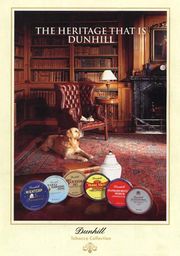
When Alfred Dunhill opened his shop on Duke Street in 1907 it was a tobacco shop. He was a tobacconist, or as he put it in his first catalog a “Mixture Specialist”, prominently displaying a sign in his shop window reading: “Tobacco Specialist”. But first and foremost Alfred Dunhill was a marketer and when he opened his tobacco shop he knew exactly where he wanted to go. In short order, however, he recognized that he had set his sights too low, this is a part of that story[38].
Initially, Dunhill sold a wide variety of pre-tinned and vacuum-packed tobacco made by any number of manufacturers. Alfred obtained tobaccos for his mixtures (have been carefully recorded in his My Mixture guide since 1907) from George Dobie & Son of Paisley (a manufacturer of blends located in Paisley, west of the Midland Valley in Scotland) and the Tobacco Supply Syndicate (cooperatives).[38][104]
The #965 mixture was introduced in the mid-'10s (and continues in production until nowadays). In 1912 Alfred Dunhill introduced his first pre-packaged ‘name’ blends: “Royal Yacht”, “Cuba” and “Durbar” (while the blends tailored acted in the background). Two additional pre-tinned blends were introduced during World War I, “Ye Olde Signe” in 1915 and an Oriental, “Harmony” in 1917.
“Standard Mixture” (in all three mild, medium and full), “Prince of Wales”, “Three Year Matured” and "Super" were introduced in the early '20s. “London Mixture” was introduced in '28, “Throgmorton”, “Old Colonial” and “Twist” (referred to as “Negro Head Twist” two years later) in '36. In the late '30s, Dunhill introduced “Baby’s Bottom”, “Savory’s Mixture” and “Baby’s Bottom”. In the early '40s “American Mixture” was introduced (was never marketed outside the US). “Harmony”, “Throgmorton” “Twist”/“Negro Head Twist”, “Old Colonial” and “Super” were discontinued between the end of the '40s and the beginning of the '50s. In 1951 “Aperitif”, “Early Morning Pipe” and “Nightcap” were introduced. In the late 1950s “Flake” (later known as “Light Flake”), “Negrohead” and “Shell” were introduced. In the early '60s “Rough Cut Virginia” (like “Negrohead” and “Shell” was offered for only a few years) and “My Lady’s Dunhill Mixture” were introduced. Also in the '60s “Prince of Wales”, “Savory’s Mixture” “Three Year Matured” and “Cuba” were discontinued. Late '60a to the beginning of '70s “Mr Alfred’s Own”, “Aromatic”, “Baby’s Bottom Virginia”, “Baby’s Bottom Flake” and “Dark Flake”, “Elizabethan”, “Golden Hours” and “Virginia Ready Rubbed” were introduced.
In the 80's “American Mixture”, “Aperitif”, all of Baby’s Bottom mixtures, “Dark Flake”, “Durbar” (aka “1066”), “Mr Alfred’s Own” and “Ye Olde Signe” were discontinued. All these blends were produced in-house.[38][40].
- First Transition:
On 9 January of 1981, the tobacco manufacturing section was moved to Murray Sons & Company Ltd in Northern Ireland (throughout its trading life, Murray manufactured various brands of tobacco products including pipe tobacco Craven, Erinmore, Yachtsman Navy Cut cigarettes etc) and Alfred Dunhill’s investment in Dunhill Tobacco Ltd was sold on to Rothmans International Limited (who owned Murray), for a profit of £500,000. The only exception to the Murray transition was the My Mixture blends (other than 965). Available only from the London Duke Street shop.[38][105].
- Second Transition:
In June 1999, Rothmans International was acquired by British American Tobacco. In 2004, The BAT announced the closure of Murray, Sons and Company Ltd in 2005. The tobacco manufacturing was at Murray up to 2005, then was moved to Denmark and the blends were licensed to Orlik and STG.[38].
- The Final Chapter:
In 2005 Dunhill suspends the sale of tobacco-related products in its shops.
In 2018 Dunhill announced that it would no longer sell or market cigars and pipe tobaccos[106].
In 2019 STG acquires the rights to reintroduces the old Dunhill blends under the Peterson brand umbrella, STG-Lane Ltd[107].
- Dunhill's Tobacco Factory in the '60s. Giorgio Savinelli, La pipa e i suoi cocktail. Aldo Gazanti Editore, 1974. Scanned by Bruno de Figueiredo
- See more about this story here: DUNHILL PIPE TOBACCO: 1907 – 1990
- See more about tinned tobacco here: On Dunhill Tinned Tobacco
- See more date tins here: DATING ENGLISH TINNED TOBACCO
- See our Tins Gallery here: Dunhill Tins Gallery
Hand Blended Tobaccos List
At first, the focus was on tobaccos. As he defined in his first catalog, published in 1910, called "About Smoke", he was an expert in making blends, which he exhibited prominently in his entry window: "Tobacco specialist" See more about it here.
Addendum: As Arno van Goor reports in his article, "De Graaff tobacconist" (published in 2018), at some point, Dunhill also made blends for others. In The Netherlands was a tobacconist named "De Graaf". They had excellent house-blends but were discontinued at the end of the 1990s, early 2000s. These De Graaf mixtures were produced by Dunhill at the Dunhill Duke Street shop. (After the first transition, Dunhill Duke Street shop continued to offer custom blending for the next two decades and as part of that continuation, a small batch blender in London continued to produce a number of My Mixture blends, available only from the Duke Street shop).[108]
Addendum+: In 1953, Carreras acquired the assets of R & J Hill Limited of London and the entire share capital of Murray, Sons & Company Limited of Belfast who was manufacturing a fine range of popular pipe tobaccos, including Erinmore Mixture and Erinmore Flake. In 1954 the Rembrandt Tobacco Company acquired a controlling interest in Rothmans. Rembrandt was expanding and in 1958 acquired Carreras (the Carreras company it was an independent company until November 1958, when it merged with Rembrandt). 1961 the business had expanded to the point where Carreras had acquired the Rothmans cigarette and tobacco business in Britain and some of its overseas markets. As a result of this deal, the biggest shareholder in the enlarged operation became Rothmans Tobacco (Holdings).[109] The Carreras Group acquired 50% of Dunhill's capital in 1967[82]. Carreras Rothmans Ltd was formed in 1972 when Carreras Limited was used as the vehicle for the merger of various European tobacco interests to form Rothmans International. In 1988, the Rembrandt group founded the Swiss luxury goods company, Richemont, which in turn acquired Rembrandt's shares in Rothmans.
About Curiosities
]]
In 1921, only fourteen years after Alfred Dunhill opened his doors, his firm received its first Royal Warrant, as Tobacconist to Edward, Prince of Wales. To mark the happy and commercially valuable event, Alfred commissioned a new Shell Briar pipe shape, shape 314: it had an apple-shaped bowl and a slightly curved stem. Naturally, he named it the 'Prince'[52].
The Royal Warrant Holders Association was formed in 1840. Its main objective is to ensure the continued existence of the Royal Warrant as a treasured and respected institution. A Royal Warrant of Appointment is a mark of recognition of those who have supplied goods or services to the Households of HM The Queen, HRH The Duke of Edinburgh or HRH The Prince of Wales for at least five years, and who have an ongoing trading arrangement.The Royal Warrant Holders Association.
"Dunhill's most important early customer was Edward, Prince of Wales and Dunhill maintained a 'Royal Drawer' in the Duke Street shop in order to have the Prince's usual requisites always at hand. In 1921 Edward gave Dunhill it's first English Royal Warrant and Dunhill proudly displayed the same on it's "About Smoke" catalogues and numerous pipe related accessories and packaging until 1936, when after briefly ascending the throne, Edward abdicated. Edward continued to be a life long customer but following abdication dealt with the Paris and New York shops.
In honor of the 1921 Royal Warrant and with the Prince's permission, Dunhill designed and named a pipe in his honor, the 'Prince' (shape 314, a squat apple with a slightly bent, thin shank). It also blended a new pre-packaged tobacco blend in his honor, the 'Prince of Wales'. Additionally at Edward's request, Dunhill carved a special 'Ol)' pipe for him in the shape of his profile and with a triangular shank. While both the Prince pipe and the Prince of Wales blend proved quite popular, particularly with Americans, Edward himself, at least in the 1920s, preferred the number 302 pipe shape because it accommodated the Dunhill pipe tobacco cartridge." The Dunhill Briar Pipere[51].
No doubt the Royal Patronage, first granted in 1921 largely through the custom of Edward, Prince of Wales, a keen pipe smoker, caught their attention just as it attracted members of other royal families. Actors, politicians, writers, lawyers - members of just about every profession were becoming regular customers.Mary Dunhill [50]
- Note: Dunhill received it's first English Royal Warrant from Edward, Prince of Wales in 1921. Thereafter into the 1990s, a Royal Warrant has frequently been displayed in connection with pipes and pipe accessories (most notably pipe cases and tobacco tins) and can often be a useful dating tool[110].
Addendum: The four badly abused Dunhills and the pipe rack (dated by Sotheby’s to the mid-1950s) were Duke of Windsor’s Pipes. Lot 3248 (estimate $400-600) was among the very last lots offered in Session Sixteen of the sale held here in New York on the afternoon of 18 September 1997 and fetched an impressive $4887 (rather a bargain in comparison with the next lot—a locking, four-drawer "cigar humidor” with much the same estimate that sold for $31,000)[111]
(Edward VIII was King of the United Kingdom and the Dominions of the British Empire, and Emperor of India from 20 January 1936 until his abdication in December of the same year).
- See more about curiosities here: Dunhill Curiosities
About Additional Stamps
One of the many points that arouses curiosity, namely, the various nomenclature used through the time. Throughout the history of the brand many products have been launched and, with this, new stamps. Some remain inexplicable, staying only in the field of speculation. Others, however, bring to light valuable information. As a rule, they served for internal control of production, storage and handling, also assisting retailers. Here, we'll see some interesting and singular examples.
- See more about it here: Dunhill Additional Stamps
About Rarities
It is a highly unusual shape for a Dunhill, of course. It is graded 3 Amber Flames. This was one of 4 prototypes made for a set of pipes that were made for the Dunhill Jules Verne Journey to the Center of the Earth 3 pipe cased set that reportedly sold for $96,000 in Paris in the early 2000s. One of the 3 pipes was an extra-large volcano similar to my pipe you see here. In other words, my pipe was one of the “loser" pipes. In the Dunhill volcano pipe that was finally chosen for the set, 24 karats gold “lava” was running down the sides of the bowl to represent lava erupting from the volcano (pipe) as in the novel.
Fred J. Hanna.
- See more pictures and others pipes here: Rarities Gallery
About Special Series
The White Spot Eiffel Tower Pipe
On 15th March 2007, Kalmon S. Hener began to sketch a pipe based on the Eiffel Tower. This project has taken more than six years to complete. The Smokers Division of Alfred Dunhill Ltd., the London luxury-goods maker, set out to create a pipe that would embody elegant living, high art, and fine craftsmanship. Kalmon Hener, the brand’s product line director, designed a singular piece based on the Eiffel Tower, and like the structure itself, it is a marvel of intricacy and engineering. The project was completed in 2013, as Dunhill renamed its Smokers Division the White Spot [26].
With a bowl carved from a single piece of flawless briarwood and a tower hand-cut from sheets of 18-karat gold and embellished with 492 diamonds, 140 sapphires, 20 rubies, and a cornflower-blue 3.75-carat Sri Lankan sapphire. A cabinet decorated with an inlaid image of workers building the Eiffel Tower holds the pipe and five rare books about the Paris landmark, including volumes commissioned by Gustave Eiffel in 1900. The entire piece is valued at $3.5 million. “This is not a pipe,” Hener says, unintentionally alluding to René Magritte’s surrealist painting The Treachery of Images. “It is a symbol.” By Richard Carleton - Robb Report, on November 1, 2013 [27]
- See more examples here: Dunhill Special Series
- Note:
The first pipe stamped with “Alfred Dunhill's THE WHITE SPOT” (instead of the Dunhill longtail logo in an elliptical circle) was the now-famous Eiffel Tower pipe (with the 3 lines all horizontal and parallel). For subsequent pipes, we made a new stamp, whereby “Alfred” and “Dunhill's” are arched and the “THE WHITE SPOT” stayed straight for other pipes. This stamp is in continuous use since March 2012.
Hener, K. S., Product Line Director - The White Spot Smoker's Accessory Division and Walthamstow site.
About Christmas Pipe
It was in 1980 that the first commemorative Dunhill Christmas pipe appeared. Throughout the '80s, own them were a point of honor for collectors. They were available in a few hundred pieces and the supply did not meet the demand; few distributors could have one available to their customers. Since 1982 the pipes have been accompanied by a leather box in the shape of a book. Until 1992 each pipe was exclusively dedicated to Christmas of the year. From 1993 edition, the pipes were further included in a 12-year series, dedicated to fairy tales of the English tradition and accompanied by a silver tamper (that echoes the theme of the fairy tale), as well as by the certificate and leather box (...). The series has gone through many phases and continues in production.
"Beginning in the 1970's Dunhill has occasionally released limited edition pipes most often with special metal, although not always precious metal, trim and since 1983 often presented in a leather-bound 'book' case. Perhaps most well known of these limited editions is Dunhill's annual Christmas Pipe begun in 1981." The Dunhill Briar Pipe.[112]
- See more about it here: Dunhill Christmas Pipe
Finishes
Dead Root
Then there are the straight grain designations, perhaps the ne plus ultra of pipe collecting. With Alfred Dunhill, this category takes on a whole new aura of exclusivity. The rarest straight grains are stamped DR (which stands for “Dead Root,” referring to the underground burl of the heath tree from which the oldest and usually best-figured briar is cut). Currently, the DR series ranges from one to six stars; the more stars, the tighter and more uniform the grain. Beyond that, the DR designation ventures into the stratosphere of a rarity with alphabetical letters, starting with DRG, and the even scarcer DRH.Richard Carleton Hacker - SMOKE - Spring 2002
The Dead Root idea was conceived at the end of the 1920s and then realized in the early 1930 years. The Dead-Root brought a stronger grain feature to the already well-established "Bruyère" (from 1932 on it received the same finish). The D.R. models are perfect. Made with the best Briar available and that is – compulsorily – "Straight Grain". They are rare models of considerable value, which vary according to the graduation of the grain.
In 2000, a new D.R. series was launched with amber contrast finish and stronger grains, called "Amber Flame". It's also a limited edition and they follow the same criteria but classified with "flames" instead of stars. Like his brother, only the best grains are selected to make the Amber Flame which is finished with an amber-colored stain and a black vulcanite mouthpiece.
Addendum: After the beginning of the 1930s, DRs with Bruyere finish were also produced. It is not known for sure whether they were produced frequently over the decades that followed. There are rumors that were produced in the '60s and '70s for the German market, being "C" the highest grade.
- Read more about it here: About Dunhill Dead Root
- See more examples here: Dunhill Dead Root
Bruyere
The original finish produced (usually made using Calabrian briar), and a big part of developing and marketing the brand. It was the only finish from 1910 until 1917. A dark reddish-brown stain. Before the 1950s, there were three possible finishes for Dunhill pipes. The Bruyere was a smooth finish with a deep red stain, obtained through two coats, a brown understain followed by a deep red.
- See more about here: Dunhill Bruyere
Shell
A deep craggy sandblast with a black stain finish (usually made using Algerian briar) - the color of the stain used has varied over the years. Although there is some doubt as to them being the first to sandblast pipes, Dunhill's Shell pipes, and the sandblasting techniques developed to create them are considered one of Dunhill's greatest and most lasting contributions to the art of pipe making.
The documented history of Dunhill's inception of the Shell is largely limited to patent applications — there are no catalog pages or advertisements promoting blasted pipes at the time. The preliminary work on the English patent (No. 1484/17) was submitted on October 13, 1917. The patent submission was completed half a year later, on April 12, 1918, followed by the granting of the English patent on October 14, 1918. This was less than a month before the end of The Great War on November 11th.
In 1986 Dunhill released a line of premium Shell finish pipes - "RING GRAIN". These are high-quality straight grain pipes which are sandblasted. Initially only Ring Grain, but now in two different finishes. In 1995 the "Shilling" was introduced with Cumberland finish - it is an extremely rare series. These pipes exhibit a deeper blast characteristic of that of the 1930's - mid-1960's (and the limited 'deep blast' pipes of the early 1980s) and show a fine graining pattern. These are considered the best new Dunhills by many enthusiasts today and are very rare. The finish is sometimes described as tasting like vanilla at first, with the taste becoming more normal or good as the pipe breaks in.
- See more examples here: Dunhill Shell
- See more about this incredible pipe here: The History of Dunhill's Shell
- See more about the patents applied here: Shellbriar & Tanshell, Patents 1917-1954
Root Briar
Introduced in 1931 and highly prized because the grain is more pronounced in this finish (usually made using Corsican briar - was made exclusively from that briar into the 60s). The Root Briar finish requires a perfectly clean bowl with excellent graining. Therefore, it is the most expensive of the Dunhill pipes. Corsican briar was most often used for the Root finish since it was generally more finely grained. This is a rare finish, due to the scarcity of briar suitable to achieve it. These pipes are normally only available at Company stores, or at Principle Pipe Dealers. Straight grained pipes were formerly graded A through H, but are now only "Dr's" and graded with one to six stars, with the letters G and H still used for the very finest pieces.
Dunhill introduced its third major finish, the Root finish, in 1931. Corsican mountain briar is characteristically beautifully grained and the Root was made exclusively from that briar into the 1960s. The pipe was finished with a light natural stain to allow the beauty of the graining to show through. Although always available with a traditional black vulcanite bit, the Root was introduced in either 1930 or more likely 1931 and fitted with a marble brown dark and light grained vulcanite bit that has since become known as the 'bowling ball' bit because of the similarity in appearance between the bit's finish and that of some bowling balls of the time. With the war, however, the bowling ball bit was dropped from production. Through 1954 (and after) the Root pipe nomenclature (including shape numbers) was identical to that of the Bruyere except that instead of the "A" of the Bruyere, the Root was stamped with an "R". In 1952 when the finish rather then LONDON was placed under DUNHILL, ROOT BRIAR rather then BRUYERE was used for the Root.Loring, J. C., The Dunhill Briar Pipe, The Patent Years and After (self-published, Chicago, 1998).
- See more examples here: Dunhill Root Briar
Tanshell
The first lot was distributed in 1952 (usually made using Sardinian briar). The prototype was called "Root Shell ", produced in 1951. The Tanshell is a light tan sandblast. Sardinian briar was used for this sandblast. There is a distinct contrast in the sandblasts using Sardinian as opposed to Algerian briar. The Sardinian is much denser and much harder. The resulting pattern, when blasted, is far more even and regular both in terms of the surface texture and the finish.
The TanShell was Dunhill's fourth finish and its first major post-war line addition. Introduced in 1951/1952 the TanShell was a naturally stained sandblasted pipe made exclusively from Sardinian briar through the 1960s. The TanShell apparently was not simply a light stained Shell but rather was also the product of "certain processes [unrevealed] not previously employed." Initially, it appears that the pipe was to be named the Root Shell and a stamp to that effect was ordered and received by Dunhill in May 1951. Ultimately, however, the name TanShell was settled upon but the stamp for the TanShell name was not received by Dunhill until the beginning of December. Thus while the Tanshell was in production in 1951 it appears that most if not all TanShells made in that year did not enter into retail distribution until 1952 and were given a 1952 date code.Loring, J. C., The Dunhill Briar Pipe, The Patent Years and After (self-published, Chicago, 1998).
- See more examples here: Dunhill Tanshell
- See more about the patents applied here: Shellbriar & Tanshell, Patents 1917-1954
Red Bark & Ruby Bark
Red Bark: Introduced in 1972, the Red Bark is a reddish stained sandblast, and is the most famous of Dunhill’s retired finishes. Originally, the stain was a medium red. A couple of years later the stain was changed to a brighter red, almost pinkish in colour. The almost pink colour caused pipe sales to plummet. In 1976, the stain was changed back to the original darker medium red finish. The Red Bark finish was officially retired in 1987. The County and Russet finishes have also been retired.
- See more examples here: Dunhill Red Bark
Ruby Bark: The Ruby Bark pipe is stained with a deep red colour to enhance the sandblasted finish. The finish disappeared, but was re-introduced a few years ago and is now one of the most popular finishes. Each pipe is adorned with a silver 6mm band for which there is no extra charge. The mouthpieces are a hand-cut black vulcanite stem.
Black Briar & Dress
Black Briar is a smooth dark finish with vein contrasted in black introduced in 1970 and renamed the DRESS in 1979.
Dress - introduced in 1979. The Dress is a black smooth finish designed to look elegant with a tux or other formal ware - refined and sophisticated. A smooth jet-black stain with a silver band and a black mouthpiece that give to this line of pipes the distinctive elegance that has come to be associated with the Dunhill name.
Cumberland
Introduced in 1979. Cumberland is another sandblast with a brown stain and a brindle stem (the material is more commonly called ‘Cumberland’ these days, thanks to Dunhill’s influence and the success of the finish over the past quarter-century). Originally, the Cumberland always featured a smooth brown rim, but in the current production the rim is sometimes smooth, sometimes sandblasted. Occasionally, a straight grain blast is finished with a Cumberland stain and a “Shilling Grain,” similar to the “Ring Grain,” resulting in a new variation on the traditional sandblast. The Shilling series is named for the British coin: the sandblast looks like a stack of shillings. Named after the warehouse on Cumberland Road. The old pipes that inspired this finish were found there.
Chestnut
A rich, deep walnut colour complemented by the Cumberland mouthpiece – it was introduced in 1983 to commemorate the closing of the Cumberland Road warehouse. The same stain and stem material as used on the Cumberland, but on a smooth bowl. Like the Bruyere, the finish is smooth to the feel and will lighten in time to show off the grain, which is usually cross-grain top and bottom with birds-eye on the sides of the bowl. Irrespective of shape, size or finish, all Dunhill pipes are of one quality only – the finest.
Note: Always had the Cumberland mouthpieces fitted. Sometimes, a black mouthpiece it is possible, however, that this was a special request or that it was a replacement mouthpiece.[32]
County
A tan sandblast with a Cumberland mouthpiece. Introduced in 1986, but it has been discontinued at the end of 1988. A limited reissue of 150 pieces was made available in 2006. After that, the production has been resumed, it's available now. Many enthusiasts find the County to be an excellent smoking finish
Russet
Having been introduced in December of 1988 and retired sometime in 2000. A medium reddish-brown stain and smooth finish that has since been retired.
"The Russet finish was introduced in the year 1988 and, according to our files, we used the Russet stamp last time in the year 2000. The Russet finish was discontinued as it was commercially not as successful as other finishes that existed at the time, so it was decided to be rationalized. Kalmon S. Hener. Product Line Director - The White Spot Smoker's Accessory Division and Walthamstow site."
Amber Root
Introduced in 1995. A warm yellow-orange stain, reminiscent of the original Root Briar finish. Cumberland stems were used, although recently, Amber Root pipes have appeared with black stems. This is also a limited production pipe that is found in mainly Company stores and Principle Pipe Dealers. Straight grained pipes are made available in this finish under the name Amber-flame and are graded from one to three flames.
Note: While the Amber Root finish existed in the past with Cumberland and black Vulcanite mouthpieces (now we use usually the black Vulcanite variety only)[32].
Period Guide (1910 - 2014)
| Bruyere | 1910 - Present |
| DR/DRR | 1910 - 1930/1931 - Present |
| Shell | 1917/1918 - Present |
| Root | 1930/1931 - Present |
| Tanshell | 1952 - Present |
| Redbark / Rubybark | 1972/73 - 1987 Becomes Ruby - Present |
| Collector | 1978 - Present |
| Richard Dunhill | 1979 - Present |
| Black / Dress | 1973-1978 / 1979 - Present |
| Cumberland | 1979 - Present |
| Chestnut | 1982 - Present |
| County | 1986-1988 / 2006 - Present |
| Ring Grain / Shilling | 1986-1994 / 1995 - Present |
| Russet | 1988 - 2000 (discontinued). |
| Amber Root | 1995 - Present |
| Amber Flame | 2000 - Present |
- Note: Table taken from Loring's book with minor changes.
Loring, J. C., The Dunhill Briar Pipe, The Patent Years and After (self-published, Chicago, 1998). Used by permission.
Some Others
In 1978 the Collector series was introduced. A free-hand pipe using the plateau in different finishes.
A line of well grained, almost "DR" quality 'root' finished pipes stamped "Collector". The pipes in this series are generally larger and usually much larger than the typical "DR". They are often found in non-traditional 'Danish' style shapes and even when the shape is mostly traditional there is frequently a non-traditional touch. Larger Collectors are sometimes stamped XL.Loring, J. C., The Dunhill Briar Pipe, The Patent Years and After (self-published, Chicago, 1998).
- See more examples here: Dunhill Collector
Dunhill manufactured a Gourd Calabash starting in the 1970s and up to the late 1990s.
"We made Gourd Calabash pipes from the 1970s up to late 1990s. As we could in the last years not obtain suitable Gourds in the quality required, we have not made them since. The White Spot Division."[32]
- See more examples here: Dunhill Gourd Calabash
Apparently, Dunhill made Meerschaum pipes in the late 1960s. Richard Esserman reports the NYC Dunhill store carried them (as we will see ahead, they were already manufactured in 1933).
Meerschaum Lining
A meerschaum lining pipe combines the smoking qualities of meerschaum, like a cool smoke and neutrality in taste, with the look, feel and durability of wood.
It's an extremely rare pipe — difficult to see it around (especially those of the '60s)... Many didn't even know of the existence, for others, it was a myth.
Since the Turkish government banned the export of Meerschaum, it is difficult to produce them. We have found a few from the '60s, '80s, '90s and early 2000.
Note: There is an earlier reference about this model and other Meers in a 1933 catalog, as Mr. Hener explain here:
- See more examples here: Dunhill Meerschaum
Note: There are rumors about Meer be compressed because of the size. We've been talking to some Meer carvers, Mr. Sadik Yanik and Adem (from Calabash Pipes World). Both confirmed that it is possible and practicable to make them from a Meer block. Mr. Hener (from the White Spot) also confirmed and said: "As far as I know, we only used Block-meerschaum and not reconstituted.
Gadget Pipes
"In some of its catalogs in the sixties and seventies, Dunhill did some promoting of the "DriWay". Essentially its an embedded clay filter that was referred to as "Kaoloid". The DriWay was only utilized in the Shell Briar series. If you collect Dunhill "Gadget" pipes, this would be a great novelty to consider. It's amazing that the briar cap screws off and the ceramic filter is in fine shape.
- See more about here: Dunhill Driway
A pipe with a reaming device for removing excess carbon (Patent Nº 17077/38). That operated through the bottom of the bowl (one of which pipes belonged to King George VI) was known as the "M.C". When the pipe was smoked, the circular saw-toothed 'reamer' disc rested on the inside bottom of the bowl and the thin handle (still attached to the disc) folded back and rested underneath the shank[113].
The "carburetor" pipe which had a small mushroom-shaped metal device fixed at the bottom of the inside of the bowl to act as a heat sink (later named "Airstream").
Note: The reaming device is adjusted (threading) by a tool specially developed for this function (as illustrated in the image on the right). The Airstream cannot be adjusted. The first Airstream devices appeared (according to Loring) in the 30s[113] and possibly applied up to the end of the 70s. The Reaming Device was, apparently, only used in the 30s.
Pipedia Dunhill Dating Guide
Dunhill is the only factory-made pipe that can be accurately dated. This contributes to its popularity with collectors, but it can be difficult to accurately date any given pipe that's why we develop a more comprehensive and intuitive dating guide. Based on Loring's book and R. D. Field's guide - its a combination of them and other information we acquired through the time. We hope this guide helps both, enthusiasts and beginners.
Pipedia Dunhill Dating Guide
Dunhill Patents - Archives
- Alfred Dunhill - Windshield Pipe (1904). Pat. No. App 25261;
- Vernon Dunhill - Vernon Fitment (1932). US. Pat. No. 1861910
(British record as 10225/31 on 7 April '31. Applied right after with provisional patent protection,
(Prov. Prot.) N°:10225/31 and granted with final Nº: 363582 on 24 December 1931).
Canadian record as 325090 applied on August 16, 1932; - Alfred Dunhill - Inner Tube, CA (1914). Patented 1914 or 158709 [28];
- Alfred Dunhill - Inner Tube w Flange, CA (1920). Pat. No. 197365 [29];
- Alfred Dunhill - Tobacco Pipe, Cigar Holder and The Like (1920). Pat. No. 1343253;
- Alfred Dunhill - Tobacco Pipe (1915). "Patented Mar. 9, 1915." No. 1130806;
- Alfred Dunhill - Tobacco Pipe (1920). Pat. No. 1341418;
- Alfred Dunhill - Advertising Device (1906). Pat. No. 812191;
- Alfred Dunhill - Apparatus for Seasoning and Finishing Tobacco Pipes (1921). Pat. No. 1383193;
- Alfred Dunhill - Tobacco Pipe (1923). Pat. No. 1463684;
- Alfred Dunhill - Means for Charging Smoking Pipes (1924). Pat. No. 1490808;
- Alfred Dunhill - Case for Pipes and for Cigars and Cigarettes Holders (1924). Pat. No. 1503354.
Dunhill Articles & Catalogs
- The White Spot - Product News, Autumn / Winter 2005/6 here.
- The White Spot - Product News, July 2017 (2017-1) here.
- The White Spot - Product News, February 2020 (2020-1) here.
- The White Spot - Product News, November 2020 (2020-2) here.
Some catalogs filled with great pictures of pipes, cigars (Dunhill Cigars), humidors, lighters, cigarette holders, clocks, and other accessories.
Click on the link below the image preview:
A Tale of Two Briars
Abstract: R.D. Fields writes, "As a pipe collector, a pipe hobbyist, and as a Dunhill principal pipe dealer, I hear comments over and over again about the comparative merits of the older pipes versus the newer models. Most discussion centers on the quality of the briar and the sweetness of the smoke. I hear comments such as "I love my old Dunhill pipes, but these new ones... I don't know."
People I consider to be very knowledgeable on the subject of 20th Century briar swear that, by far, the sweetest smoke comes from those Dunhill pipes bearing a patent number (pre-1955); they will not even smoke those made after 1968, believed to be of substandard quality.
The used pipe trade has followed the same trend - patent number Dunhills are commanding a higher price than those made from 1955-1968, and a still higher price than those made after 1968.
Due to the mystique surrounding the older Dunhill pipe, there is, indeed, a need to explore any factual basis behind the "myth". This, reader, is the purpose of this article." Read A Tale of Two Briars, by R.D. Fields. The Art of Sandblasting is another excellent R.D. Fields article on what may very well be Alfred Dunhill's greatest contribution to the world of pipes.
Articles by John C. Loring
John C. Loring, now a "broken pipe", was a leading authority on Dunhill pipes. His excellent book, "The Dunhill Briar Pipe - the patent years and after", is an essential addition to any Dunhill collector's library. Sadly, John Loring's website is down. His son, Michael Loring had hoped to get the site back up, but that appears unlikely at this point. In addition to the Dunhill Briar Pipe, Loring wrote several important articles, which he had graciously allowed Pipedia to publish. Some made it here before his website disappeared. Very thankfully, several others were contributed by Jean-Christophe Bienfait, who has also translated them into French, and the rest have recently been added by Yang Forcióri, who also had all the photos. We think we have all of them here now. If you know of anything we're missing and have it, please add it here, or send it to sethile.pipes@gmail.com, and we can add it for you.
- Dunhill Retail Price List
- UPDATE PAGE - Errata and New Information - The Dunhill Briar Pipe, The Patent Years and After.
- A DUNHILL ERRATA SHEET FOR R. C. HACKER'S "RARE SMOKE"
- THE DUNHILL WHITE SPOT GUARANTEE - Dunhill's guarantee is generally credited as the impetus for implementing the date codes, as well as establishing its reputation. Dunhill expert, John C. Loring has written an excellent article on its establishment and refinement.
- Musing On Bits: "Dunhill’s ‘push’ bit while not invented by Dunhill may well have been an important reason for its early success."
- The Earliest Dunhill?
- THE POST WWII “ODA/800” SERIES
- Dunhill Carved Heads
- DATING ENGLISH TINNED TOBACCO
- A DUNHILL ODA SHAPE CHART
- A DUNHILL DATING CORRECTION
- DUNHILL PIPE TOBACCO: 1907 – 1990
- A Hypothetical WWII Pipe
- In Search of the First Shell
- Grading the Pre World War II Dunhill Bruyere DR
- Some 1979 Dunhill: About the unfortunate episode of the 1979 "Sale" Pipes.
- The Early Dunhill OD
- Two Early Dunhills
- The 1980s Fake Dunhill
- Dunhill's Blends
- On Dunhill Tinned Tobacco
- The Dunhill 482 Billiard
- Dunhill Large Billiard Variations
- Deciphering an ODB 831
- The Extra Long Shank Dunill Canadian
- An eBay ES
- A Duke Street 'DR'
- The Poor Man's Dunhill Mini-Magnum -- The 1976 Jumbo by John C. Loring with Richard Esserman
- The Atypical LC (in PDF), French Translation by Jean-Christophe Bienfait
- Dunhill Blends Appearing in its Catalogs from 1910 - 1990 (in PDF)
- The Pre-'25 Dunhill Pipe (in PDF, written 09/1997), French Translation by Jean-Christophe Bienfait
Miscellaneous
Mr. Ian McOmish, Dunhill’s archivist has long retired and is sadly not alive anymore. He was a very nice person and very knowledgeable.
The Manhattan Briar Pipe Co. was organized in October, 1902 by the American Tobacco Company, under an agreement with the owners of the Brunswick Briar Pipe Company, as a New York corporation. Its initial address was 111 5th Avenue, New York City, and the value of its stock in 1902 was $350,000.00. American Tobacco Company had itself been founded in 1890 by J. B. Duke through a merger between a number of U.S. tobacco companies, and was one of the original twelve members of the Dow Jones Industrial Average in 1896. It was commonly called the "Tobacco Trust". In 1922 Manhattan Briar was purchased by S.M. Frank and merged into that company[115].
- Dunhill Miniatures
The Bent-Rhodesian (circled) in Root finish was made in 1984, and of course it shows the white dot on the Vulcanite stem. It's 7 millimeters (!) long and weighs 0.005 Gramm (!) but theoretically, it is absolutely functional. On display in Dunhill's London showroom. - Space Shuttle was inspired by the space shuttles riding atop a Boing 747 in route back to Florida from Edwards airbase).
- Alfred Dunhill’s pipe cleaning set from England Mid 20th century.
- Various catalog pages, flyers, and ads
Dunhills Around the World
Dunhill Collections
John C. Loring - Perhaps the greatest collection that ever existed. Remembering Loring's Pipe Collection
Erik Hesse - Perhaps the greatest Dunhill's collection after Loring's. Hesse's Pipe Collection
G.L. Pease has a nice collection of Dunhills: The Mystery of the White Spot - Pipes from Dunhill (on Pipedia). On Greg's Website
- We have a list of collectors and their collections around the world. See more about it here: Dunhill Collections
Gallery
A selection of "Smokers" (pictured left)
Top Row
1998 Amber Root 4 1993 Shell 5108 1984 Cumberland 3103 1972 Bruyere 57 Date Obscured. Shell Pat. Weak Bottom Row 1979 Red Bark 31031 1999 Shell 4103 1958 ES Tanshell No Date ES Shell Pat.No.1341418/20 Date Obscured Bruyere EC 4A 1957 Root 713
More "Smokers" (pictured right)
Top Row
1963 Root 40 1937 Root Pat.1343253/20 472 1971 Bruyere EO 4A 1988 Russet 5112 Middle Row 1990 Tanshell 4103 1992 Shell 5124 1956 Shell 252 1964 Shell 6 LBS 1979 Cumberland 41022 1988 Russet 4114 Bottom Left Date? Root 48 4A
1990 Shell 5601 Church Warden 1964 Shell 519 Feather Bone 1935 Shell Feather Bone 1986 4107 Dress 1967 Shell Cavalier on left
- Dunhill Moments by Yang Forcióri (Brazil)
Dunhill in Press

|
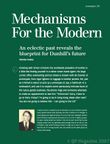
|

|
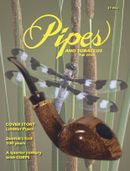
|
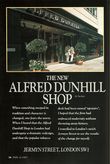
|

|
| Telegraph, 16 Aug 2003 here | QP Magazine 805, 2007 here | Magazine Partners, 1993 here | Pipes & Tobaccos, fall 2010 here | The worldwide Pipe Smoker's Magazine,1997 (Vol.6)here |
People, 1981 here |
Newspapers
A Brief Timeline
The genesis of the family business: the Dunhill ancestors were small farmers and shopkeepers in Nottinghamshire, Thomas Dunhill, being the first to take a break from this part of the country. He left Newark-on-Trent early in the last century, at about the time of Waterloo, bringing his young bride to London where, in Oxford Street, on the site now occupied by Debenham's, he opened a draper's shop. He must have quickly realized that the vast number of horses in the London Streets offered him a better livelihood than the linen trade: possibly, from his country boyhood, horses were something he knew about. At any rate, he transferred his energies to building up a harness-making business in the Euston Road which, before a tablet in Islington Church commemorated his long years'enterprise, enable him to support a household of Victorian proportions, including seven sons and five daughters. This was the first Dunhill business of any consequence. Frederick Dunhill inherited it, passing it on to Henry Dunhill.
1861: Frederick Dunhill (1807-1876) was a sacking manufacturer; his youngest son (of 5), Henry (1842-1901) was a commercial clerk. In 1870 at Frederick's death, Henry was in business as a dealer in sacking and he added an extra dimension to his business by selling canvas tarpaulins and shop-blinds. He also later became a dealer in pianos and music. The sacking business was run from Euston Road, which also made, among other things, accessories for horse-drawn vehicles. And this is where Alfred Dunhill begins his historic journey:
1887: The third of Henry's son, Alfred, was apprenticed to his father's harness-making business.
1893: At the age of 21, Alfred Dunhill starts managing the business with his father.
1895: Alfred Dunhill married Alice Mary Stapleton.
1896: Alfred Henry Dunhill born; Locomotives on Highways Act passed.
1897: Henry Dunhill retired. Alfred Dunhill took over his father's business. A harness and motor accessory business opened at 145-147 Euston Road, London. Vernon Dunhill born.
1899: John ("Jack") Dunhill born.
1900: The Discount Motor Car Company (selling motor accessories by mail order) established at 145-147 Euston Road, and then expanded into 108 Euston Road, London.
1901: Henry, Alfred Dunhill's father, died. Motor Mart Employment Agency, which serviced and repaired motor cars then became "Motor Mart Ltd" - established at 108 Euston Road, London.
1902: In July, the first Dunhill's Motorities shop opened at 2 Conduit Street, London.
1902-6: Alfred Dunhill designed and built houses in Great Missenden, Buckinghamshire.
1903: Alfred Dunhill Ltd (the 'predecessor company') incorporated. Alfred Dunhill's first dashboard clock marks their entry into the timepiece arena
1904: Dunhill's Motorities shop opened at 5 Conduit Street. Head office, wholesale and export departments opened in new buildings at 359-361 Euston Road - London. Application for “Windshield Pipe” patent.
1905: Alfred Dunhill's Patent Development Company established at 8 Argyll Place, London. Dunhill's Motorities shops opened in Edinburgh, Manchester, within Hotel Cecil, London.
1906: Mary Dunhill born.
1907: First Dunhill tobacco shop opened (7 July or most likely, 9 or 10 September) on 31a Duke St. Late in the same year, My Mixture book was started.
1908: Dunhill's Motorities shop opened in Glasgow. Cigarette manufacturing by hand begins.
1909: Dunhill began an in-house pipe repair business.
1907-1910: Dunhill imported the bulk of his pipes from France. Unsatisfied with the quality of these, he also bought pipes from Charatan (1909/10) reportedly at exorbitant prices, to ensure he had some of the very best pipes for sale in England.
1910: First known Dunhill catalog produced; Alfred Dunhill enticed Joel Sasieni away from Charatan and opened a small pipe workshop of his own at 28 Duke St. -- two rooms upstairs providing the humble beginning. The focus was to use the finest quality briar, and expert craftsmanship to make pipes that would provide a superior smoke, and last a lifetime. The cost would reflect these principals, which was against the current trend of inexpensive pipes of lessor quality; the Bruyere finish is first introduced.
1912: Alfred Dunhill becomes Alfred Dunhill Ltd; Herbert Edward Dunhill (1884-1950) joined his brother in the business; The "White Spot" trademark first appeared on pipes. The famous white spot was introduced so customers would know which way to insert the handmade vulcanite mouthpieces on straight pipes (the spots face up). Pipe-making moved to Mason's Yard, London.
1913: Vernon Dunhill (father of Richard Dunhill) joined the business.
1914: First World War begins; Alfred Henry Dunhill leaves the business and joins the war effort.
1916: Shop address becomes 30 Duke Street; factory and offices purchased in Notting Hill Gate, London (the pipe-making operations are transferred there);
1917: Shell Briar pipe patented; Alfred Dunhill created his sandblasted pipe, and first introduced the "Shell" Finish. Dunhill developed the oil curing process at this time, which many feels contributes significantly to Dunhill's excellent smoking qualities.
1918: Alfred Henry Dunhill won the Military Cross (MC at Frégicourt 1 Sep 1918 - 31158/1 Feb 1919), 7th Bn Royal West Surrey Regiment - World War I.
1919: Alfred Henry Dunhill rejoined the business; factory and offices purchased at 20 Pancras Road, London; fire at Notting Hill Gate pipe factory; Dunhill and Sasieni part after serious conflicts. Dunhill stopped buying bowls turned in France in favor of those turned in London at Notting Hill Gate pipe factory.
1920: Wholesale and export departaments moved to Notting Hill Gate.
1921: Alfred Dunhill of London Inc. formed in New York; First registration of "Alfred Dunhill" signature as a trademark; First Royal Warrant received, as Tobacconist to Eduard, Prince of Wales. 276,000 pipes were sold in the Duke St. Shop. Dunhill formally instituted a one-year pipe guarantee (the "White Dot Guarantee") and in conjunction with that guarantee a date code system to date the year a pipe was offered for sale.
1922: Alfred Dunhill of London Inc. formed in Toronto; first New York shop opened; The Parker Pipe Company Limited formed, to become a subsidiary of Alfred Dunhill Limited.
1923: Alfred Dunhill Limited formed, with an initial authorized share capital of £300,000 (Alfred and his brother Herbert served as directors); "White Spot" trademark registered; shop opened at 27b Throgmorton Street, London.
1924: Mary Dunhill joined the company; Société Anonyme Française Alfred Dunhill (SAFAD) formed; shop opened at 15 rue de la Paix, Paris; The Pipe Book by Alfred Dunhill published; Unique lighter introduced.
1926: Shop opened in Toronto; Mary Dunhill Limited Formed (shop opened in Bayswater); new cigar humidor room opened; watch lighter introduced; Richard Dunhill born.
1927: Herbert E. Dunhill last attended a board meeting, but remained managing director until 1950. Alfred Dunhill launches the revolutionary Unique lighter, the first to be operated using just one hand.
1928: Alfred Dunhill retires; Alfred Henry Dunhill succeeds him as chairman; first Dunhill clock introduced; Captive watch and Belt watch introduced. Alfred Dunhill begins distributing the Namiki pen company's maki-e lacquered pens.
1930: The Root finish is introduced. D.R. "dead root". Denotes Dunhill straight grain pipes. The Bruyere finish was used on these pipes through 1929; root finish was used thereafter. "D.R." stamped on the shank; leather factory opened in Notting Hill Gate; agreement signed with Namiki for the introduction of writing instruments.
1931: French and Canadian Dunhill companies purchased. | Root Briar finish was introduced.
1932: H. L. Savory & Co. Ltd purchased.
1933: Stationery introduced in USA.
1934: Registered office moved from 137 Notting Hill Gate to 30 Duke Street, St. James.
1935: Duke Street, St. James, shop extension commenced.
1936: Large shareholding in Hardcastle Pipes Ltd purchased after a ten-year relationship; the factory was in Walthamstow. The famous Facet timepiece, based on Alfred Dunhill's car head-lamp designs, is launched.
1938: Royal Warrant received from George VI; Vernon Dunhill, Richard Dunhill's father died. Dunhill bought Savory’s.
1941: Duke Street shop bombed; it was extended and rebuilt in the 1950s and recently renovated.
1943: Mary Dunhill appointed director.
1944: Alfred Dunhill Limited purchased Mary Dunhill limited; the business of Wise & Greenwood purchased.
1946: Parker Pipe purchased, Masta Patent Pipe Company; new pipe factory opened in Plaistow.
1948: Richard Dunhill joined the company.
1949: D.Rs are graded with ascending letters "A" to "J".
1950: Herbert E. Dunhill died, Mary Dunhill succeeded him as managing director. | DRs became associated with Root Briar finish, were stamped DRR.
1951: Shop opened in Beverly Hills, CA.
1952: The Tanshell finish is introduced. | The number/letter shape code has been introduced.
1953: Duke Street shop was finally completely rebuilt after being bombed in 1941.
1954: The Gentle Art of Smoking by Alfred H. Dunhill is published.
1955: Alfred H. Dunhill elected Master of The Worshipful Company of Tobacco, Pipe Makers, and Tobacco Blenders.
1956: Rollagas lighter introduced.
1957: New headquarters and shop opened on Duke Street, St. James, 50 years after the first shop opened; "Bill" Carter completed 50 years of service.
1959: Alfred Dunhill, the founder of Alfred Dunhill Limited, died on January 2. Bill Taylor starts working for Dunhill as a boy
1960: Shop opened in Philadelphia.
1961: Alfred Henry Dunhill retired as chairman; appointed president and succeeded as chairman by Mary Dunhill; Richard Dunhill appointed director; shop opened in San Francisco; Alfred Dunhill Tobacco Ltd formed (factory in Plaistow).
1963: Dunhill Toiletries Ltd formed; Royal Warrant received from Queen Elizabeth.
1965: Interest in the company acquired by Carreras Ltd; silk ties introduced.
1966: Shop opened in Hong Kong; Queen's Award for industry received for export achievement.
1967: Hardcastle is merged with Parker and becomes Parker-Hardcastle Ltd; Alfred Dunhill of London Inc., New York, acquired from Dunhill International Inc. Carreras Ltd (now Rothmans International) purchased 50% of the Dunhill capital from the company and from members of the family and three of their directors joined the Dunhill board.
1968: Hong Kong company formed; shop opened in Sydney; controlling interest in Molyneux purchased (sold in 1970); shop opened in Düsseldorf, West Germany.
1970: Shop opened in Kuala Lumpur
1971: Alfred Henry Dunhill died; shop opened in Singapore.
1972: Carreras renamed Rothmans International; the Redbark finish is introduced. (Pipedia Sysop note: Some sources indicate the Redbark was introduced in 1973 while other sources indicate the Redbark was introduced 1972 See example).
1973: Controlling interested in Richards & Appleby Ltd purchased; first Dunhill International Conference in London.
1974: Mary Dunhill celebrated 50 years of service to the company; shop opened in Dallas, TX; Queen's Award for industry received for export achievement; Anthony Greener appointed as a managing director. | D.R. first stars appeared, but for group size.
1975: Mary Dunhill retired as chairman; Richard Dunhill succeeded her; Mary Dunhill appointed president;
1976: H. Simmons Ltd, London, purchased; menswear department opened on lower ground floor at Duke Street, St. James; Brentford Distribution Centre opened; Lane, Ltd., New York, purchased together with subsidiaries F. Charatan, Ben Wade, and Grosvenor Pipe. {Dunhill allowed Holm, Preben to use the Ben Wade name until his death in 1989. Almost a decade passed before John Louis Duncan bought the name from Dunhill and relaunched the brand while still using the Dunhill factory at Walthamstow. The Ben Wade brand was subsequently sold to Mr Peter Wilson, in 1998 (John Duncan, a grandson of the founder John Louis Duncan, sold the firm to his brother-in-law Peter Wilson). The Lane, Ltd. was sold to the Scandinavian Tobacco Group in 1987. The Richemont group continue with manufacturing and selling the Charatan pipe brand nowadays (Dunhill and Charatan are still under the umbrella of them)}. | The number/letter shape code was discontinued and replaced by a 4 or 5 digits code.
1977: Shop opened in Houston, TX; controlling interest in Montblanc-Simplo GmbH, West Germany, purchased; Dunhill pipes Ltd formed; Bill Taylor works as administrator and overseer in the Dunhill Factory.
1978: Shop opened in Atlanta, GA; temporary controlling interest in Collingwood of Conduit ltd; Mary Dunhill retired from the board of Dunhill Toiletries Ltd. | Collector Series was introduced (001 nomenclature) | D.R last year using stars for group size and letters for the grade. Dunhill started again to hand-turn (HT) bowls (Collector and D.R series only).
1979: Our Family Business by Mary Dunhill published; shop opened in Washington D.C. | Collector Series were stamped "002", and after 1979 this special stamp was dropped. D.R. series are graded with stars and also an “XL” stamp was added.
1980: First Dunhill Pipe Dealer's World Conference, in London; the Cumberland finish is introduced; shop opened in Dubai; sponsorship of Alfred Dunhill Queen's Cup polo tournament commenced.
1981: Shops-within-shops opened in Selfridges and Harrods, London; shop opened in Munich; tobacco manufacturing moved from Sewell Street to Murray Sons & Co. Ltd, Belfast; Dunhill Tobacco Ltd sold; Alfred Dunhill eyewear introduced.
1982: Dunhill Holdings plc acquired Alfred Dunhill Limited under Scheme of Arrangement; Rothmans International plc controlled new holdings company; pipe manufacturing transferred to Walthamstow; shop opened in Melbourne; Alfred Dunhill Scotch Whisky introduced; shop opened at 14 Poultry, London.
1983: Shop opened in Vancouver.
1984: Edition of men's grooming products introduced; Bill Taylor leaves Dunhill to become Bill Ashton-Taylor | The 5 digit shape numbers ended[30].
1985: Inauguration of Alfred Dunhill Cup golf tournament; Dunhill Tailored Clothes Inc, New York purchased.
1986: Shop opened in Montreal.
1987: Redbark finish officially retired; shops opened at QE2 in Sloane Street, London; redesigned Duke Street shop opened.
1988: Mary Dunhill died; The Englishman's Companion: Alfred Dunhill Exhibition in London.
1989: Richard Dunhill appointed chairman; Michael Nicholson appointed managing director; shops opened in Costa Mesa, Honolulu, Tokyo, Osaka, and Wall Street.
1990: New York shop relocated to 450 Park Avenue; shop opened in Hamburg; Alfred Dunhill Museum opened in Burlington Arcade, London.
1991: Lord Douro appointed chairman of Dunhill Holdings plc, succeeded Edmund Skepper; shops opened in Boston and Seattle.
1992: Shops opened in Geneva, Madrid, and San Diego; Alfred's Dunhill business completed one hundred years of trading.
1993: Alfred Dunhill celebrated it's Centennial worldwide; the Vendôme Luxury Group was created with Alfred Dunhill Ltd and Montblanc-Simplo GmbH as two of its principal subsidiaries; all tobacco interests sold to Rothmans International plc; the centenary watch range was introduced, inspired by Alfred Dunhill's watches of the 1930s; Alfred Dunhill opened its first store in China; the Alfred Dunhill Shooting Season was held in some of Europe's most prestigious locations; Alfred Dunhill Open Golf Championship held in Knokke-le-Zoute, Belgium; François Poirel appointed managing director.
1994: New store openings in Europe and Asia brought the total number of Alfred Dunhill stores to 96; Alfred Dunhill collection of humidors launched.
1995: New retail outlets were established in Taiwan and distribution strengthened throughout the rest of the Pacific Region; Namiki lacquer writing instruments which originally appeared in the 1920s were reintroduced as a limited edition to considerable interest from collectors. | The pipes logo was changed: "Dunhill" inside an ellipse.
1996: First Alfred Dunhill outlet opened in Russia and a new store opened in the city of London; Alfred Dunhill's headquarters relocated to 27 Knightsbridge in London.
1997: Flagship store in Duke Street, London, refurbished and relaunched at 48 Jermyn Street incorporating the Alfred Dunhill Museum which is opened to the public for the first time; partnership with Aston Martin to design the limited edition Alfred Dunhill DB7 sports car; Callum Barton appointed chief executive.
1998: Richard Dunhill celebrated 50 years with the company; Alfred Dunhill Museum acquired the last surviving Alfred Dunhill motor car, the "Tweenie", first sold in 1914 by Dunhill Motorities; Alfred Dunhill opened in the Czech Republic with stores in Prague and Carlsbad; 14th Alfred Dunhill store in China opened; Alfred Dunhill's largest store in Asia opened in Osaka, Japan; new stores opened in Bombay and New Delhi, India and Kuala Lumpur, Malaysia; number of stores stands at 160 in 26 countries. Alfred Dunhill Edition Aston Martin DB7 – 78 (of an announced 150) "Dunhill Silver platinum metallic" cars with a built-in humidor.
2005: Dunhill suspends the sale of tobacco-related products in its shops. Savile Row tailor Richard James, watch dealer/designer Tom Bolt, casual-wear designer Nick Ashley, and leather-smith Bill Amberg are brought on board to help revitalize the brand.
2007: First Home of Alfred Dunhill opens in Tokyo, Japan.
2008: Alfred Dunhill announces the appointment of menswear designer Kim Jones as Creative Director, a role Alfred Dunhill has not offered before. Second Home of Alfred Dunhill opens in London, UK, in Bourdon House. Third Home of Alfred Dunhill opens in Shanghai, China, in The Twin Villas.
2010: Fourth Home of Alfred Dunhill opens in Hong Kong, China, in Prince's Landmark.
2011: First Voice campaign launched.
2012: The pipes logo was changed to: "Alfred Dunhill's The White Spot" - March. Trafalgar by Alfred Dunhill is presented in Shanghai, China. For The Love film is released.
2016: Richard Dunhill died on Aug. 26, 2016, at the age of 89, having been a Dunhill employee for 68 years.
2018: Dunhill announced that it would no longer sell or market cigars and pipe tobaccos.
2019: STG acquires the rights to reintroduces the old Dunhill blends under the Peterson brand umbrella, STG-Lane Ltd.
Note: Some of this information were extracted from One Hundred Years and More. [82]
Pipedia in Press
The Nordic Smoker's Guild (NSG) in his last publication of the year, (December 2019 - its a quarterly publication), the "Piper & Tobak" (a Danish magazine) No. 165, did mention the work that is developed on this page.
Many people already know about www.pipedia.org, where all kinds of information about pipes are available. Some information needs a critical approach, but most often it is an excellent source of knowledge. If you are interested in Dunhill, a lot of new material has emerged thanks to a very enthusiastic young Brazilian named Yang Forcióri. Among other things, he has provided a lot of articles by the late John C. Loring, who was named the leading Dunhill authority.
Our compliments to the editor, Mr. Carsten Andersen. "Relax with your pipe!" Tak!
Contact Information
If you have something to add or suggest, please contact us:
S.E.THILE Handmade Pipes E-mail: mailto:sethile.pipes@gmail.com
Yang Forcióri Brasília, Distrito Federal - Brazil E-mail: mailto:yang@forciori.com.br
Alfred Dunhill Manufacturing Limited Official site: http://www.whitespot.co.uk/ 32 St Andrews Road, London E17 6BQ; Telephone: +44 (0)20 8498 4000; Fax: +44 (020) 8498 4077; Email: mailto:adpl@dunhill.com
White Spot Customer Service Department (repairs and spare parts): mailto:charlene.boakye@dunhill.com
mailto:kris.andersen@dunhill.com
mailto:alia.rana@dunhill.com
Our Contributors
Antony Cook. Arno van Goor. Ben Rapaport. Bruno de Figueiredo. Carsten Andersen. Doug Valitchka. Fawzi Bakeer. Fred Hanna. Guy Lesser. Jean-Christophe Bienfait. Jonathan Guss. Kalmon S. Hener. Leslie Wood. Luiz Leal. Michael DiCuccio. Scott Thile. Steve Snyder. Radek Jůza. Richard Esserman. Victor Naddeo.
Off site links
 Dunhill markings : Stampings pics from 1918 to now.
Dunhill markings : Stampings pics from 1918 to now.
Bibliography
Thanks to Ben Rapaport, who sent us the taking-off point for this Dunhill bibliography he titled The Dunhill Legacy. Ben is an excellent source of rare and out of print tobacco-related titles and can be reached by e-mail: ben70gray@gmail.com:
- Balfour, Michael, Alfred Dunhill, One Hundred Years and More (Weidenfield and Nicolson, London, 1992)
- Blei, Davide, and Bottoni, Luciano, The Dunhill Petrol Lighter: A Unique Story (2004)
- Dunhill, Alfred
- The Pipe Book (1924; 1969 and later reprints)
- The Gentle Art of Smoking (1954, 1961 New Edition, 1968 and later reprints)
- The Story of Dunhill's, 1907-1957
- The Story of Dunhill’s, 1907–1970
- Dunhill Ltd., Pleasures of the Pipe (1967)
- Dunhill Ltd., 1928 catalog, about Smoke, An Encyclopedia of Smoking. A facsimile is available through BriarBooks Press
- Dunhill, Mary, Our Family Business (1979)
- Foulkes, Nick, Dunhill by Design: A Very English Story (Flammarion, Paris, 2005)
- Hutt, Julia, and Overbury, Stephen, Namiki: Alfred Dunhill Namiki. The Art of Japanese Lacquer Pens (Pens Unlimited, 2000)
- Loring, J. C.,
- The Dunhill Briar Pipe, The Patent Years and After (self-published, Chicago, 1998)
- Dunhill Catalogs.
- Vol. I. The Early Years, 1910–1926
- Vol. II. The Elegant Years, 1927–1935
- Vol. III. The Later Years, 1936–1962
- Vol. IV. Dunhill Catalogs & Patents. An Addendum (self-published, Chicago, 1999)
Note: If you know of Dunhill related publications that should be included, please add them here, or send them to sethile.pipes@gmail.com, and we can add them for you.
References
- ↑ Dunhill (1928). About Smoke, An Encyclopaedia of Smoking (pp. 2-3). London, Messrs. A. & C. Black, Ltd.
- ↑ Rich, Tim. Vol. 2 (2nd Semester 1993). The Worldwide Pipe Smoker's Magazine (p. 43) [PDF version]. The Netherlands: Magazine Partners[1].
- ↑ Eliane Georges, Gala (29 mai 2007). La saga Dunhill - les trésors d'une grande maison [PDF version]. France: Prisma Média (G+J Network)[2](Fr) & [3](En)
- ↑ Uptown’s, Smoke Shop (2005). Collector’s Highlight - Spotlight on Edsel James (slightly adapted text. See original here).
- ↑ Dunhill, Mary (1979). Our Family Business (p.16). Great Britain, The Bodley Head.
- ↑ The New York Times (5 January 1959 - Part 3). "Alfred Dunhill, 86, tobacconist, dead". NYTimes
- ↑ Balfour, Michael. (1992). Alfred Dunhill, One Hundred Years and More (p.40). London, Weidenfield and Nicolson.
- ↑ Balfour, Michael. (1992). Alfred Dunhill, One Hundred Years and More (p.30). London, Weidenfield and Nicolson.
- ↑ Dunhill, Mary (1979). Our Family Business (p. 9). Great Britain, The Bodley Head.
- ↑ Man - Vol. 25 (May, 1925). The Pipe Book by Alfred Dunhill (pp. 78-79). Great Britain and Ireland. Royal Anthropological Institute.
- ↑ The New York Times (23 November 1924). "Books and Authors".
- ↑ Dunhill, Alfred. The Pipe Book - Foreword (1969, Revised Edition). London: Arthur Barker Limited.
- ↑ 13.0 13.1 The Observer (7 April 1929). "Alfred Dunhill, Ltd" (p. 3)[4]
- ↑ The Times (January 5, 1959). Mr. A. Dunhill, Pipes for the Smoker - Obituary (p. 10)[5].
- ↑ Trompeter, Barbara. "Dunhill, Alfred (1872–1959)". Oxford Dictionary of National Biography. Oxford University Press.
- ↑ Dunhill, Mary (1979). Our Family Business (p. 32). Great Britain, The Bodley Head.
- ↑ Fold3. World War I (1919). British Recipients of the Military Cross - Alfred Henry Dunhill Record[6].
- ↑ Dunhill, Mary (1979). Our Family Business (p. 35). Great Britain, The Bodley Head.
- ↑ London Gazette (1 February 1919). "2nd Lt. Alfred Henry Dunhill, R*. W. Surr. R. (Spec. Res.), attd. 7th Bn [PDF version].[7]
- ↑ 20.0 20.1 20.2 The Times - (July 9, 1971). Obituary - Mr Alfred Dunhill, Pipes, tobacco and cigars. (P. 34). London [8]
- ↑ Dunhill, Mary (1979). Our Family Business (pp. 86-87). Great Britain, The Bodley Head.
- ↑ Todd, Arthur E. Tobacco, (1st. February 1941). Tobacco Notables Interview No. 6 - The Story of the Dunhill Family.
- ↑ Dunhill, Alfred. (1969, later reprints). The Pipe Book - Foreword Alfred H. Dunhill. London. Arthur Barker Limited.
- ↑ Dunhill, A. H. (1954). The Gentle Art of Smoking., Introduction (p. xi). London: Max Reinhardt.
- ↑ 25.0 25.1 25.2 25.3 25.4 25.5 25.6 Smokingpipes (November 2006). A History of the Dunhill Brand. Retrieved 07:52, 27 February 2020 (CST) from smokingpipes.com
- ↑ Balfour, Michael. (1992). Alfred Dunhill, One Hundred Years and More (pp. 13-14). London, Weidenfield and Nicolson.
- ↑ 27.0 27.1 27.2 Burgess, David. Telegraph (16 Aug 2003). Weird and Wonderful. UK: Telegraph Media Group.[9]
- ↑ Dunhill, Mary (1979). Our Family Business (p. 18). Great Britain, The Bodley Head.
- ↑ 29.0 29.1 Dunhill, Mary (1979). Our Family Business (p. 19). Great Britain, The Bodley Head.
- ↑ Foulkes, Nicholas. QP Magazine (2007). Mechanisms For the Modern (p. 61). UK: National Magazine Company Ltd.
- ↑ Rich, Tim. Vol. 2 (2nd Semester 1993). The Worldwide Pipe Smoker's Magazine (p. 41) [PDF version]. The Netherlands: Magazine Partners[10].
- ↑ 32.00 32.01 32.02 32.03 32.04 32.05 32.06 32.07 32.08 32.09 32.10 32.11 32.12 32.13 32.14 32.15 32.16 Hener, K. S. Product Line Director - The White Spot Smoker's Accessory Division and Walthamstow site. (Conversations held between 2019 and 2020).
- ↑ Loring, J. C. (1998) The Dunhill Briar Pipe - The Patent Years and After (p.1). Chicago: self-published.
- ↑ Dunhill, Mary (1979). Our Family Business (pp. 20-21). Great Britain, The Bodley Head.
- ↑ Dunhill, Mary (1979). Our Family Business (p. 20). Great Britain, The Bodley Head.
- ↑ Balfour, Michael. (1992). Alfred Dunhill, One Hundred Years and More (p.39). London, Weidenfield and Nicolson.
- ↑ Balfour, Michael. (1992). Alfred Dunhill, One Hundred Years, and More (p.44). London, Weidenfield and Nicolson.
- ↑ 38.0 38.1 38.2 38.3 38.4 38.5 38.6 38.7 Loring, J. C. ('90s). Dunhill Pipe Tobacco: 1907 – 1990. Chicago: Loring Page [11]
- ↑ Balfour, Michael. (1992). Alfred Dunhill, One Hundred Years and More (p.40). London, Weidenfield and Nicolson.
- ↑ 40.0 40.1 40.2 Balfour, Michael. (1992). Alfred Dunhill, One Hundred Years and More (p.49). London, Weidenfield and Nicolson.
- ↑ 41.0 41.1 Rich, Tim. Vol. 2 (2nd Semester 1993). The Worldwide Pipe Smoker's Magazine (p. 43) [PDF version]. The Netherlands: Magazine Partners[12].
- ↑ Balfour, Michael. (1992). Alfred Dunhill, One Hundred Years and More (pp.47-48). London, Weidenfield and Nicolson.
- ↑ Balfour, Michael. (1992). Alfred Dunhill, One Hundred Years and More (p.150). London, Weidenfield and Nicolson.
- ↑ The Dunhill Medical Trust. Our History. Retrieved 2 March 2020 (CST) from Dunhill Medical Trust
- ↑ Dunhill, Mary (1979). Our Family Business (pp. 24-25). Great Britain, The Bodley Head.
- ↑ Loring, J. C. (1998) The Dunhill Briar Pipe - The Patent Years and After, The Beginnings (pp. 5-6). Chicago: self-published.
- ↑ 47.0 47.1 Balfour, Michael. (1992). Alfred Dunhill, One Hundred Years and More (p.66). London, Weidenfield and Nicolson.
- ↑ 48.0 48.1 48.2 Sheffield Daily Telegraph (March 11 1920). Mr Dunhill's Action Against Wolf Brothers. England: Johnston Press[13]
- ↑ Cigarfan (2015). Cigar Reviews - Dunhill Heritage Robusto. Retrieved 2 March 2020 from Cigarfan
- ↑ 50.0 50.1 Dunhill, Mary (1979). Our Family Business (p. 67). Great Britain, The Bodley Head.
- ↑ 51.0 51.1 Loring, J. C. (1998) The Dunhill Briar Pipe - The Patent Years and After (p. 47). Chicago: self-published.
- ↑ 52.0 52.1 Balfour, Michael. (1992). Alfred Dunhill, One Hundred Years and More (p.68). London, Weidenfield and Nicolson.
- ↑ Balfour, Michael. (1992). Alfred Dunhill, One Hundred Years and More (pp.76-77). London, Weidenfield and Nicolson.
- ↑ McGinty, Stephen. (2007). Churchill's Cigars, (pp.66-67). London, Pan Books.
- ↑ Balfour, Michael. (1992). Alfred Dunhill, One Hundred Years and More (p. 103). London, Weidenfield and Nicolson.
- ↑ 56.0 56.1 56.2 56.3 56.4 Balfour, Michael. (1992). Alfred Dunhill, One Hundred Years and More, Introduction (pp.7-11). London, Weidenfield and Nicolson.
- ↑ Tariff Readjustment - Dunhill (February 1929). The United States. Congress. House. Committee on Ways and Means. (PP. 7956-59). U.S. Government Printing Office.
- ↑ Balfour, Michael. (1992). Alfred Dunhill, One Hundred Years and More (pp.132-137). London, Weidenfield and Nicolson.
- ↑ Loring, J. C. (1998) The Dunhill Briar Pipe - The Patent Years and After (p. 41). Chicago: self-published.
- ↑ Loring, J. C. ('90s). The Early Dunhill OD - Chicago: Loring Page [14]
- ↑ Hauptfuhrer, Fred. (1981). People, For London's Richard Dunhill, Life's a Lovely Pipe Dream". US: Meredith Corporation. Retrieved 3 March 2020 from People Archive
- ↑ 62.0 62.1 62.2 Richemont History, including Significant Investments and Divestments Retrieved 06 February 2020 from Richemont
- ↑ Fundinguniverse (1998). Rothmans UK Holdings Limited History. Retrieved 06 March 2020 from fundinguniverse.com
- ↑ Balfour, Michael. (1992). Alfred Dunhill, One Hundred Years and More (pp. 176-178). London: Weidenfield and Nicolson.
- ↑ Ferrara, Fabio (2000). La datazione delle CHARATAN. Retrieved 08 April 2020 from digilander.libero.it
- ↑ The Pipes Magazine Radio Show – Episode 178 and 225. Ken Barnes on Radio Show. February 9, 2016 and January 3, 2017. Retrieved 08 April 2020 from pipesmagazine.com
- ↑ Pipedia, Charatan - Milan 2014. Retrieved from [15]
- ↑ 68.0 68.1 Loring, J. C. (1998) The Dunhill Briar Pipe - The Patent Years and After, The Beginnings (pp. 2-3). Chicago: self-published
- ↑ 69.0 69.1 69.2 Balfour, Michael. (1992). Alfred Dunhill, One Hundred Years and More (p.52). London: Weidenfield and Nicolson.
- ↑ 70.0 70.1 Dunhill, Mary (1979). Our Family Business (p. 39). Great Britain, The Bodley Head.
- ↑ Dunhill, Mary (1979). Our Family Business (p. 41). Great Britain, The Bodley Head.
- ↑ Rich, Tim. Vol. 2 (2nd Semester 1993). The Worldwide Pipe Smoker's Magazine (p. 38) [PDF version]. The Netherlands: Magazine Partners[16].
- ↑ 73.0 73.1 Dunhill, Mary (1979). Our Family Business (p. 42). Great Britain, The Bodley Head.
- ↑ Rich, Tim. Vol. 2 (2nd Semester 1993). The Worldwide Pipe Smoker's Magazine (pp. 38-39) [PDF version]. The Netherlands: Magazine Partners[17].
- ↑ Loring, J. C. (1998) The Dunhill Briar Pipe - The Patent Years and After, The Beginnings (pp. 4-5). Chicago: self-published.
- ↑ Fumeurs de Pipe (May 2006). Genèse et histoire de la société Adolph Frankau & Co Ltd. Retrieved March 2020 from fumeursdepipe.net.
- ↑ 77.0 77.1 Stephen A. Ross. Pipes and Tobaccos (Fall 2010), Vol. 15, No. 3. A century of excellence (pp. 9-10). USA: SpecComm International, Inc. P&T
- ↑ Felts, Chris. (July 2020). Dunhill smoker's products U.S distributor. (email conversations).
- ↑ 79.0 79.1 79.2 Esserman, Richard. (2019). About Dunhill - Facebook Talks.
- ↑ 80.0 80.1 80.2 Hanna, Fred. (2002), The Myth of Brand and Maker in Pipesmoking. Retrieved 19 March 2020 from The Great Northern Pipe Club.
- ↑ Edmund L. Andrews (1999). "International Business: British American Tobacco Will Buy Rothmans - New York Times". Retrieved 06 February 2020 from Nytimes.com.
- ↑ 82.0 82.1 82.2 Balfour, Michael. (1992). Alfred Dunhill, One Hundred Years and More (pp. 234-236). London, Weidenfield and Nicolson.
- ↑ Rich, Tim. Vol. 2 (2nd Semester 1993). The Worldwide Pipe Smoker's Magazine (p. 40) [PDF version]. The Netherlands: Magazine Partners[18].
- ↑ Loring, J. C. (1998) The Dunhill Briar Pipe - The Patent Years and After, The Beginnings (p. 22). Chicago: self-published.
- ↑ 85.0 85.1 R.D. Fields. (1983), Pipe Smoker - Fall '83. The Dunhill Pipe: a comparison of then and now. A Tail of Two Briars.
- ↑ Rapaport, Ben (2016). Pipes & Tobaccos magazine - Remembering Richard Dunhill. USA: SpecComm International, Inc.
- ↑ Dunhill, Mary (1979). Our Family Business (p. 43). Great Britain, The Bodley Head.
- ↑ 88.0 88.1 88.2 In The High Court of Justice - Chancery Division. REPORTS OF PATENT, DESIGN, AND TRADE MARK CASES [VOL. XXXIX. Dunhill v. Bartlett & Bickley (June and July, 1922) PP 426-443.[19]
- ↑ Loring, J. C. (1998) The Dunhill Briar Pipe - The Patent Years and After (p. 43). Chicago: self-published.
- ↑ The British Museum, BBC (2011). A History Of The World. Erinoid Plastic. Retrieved 24 March 2020 from BBC
- ↑ Hener, K. S. Product Line Director - The White Spot Smoker's Accessory Division and Walthamstow site. (e-mail in 1/13/2021)[20]
- ↑ Dunhill Ltd., 1928 catalog, about Smoke, An Encyclopedia of Smoking (p. 48). Briarbooks Press.
- ↑ 93.0 93.1 Loring, J. C. (1998) The Dunhill Briar Pipe - The Patent Years and After, The Beginnings (p. 8). Chicago: self-published.
- ↑ Loring, J. C. (1998) The Dunhill Briar Pipe - The Patent Years and After, The Beginnings (p. 60). Chicago: self-published.
- ↑ Russell, Francis (1968). The Shadow of Blooming Grove: Warren G. Harding In His Times. Easton Press. ISBN 0-07-054338-0.
- ↑ Loring, J. C. (1998) The Dunhill Briar Pipe - The Patent Years and After (p. 42). Chicago: self-published.
- ↑ Chuck Stanion. Smokingpipes, Pipe Line (August 27, 2019). New Old Shapes From Alfred Dunhill. Retrieved 5 April 2020 from smokingpipes.com
- ↑ 98.0 98.1 Dunhill, Mary (1979). Our Family Business (p. 69). Great Britain, The Bodley Head
- ↑ Paris 2e arrondissement Mémoire des rues; Auteur: Meryem Khouya; Éditeur: Parimagine, 2007.
- ↑ Loring, J. C. (1998) The Dunhill Briar Pipe - The Patent Years and After (pp. 14-17). Chicago: self-published.
- ↑ Loring, J. C. (1998) The Dunhill Briar Pipe - The Patent Years and After (p. 44). Chicago: self-published.
- ↑ Balfour, Michael. (1992). Alfred Dunhill, One Hundred Years and More (pp. 132-137). London: Weidenfield and Nicolson.
- ↑ Loring, J. C. ('90s). A Hypothetical WWII Pipe. Chicago[21].
- ↑ Balfour, Michael. (1992). Alfred Dunhill, One Hundred Years and More (p 48). London: Weidenfield and Nicolson.
- ↑ Balfour, Michael. (1992). Alfred Dunhill, One Hundred Years and More (p. 180). London: Weidenfield and Nicolson.
- ↑ Minato, Charlie (2017). Dunhill Plans Exit from Cigar and Pipe Business. Retrieved April 2020 from halfwheel.com
- ↑ Ross, A. Stephen. (2019). A Happy Return. Retrieved April 2020 from tobaccobusiness.com
- ↑ Goor, van Arno (2018). De Graaff tobacconist. Dutch Pipe Smoker, Retrieved April 2020 from dutchpipesmoker.com
- ↑ Harrald, Chris; Watkins, Fletcher (2010). The Cigarette Book: The History and Culture of Smoking. Skyhorse Publishing Inc.
- ↑ Loring, J. C. (1998) The Dunhill Briar Pipe - The Patent Years and After (p. 60). Chicago: self-published.
- ↑ Sotheby's Catalogue (September 1997). The Duke and Duchess of Windsor, "The Private Collections" & "The Public Collections". Published by Sotheby's. Provided by Guy Lesser.
- ↑ Loring, J. C. (1998) The Dunhill Briar Pipe - The Patent Years and After (p. 49). Chicago: self-published.
- ↑ 113.0 113.1 Loring, J. C. (1998) The Dunhill Briar Pipe - The Patent Years and After (pp. 48-49). Chicago: self-published.
- ↑ Foulkes, Nick (2005). Dunhill by Design: A Very English Story (p. 75). Flammarion, Paris.
- ↑ U.S. Government Printing Office, February 25, 1909. Report of Tobacco Industry (pp. 89, 269).
